Soil’s secret web of life
The biocrust soil layer could be key to reducing dust in the Southwest

20 YEARS OF CALIFORNIA INNOVATION
A STUDENT BODY THAT COULD How ASU became a university
27 Number 2
Volume
with your smartphone camera to view the digital edition.
ARIZONA STATE UNIVERSITY Scan

Contributors
May Busch
The former COO of Morgan Stanley Europe is now an executive coach, speaker, advisor, author and executivein-residence in ASU’s Office of the President.
Amanda Loudin
A journalist, her work has appeared in The New York Times, The Washington Post, Harvard Medicine and other national media outlets.
Tom Zoellner
A journalist, published author and a fifthgeneration Arizonan, Zoellner is the author of “Rim to River: Looking Into the Heart of Arizona.” A piece he wrote for The New York Times is reprinted in this issue of the magazine.
Camille Misty
An artist from Arizona currently pursuing a BFA in photography and a BS in anthropology, she has taken photos for the startup fashion brand Ribellé.
The official publication of Arizona State University
Spring 2024, Vol. 27, No. 2
CHIEF BRAND OFFICER, PUBLISHER
Jill Andrews �97 BS, �03 MPA
MANAGING DIRECTOR, EDITOR
Lindsay Kinkade
MANAGING EDITOR
Kari Redfield
SENIOR ART DIRECTOR
Heidi Easudes
DIRECTOR, ASU NEWS
Penny Walker DEPARTMENT EDITOR, COPY EDITOR
Leigh Farr
PHOTO COORDINATOR
Sabira Madady
DESIGNERS
Beatrice Guo, Tamara Kopper, Laura Kryger, Mark Munoz, Raini-Skye Rogers
PRODUCTION
Chris Myers, Jason Puckett, Zachary Leitzke
If you would like to update your mailing address or switch to the digital version: news.asu.edu/content/subscribe
STORY IDEAS AND ADVERTISING INQUIRIES asuthrive@asu.edu
ASU THRIVE MAGAZINE PO Box 875011, Tempe AZ 85287-5011 602-543-5234 asuthrive@asu.edu
news.asu.edu/thrive-magazine
ASU Thrive (USPS 024-438; ISSN 1940-2929) is published quarterly by Arizona State University Enterprise Brand Strategy and Management, PO Box 875011, Tempe, AZ 85287-5011, 480-727-5440. Subscriptions are sent to all ASU alumni. For detailed information about supporting alumni traditions, scholarships and programs, visit alumni.asu.edu/give-back/donate Periodicals postage is paid at Tempe, Arizona, and additional mailing offices. Postmaster: Please send address changes to ASU Thrive, Attention: Circulation, PO Box 875011, Tempe, AZ 85287-5011. Permissions: Portions of this publication may be reprinted with the written permission and proper attribution by contacting the ASU Thrive editor. ASU Thrive can be accessed online at news.asu.edu/
thrive-magazine
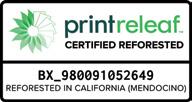
ASU Thrive is paper neutral, replanting trees equivalent to paper usage in geographic areas of need.
Advancing the New American University
In the 1950s, Arizona’s population was exploding with 50,000 new transplants per year moving to the desert to build better lives. Enrollment at what was then known as Arizona State College more than doubled in four years, growing from over 4,000 in 1954 to nearly 10,000 in 1958. With growth came change, and many Sun Devils saw the need to transition from a college to a full-fledged university.
Students, under the leadership and vision of then-school president Grady Gammage, mobilized a grassroots effort, first to get the name change on the ballot and then to win the hearts and minds of voters to ultimately claim victory in 1958. Arizona State College became Arizona State University.
The university’s evolution continues today. ASU has more than 170,000 students spread across four campuses in metro Phoenix and locations in Southern California and Washington, D.C., as well as online. We operate the largest engineering school in the country and have been repeatedly ranked No. 1 on more than 20 national and international lists of excellence in the last three years alone, including innovation, sustainability, global impact and transdisciplinary research.
This is all part of the New American University — a model for the American public research university that prioritizes access, excellence and impact. It’s a model that is reshaping education in Arizona, across the nation and around the world.
We must continue and even accelerate this work. Read this issue to see how we’re doing it, here in Arizona, in neighboring California and globally. Today’s knowledge economy demands more college-educated individuals with advanced skills than ever before. Our national security and prosperity, including the safeguarding of our democracy, depend on it.
Michael M. Crow
President, Arizona State University twitter michaelcrow linkedin michaelmcrow INSTAGRAM asuprescrow FACEBOOK presidentcrow
ASU THRIVE MAGAZINE 1 COVER: ANDY DELISLE/ASU WELCOME
Events
Calendar of events
Populate your agenda with upcoming event highlights on ASU’s campuses. Page 4
Research and news
Top 5 for inventions, patents, patent deals and startups. Page 12
Bringing medical devices to market faster. Page 13













C areer
Skills new managers need to master
5 key skills can help you adjust to your new position quickly.
Page 16
Lifelong learning opportunities. Page 18
ASU named top 20 in the U.S. in Time and Statista’s Best College for Future Leaders list. Page 19

Arts a nd media
The future of fashion
Fashion-engineering collaboration creates wearable tech for kids undergoing chemotherapy. Page 22
Honoring heritage
The designer behind the Suns uniforms. Page 26
‘Somebody, Somewhere’ star honed musical talent at ASU. Page 30

youtube.com/ASU
youtube.com/ASUathletics
linkedin.com/school/Arizona-State-University linkedin.com/company/asualumni
LEIGHT/ASU; COURTESY OF MIGUEL ANGEL GODOY
CHARLIE
ASU’s Miguel Angel Godoy designed the Phoenix Suns’ heritage uniforms.
ASU FIDM and engineering students collaborated on clothing for hospitalized kids.
instagram.com/ArizonaStateUniversity instagram.com/ASU_alumni instagram.com/SunDevilAthletics
2 SPRING 2024 FIND
Economy
Innovation in the Golden State
Our inclusive mission to help people succeed knows no state boundaries. Page 34
Grad uses theater background to fuel legal career in LA. Page 38
Arizona economic outlook for 2024. Page 39
Ecosystem
Don’t flee the Southwest just yet
Fifth-generation Arizona native sheds light on the Southwest’s water supply. Page 42
Soil’s secret web of life Biocrust could be key to reducing the Southwest’s dust. Page 48
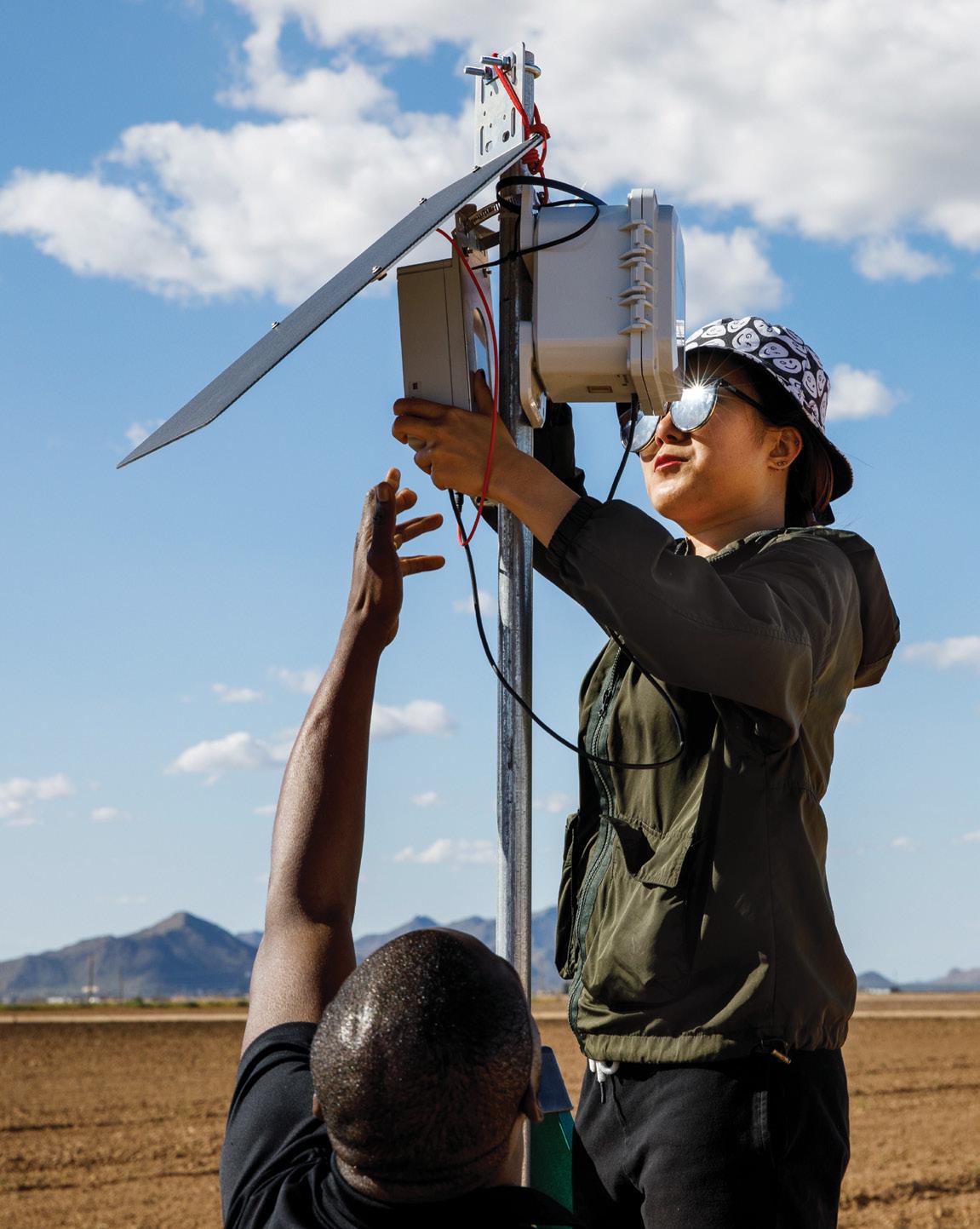


Testing solutions
History
54
S ports
Junior Murphy Cassone helped cinch Team USA’s victory. Page 60
Student-athletes’ academic success stats. Page 63
View
West Valley campus: 40 years of service and growth. Page 64
ANDY DELISLE/ASU; ASU LIBRARIES
The student body that could To become a university, ASU had to first win the hearts and minds of an entire state. Page
for creating thriving biocrust.
Students led the charge to make ASU a university.
Please visit magazine.asu.edu for the digital magazine with embedded videos and links.
threads.net/@arizonastateuniversity threads.net/@asu_alumni facebook.com/ArizonaStateUniversity facebook.com/ASUalumni facebook.com/ArizonaStateSunDevils BOOK-OPEN magazine.asu.edu pinterest.com/ArizonaStateUniversity ASU THRIVE MAGAZINE 3
Experience the ASU-led NASA Psyche mission in 3D.
Apr.
Weaving color and texture
Radiating bold orange and yellow hues, textile artist Sarah Zapata’s “Beneath the Breath of the Sun” exhibition evokes a vibrant topography of the Arizona landscape.
Wednesday–Sunday, now through July 24, 11 a.m.–5 p.m., ASU Art Museum, 51 E. 10th St., Tempe asuartmuseum.org
Free Family
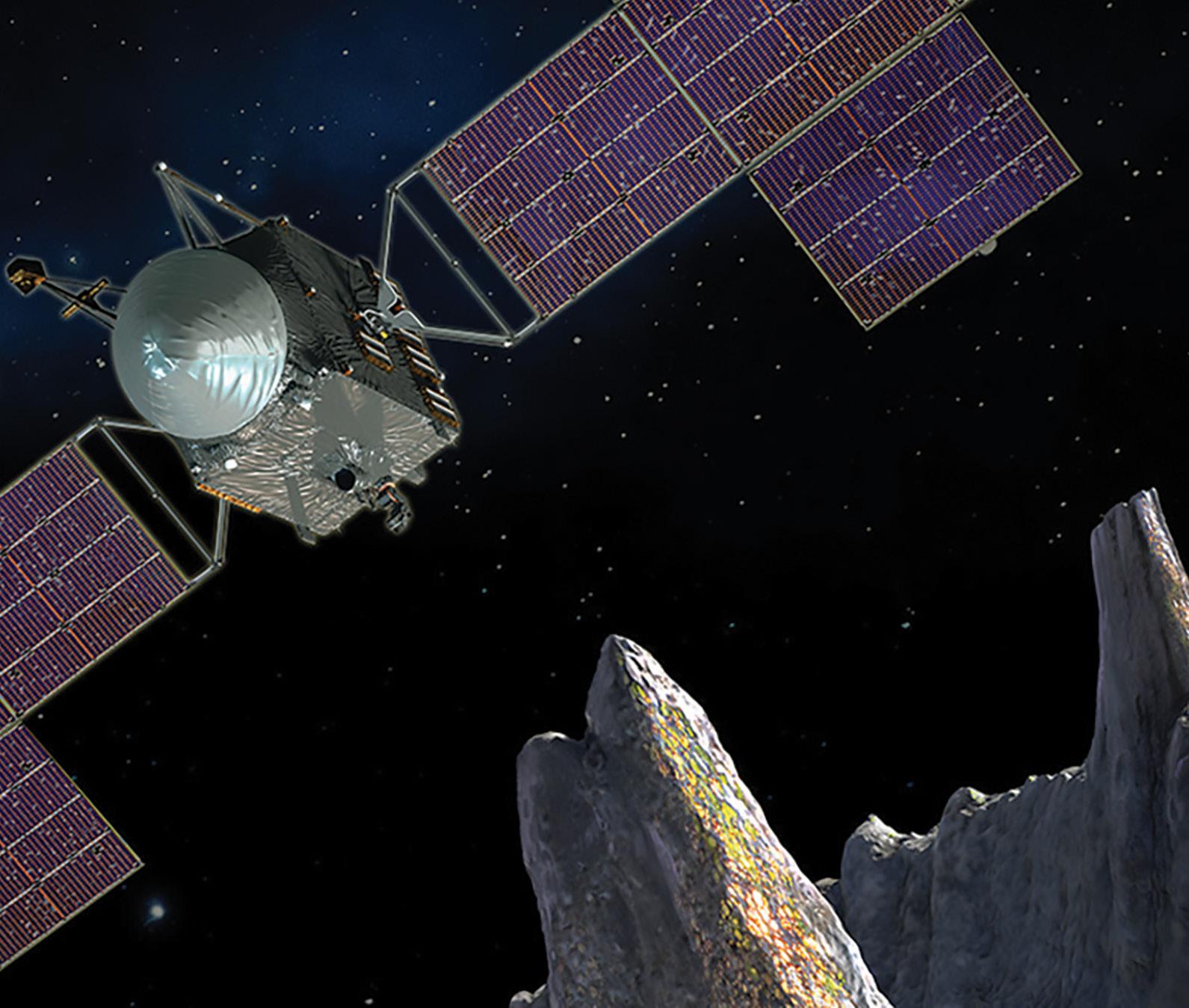
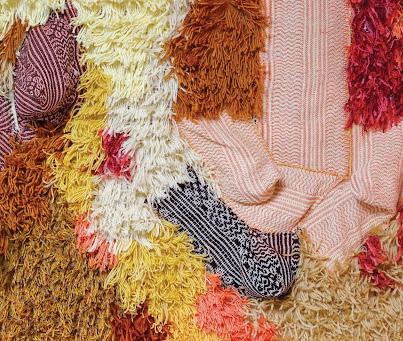
Sarah Zapata, detail of “Braided Topographies.”
Find your center through poetry
In time for National Poetry Month, experience the healing poems of Kelli Russell Agodon and Sati Mookherjee as they share a reading and conversation about life and art in times of global change and climate change.
Friday, April 12 at 7 p.m., Piper Writers House, 450 E. Tyler Mall, Tempe piper.asu.edu
Free Family
Journey through space in 3D
Embark on a voyage through the solar system and beyond with the School of Earth and Space Exploration’s 3D Astronomy Show “The Edge of Exploration: ASU Explores the Solar System.” Learn about new opportunities on the moon, material return missions from asteroids and Mars, gathering data from one of Jupiter’s moons, and the exploration of a metal-rich object in the asteroid belt.
Saturday, April 13, 1 p.m., SESE, Marston Theater, 781 E. Terrace Mall, Tempe campus sese.asu.edu/3d-astronomy
Family Ticketed
‘Barbie’ on the (very) big screen
Don’t miss this chance to see “Barbie” on the big screen under the stars. Bring a blanket, sit on the grass and watch this blockbuster with friends and family. Movies on the Field is open to ASU and the community.
Saturday, April 20, 7 p.m., Mountain America Stadium asu365communityunion.com
Free Family
Celebrate Earth Month
Each April, the world comes together to celebrate our home planet, Earth. Join the Julie Ann Wrigley Global Futures Laboratory for a month of hands-on activities to honor and sustain planet Earth. asuevents.asu.edu/sustainability
Free Family
4 SPRING 2024 ASU ART MUSEUM; NASA
EVENTS
Campus tours
Tour any or all of ASU’s campuses, including the ASU California Center. You’ll also join an ASU information session where you’ll learn some of the basics of ASU. visit.asu.edu
Free Family
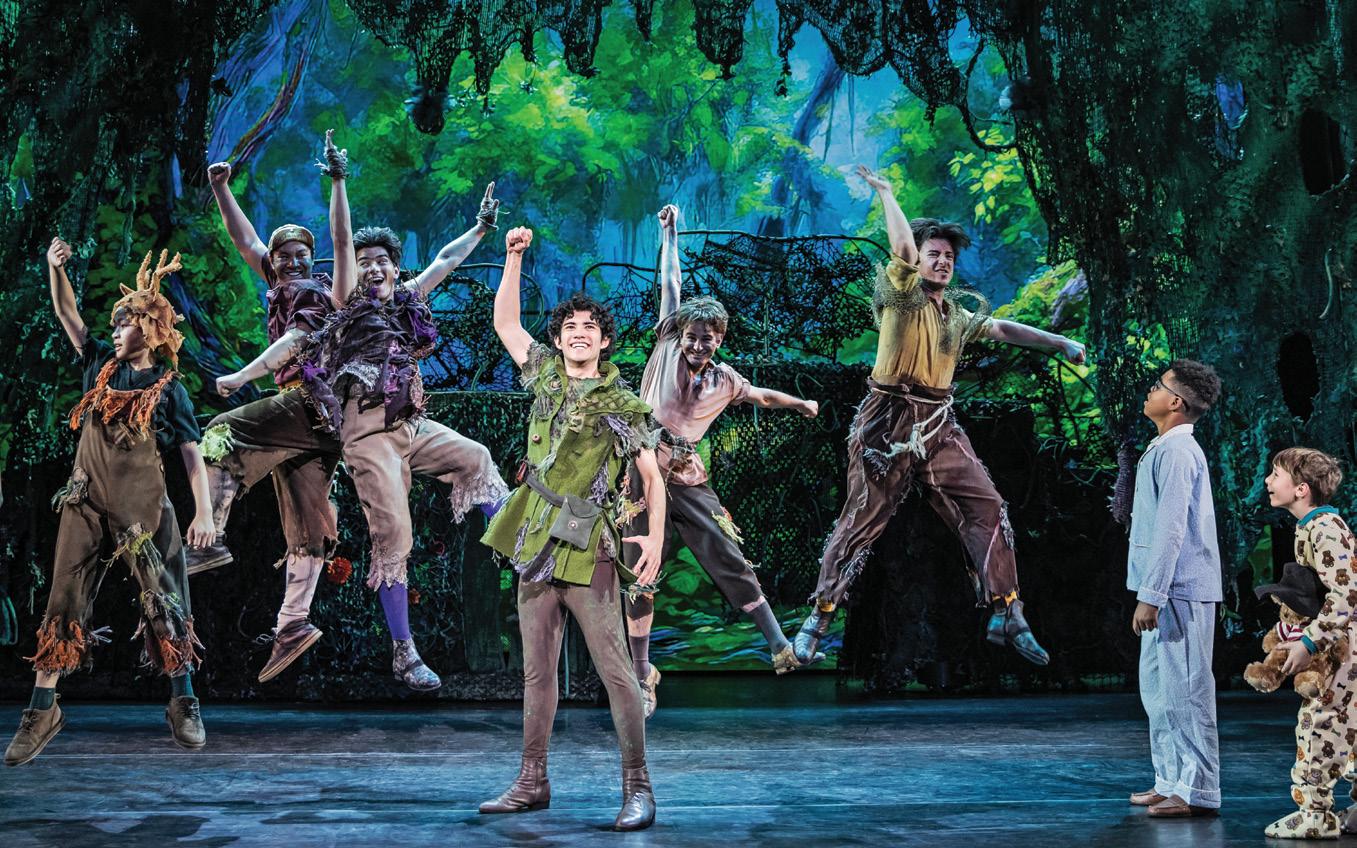
Pixie dust and happy thoughts
June
With the hit Broadway musical “Peter Pan” brought to life by playwright Larissa FastHorse in a brand-new adaptation, it’s time to go on a journey from the second star to the right and straight on till morning. The adventure begins when Peter Pan and his mischievous fairy sidekick, Tinker Bell, take the Darling children on a magical journey they will never forget. Guaranteed, your entire family will be hooked.
Tuesday, June 11–Sunday, June 16, ASU Gammage asugammage.com
Family Ticketed
Summer Camps
Engineering camp for high school juniors and seniors
Learn about the innovative programs offered at the Ira A. Fulton Schools of Engineering. Programs allow students to live on campus or take part in day camps.
June, Tempe campus outreach.engineering.asu. edu/fulton-academy
Ticketed Camp Grades 9–12
Programs for 9–12 learners
At Access ASU Summer Camps, grades 9–12 are invited to delve into career exploration, leadership and the humanities. Taught by renowned professors, these immersive residential programs take place on all four ASU campuses. Register by April 1.
June–July, all ASU campuses eoss.asu.edu/access/ programs/summer
Ticketed Camp Grades 9–12
Science and art at West Valley campus
A new Barrett Summer Scholars BioArt course will be offered to rising 11th graders on the West Valley campus. Participants will merge their artistic creativity with scientific thinking.
Monday, July 8–Thursday, July 11, West Valley campus eoss.asu.edu/bss/ssp/apply
Ticketed Camp Grade 11
Sun Devil Rewards has an updated look, new games and more rewards!
Found in the ASU Mobile App, play Sun Devil Sudoku, crosswords and other favorites for more of those shiny gold ’Forks. sundevilrewards. asu.edu
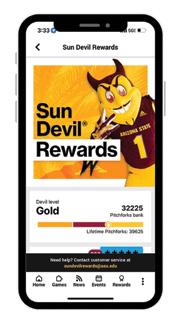
See asuevents. asu.edu for additional ASU events.
Visit thesundevils. com for athletics.
ASU THRIVE MAGAZINE 5
MATTHEW MURPHY
ECONOMIC POWERHOUSE
Boosting semiconductor manufacturing in Arizona
A new partnership with NXP Semiconductors will advance Arizona’s semiconductor manufacturing industry.
Fueled by the support of the Arizona Commerce Authority and in partnership with NXP, ASU has received $17.5 million to expand Arizona’s packaging research and development and workforce training capabilities. It will enhance Arizona’s fan-out, wafer-level packaging capabilities, and drive the creation of a GaN (gallium nitride) manufacturing and research ecosystem in Arizona.
ASU will use the funding to purchase equipment to enhance the capabilities of ASU’s MacroTechnology Works in Tempe.
NXP is the second-biggest supplier of chips to the automotive industry.
Learn more at neweconomy.asu.edu .
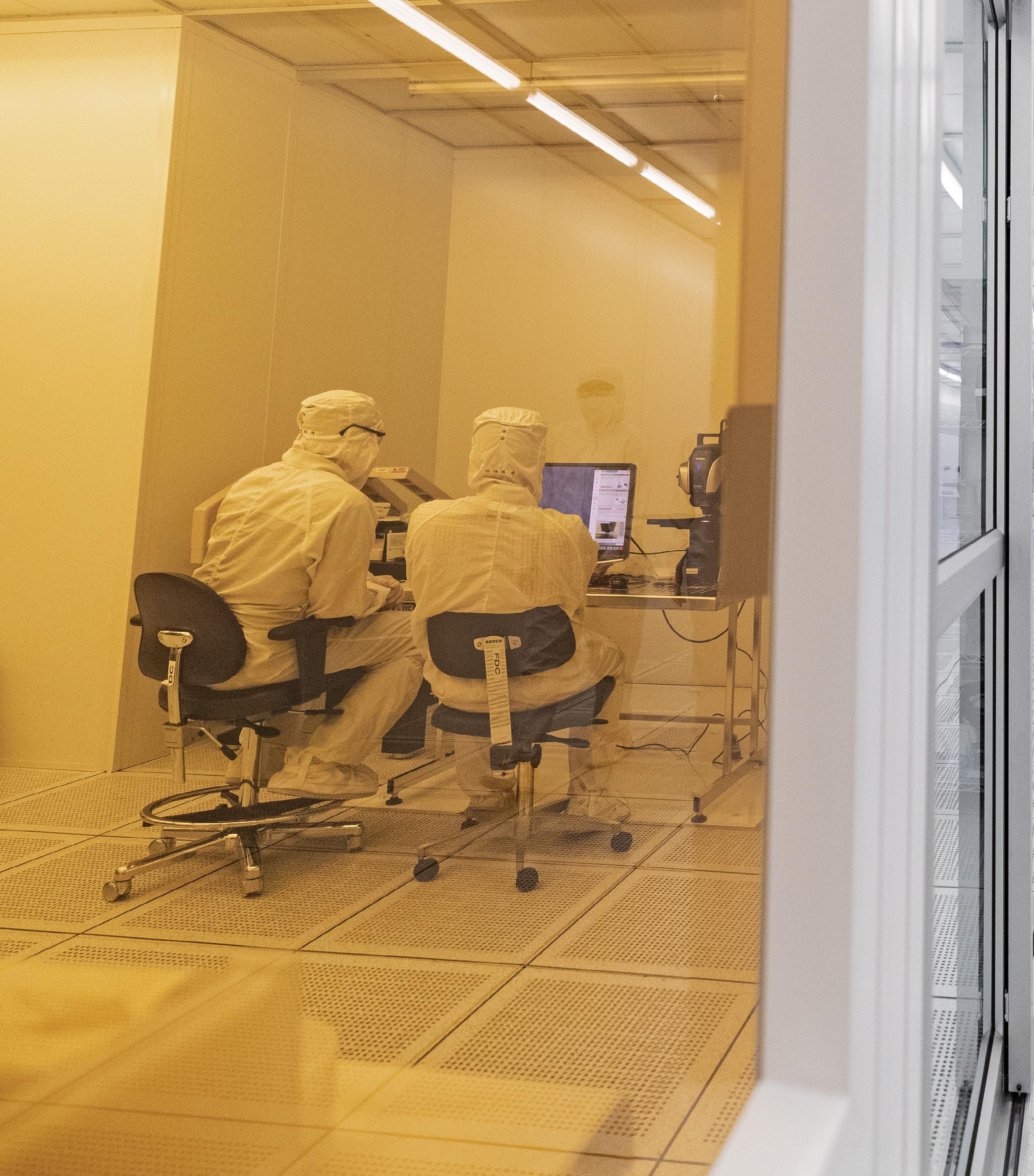
6 SPRING 2024
“This partnership will drive innovation in 6G, taking lab concepts through joint research to full-scale manufacturing.”
JIM NORLING, ’94 BS MARKETING, VICE PRESIDENT OF PRODUCT MANAGEMENT, RADIO POWER,
AT NXP SEMICONDUCTORS
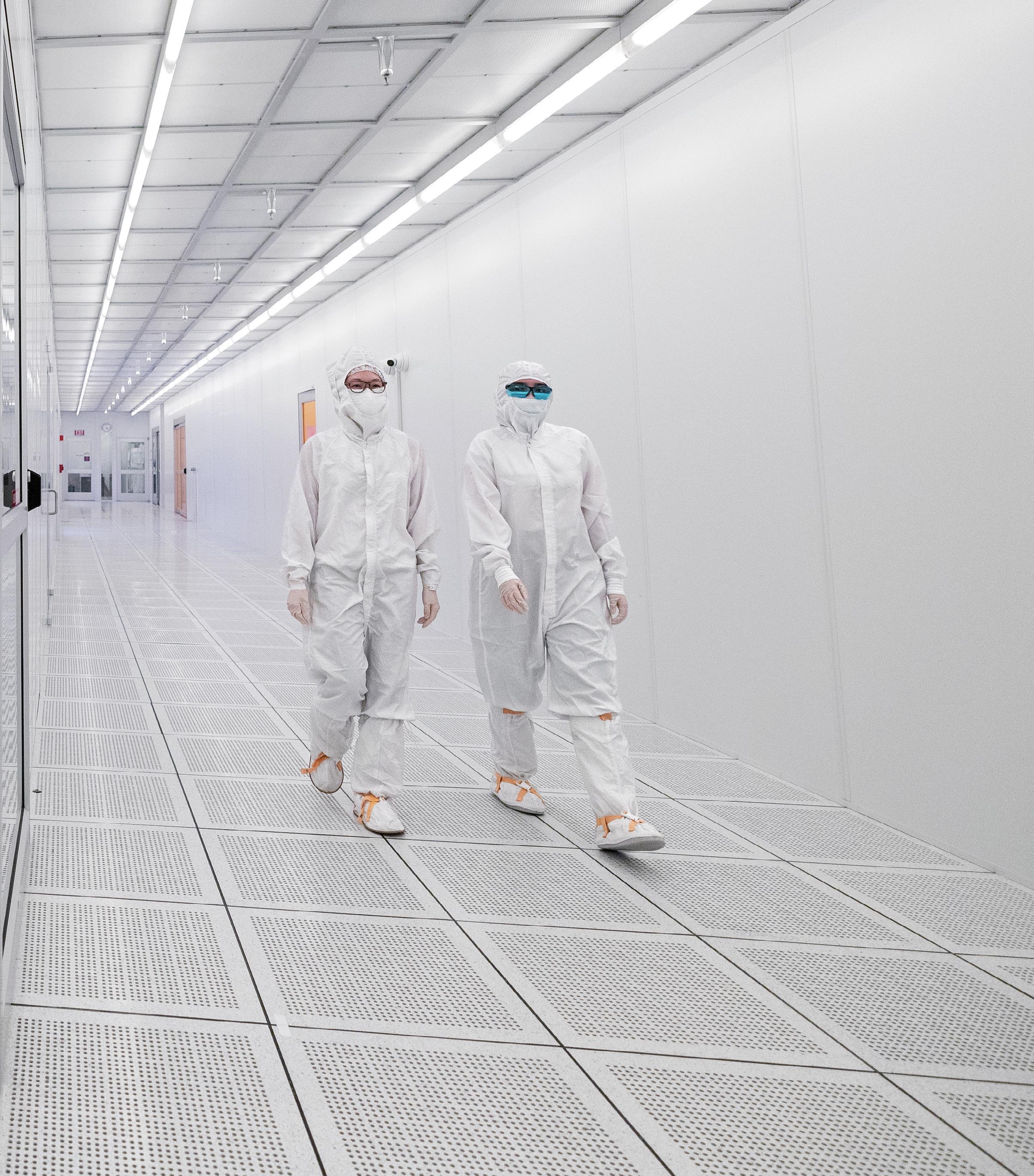
Research and news
ASU’s MacroTechnology Works is accelerating semiconductor, advanced materials and energy device research in the U.S. This unique resource combines the equipment, expertise and training necessary to develop new technology from proof of concept to pilot scale.
Top 5 for inventions, patents, patent deals and startups Page 12
Bringing medical devices to market faster Page 13
DEANNA DENT/ASU ASU THRIVE MAGAZINE 7

Tech demo on ASU-led NASA Psyche mission beams cat videos back to Earth
From nearly 19 million miles away from Earth, NASA’s Psyche asteroid orbiter completed a successful communications test using a near-infrared laser to transmit video of a cat chasing a laser.
The video, uploaded to the Psyche spacecraft before it launched, was sent back to Earth by NASA’s Deep Space Optical Communications technology demonstration.
The test is a milestone in NASA’s development of technology to stream highbandwidth video and other data from deep space.
The NASA Psyche mission is the first ASU-led deep-space mission and will explore an asteroid thought to be made largely of metal.
Watch Taters the cat in the video beamed from space at youtube.com/ arizonastateuniversity.
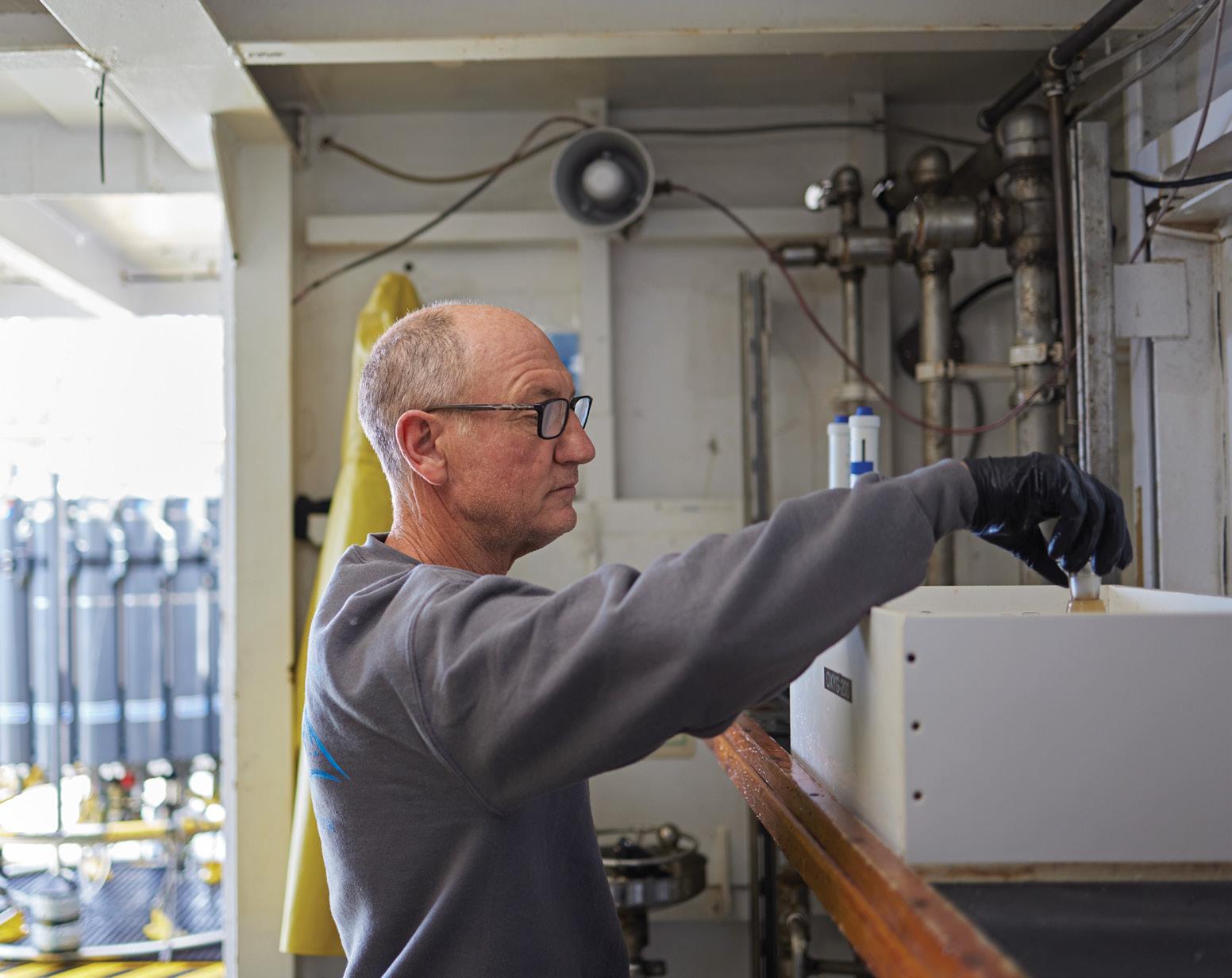
40-year study reveals threats of more acidic, warmer oceans
Forty years of observation in the Sargasso Sea around Bermuda by chemical oceanographer Nicholas Bates, director of research for ASU’s Bermuda Institute of Ocean Sciences, have revealed alarming changes. His results were published in December in Frontiers in Marine Science.
Conducted from 1983 to 2023, the study finds a rise in surface ocean temperature of about 1 degree Celsius (1.80 F), increases in acidity of 30% and salinity of 0.136 parts per thousand, and a 6% decrease in ocean oxygen. These changes, due to rising levels of atmospheric carbon dioxide, have the potential to disrupt the ocean food chain and result in the loss of fishing resources and inundation of coastal areas because of rising tides and less predictable weather patterns.
“Our oceans are undergoing a dramatic change due to humancaused global warming,” says Peter Schlosser, vice president and vice provost of Global Futures and director of the Julie Ann Wrigley Global Futures Laboratory. “[These findings] emphasize the urgency of taking immediate action to limit this warming.”
Learn more at bios.asu.edu .
“The present-day chemistry of Sargasso Sea surface waters is now completely different to 40 years ago.”
— NICHOLAS BATES, DIRECTOR OF RESEARCH, BERMUDA INSTITUTE OF OCEAN SCIENCES
Rod Johnson, ASU BIOS assistant scientist and associate research professor in the School of Ocean Futures, prepares dissolved oxygen seawater samples.
NASA; JEFF NEWTON 8 SPRING 2024 RESEARCH
“To be able to gather the information needed to help prosecute the criminals and educate the public makes this project a win-win.”
— LAUREN WEIDNER, LAB DIRECTOR OF THE FORENSIC ENTOMOLOGY AND WILDLIFE LABORATORY
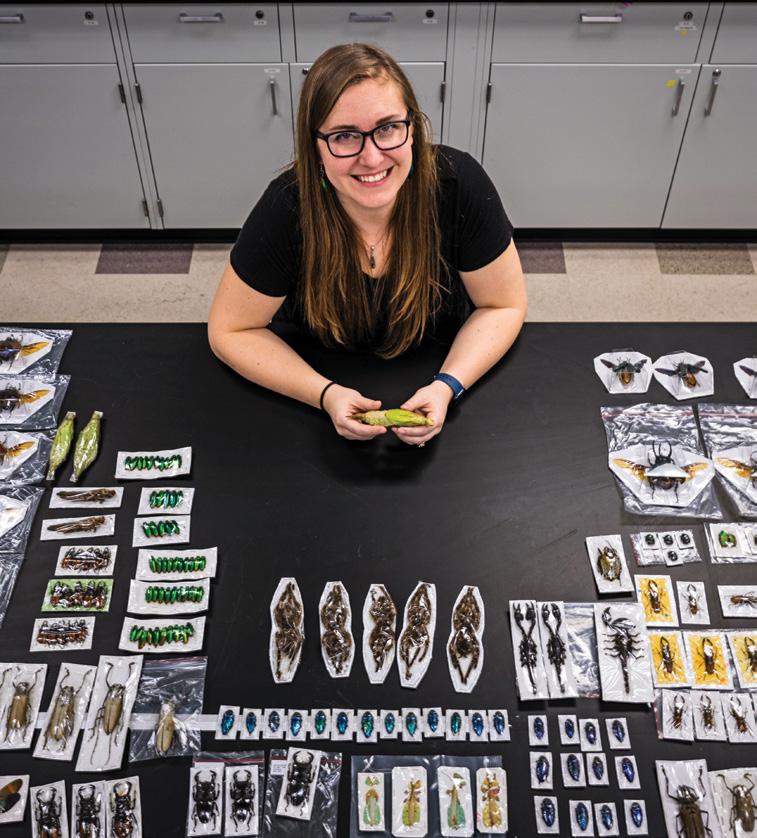
Cataloging illegally trafficked insects to aid investigators
The School of Interdisciplinary Forensics is now home to more than 3,000 black market bugs.
“People have no idea that insects are illegally trafficked,” says ASU Assistant Professor Lauren Weidner, the current curator of the collection of confiscated insects.
Weidner, a forensic entomologist on ASU’s West Valley campus, has big plans for the bugs. Over the next year, she and students in her individualized research class will create fact sheets to help investigators identify trafficked insects.
Learn more at newcollege.asu.edu/schoolinterdisciplinary-forensics .
Coral ‘nurseries’ critical to preservation
New research near Miloli‘i in the southwestern part of the island of Hawaii shows that identifying and protecting marine ecosystems, specifically coral larvae, is crucial to coral conservation and restoration. Researchers in ASU’s Center for Global Discovery and Conservation Science and ASU School of Ocean Futures in the Julie Ann Wrigley Global Futures Laboratory collaborated on the project. Additionally, the ‘Āko‘ako‘a Reef Restoration Program, a regional effort with Indigenous communities, backed the research.
This means that researchers can identify priority reefs for preservation.
Keep up with the headlines at ASU
by subscribing to the ASU News e-newsletter at news.asu.edu/ subscribe.

Broadway League honors ASU Gammage executive director
The national 2023 Broadway League Leadership Awards named Colleen Jennings-Roggensack, ASU vice president for cultural affairs and executive director of ASU Gammage, one of three recipients of the leadership award. The awards recognize outstanding efforts of league members and their commitment to producing and presenting live theater for Broadway and touring Broadway. Since Jennings-Roggensack came to ASU in 1992, she has brought hundreds of Broadway productions to ASU Gammage. She is Arizona’s only Tony voter.
Learn more at asugammage.com
CHARLIE LEIGHT/ASU ASU THRIVE MAGAZINE 9

Dutch, Flemish delegations tour MacroTechnology Works to build alliances
Fifty semiconductor and manufacturing company representatives from the Netherlands and Flanders, the Dutch-speaking northern portion of Belgium, toured ASU’s MacroTechnology Works. Among the attendees: Netherlands Prime Minister Mark Rutte and Flanders Minister-President Jan Jambon.
MacroTechnology Works is a microchip research and fabrication space. ASU leases space in the 250,000-square-foot building — which includes 43,000 square feet of clean room space — to companies. Through research partnerships with ASU, they can collaborate with faculty and students to accelerate semiconductor, advanced materials and energy device research.
Françoise Chombar, chairwoman and co-founder of Melexis, a Dutch company that is a global supplier of microelectronic semiconductor solutions, said the opportunity to see what ASU is doing in the field could lead to research partnerships between the university and Dutch companies.
“I see enormous potential of learning and the exchange of ideas between the two ecosystems,” she says.
Learn more at engineering.asu.edu/macrotechnology-works
ANDY DELISLE/ASU
Zak Holman, vice dean for research and innovation in the Ira A. Fulton Schools of Engineering, leads the delegation on a tour.
10 SPRING 2024 RESEARCH
Major economic boost to the Valley through $250M investment
ASU’s 12th building dedicated to interdisciplinary science and technology is going up on the Polytechnic campus. In fall 2025, when ISTB12 is ready, it will contain three floors of high-tech labs, classrooms, makerspaces and meeting spaces and become home to the new School of Manufacturing Systems and Networks in the Ira A. Fulton Schools of Engineering.
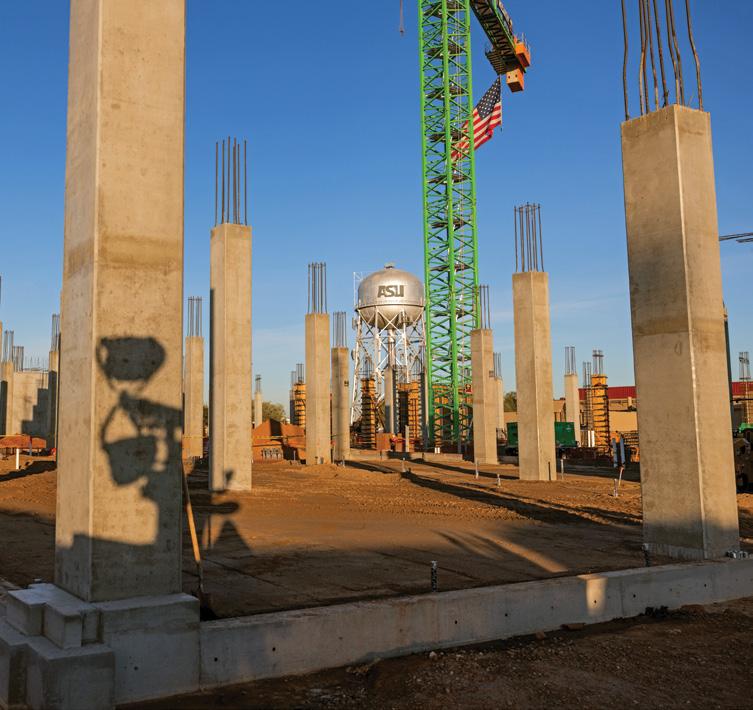
500+ jobs $800M+ impact
The third floor will be dedicated to industry partners working with students on real-world challenges. When the cutting-edge equipment is installed, the project will be a $250 million investment in the region, according to Morgan Olsen, chief financial officer of ASU.
“The goal is to prepare professionals who will contribute engineering solutions for societal challenges,” Olsen says.
ISTB12 is adjacent to the ASU Polytechnic Innovation Zone, where a partnership with the city of Mesa is expected to develop nearly 130 acres and provide more than 500 jobs and over $800 million in economic impact.
Addressing the school counselor shortage
Arizona’s schools had a student-counselor ratio of 716-to-1 during the 2020–21 school year, according to the American School Counselor Association. It ranks last in the U.S. for the ratio. To address the shortage, ASU’s School of Counseling and Counseling Psychology created a master’s degree concentration to train students to become K–12 counselors and then enable them to apply for licensure upon graduation, getting counselors into schools more quickly.
Michael Garcia, ’03 BA in education, ’18 PhD in leadership and innovation, and director of opportunity and achievement at Mesa Public Schools, helped kick-start the effort. Garcia said he’s thankful that when he told ASU about the problem, the university stepped up with a solution. Learn more at cisa.asu.edu
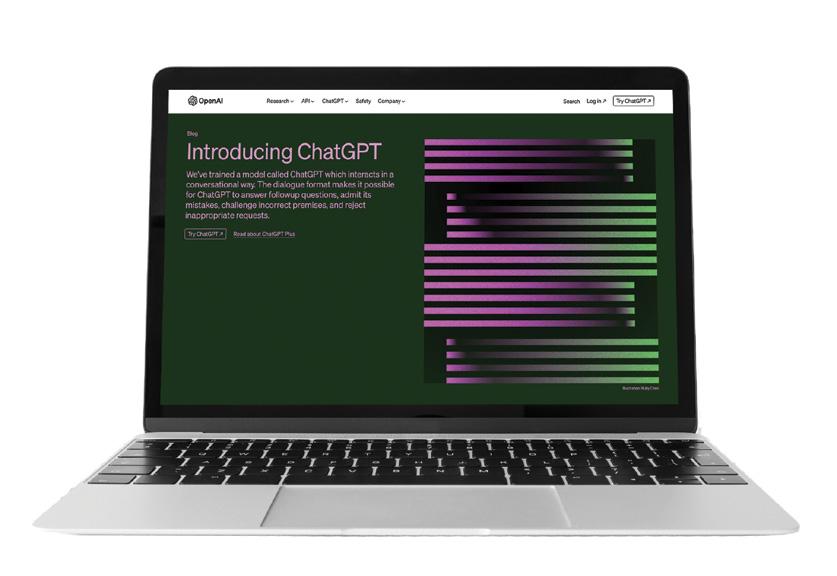
First OpenAI university partnership
ASU is the first higher education institution to collaborate with OpenAI, the creator of ChatGPT. The collaboration sets a precedent for how universities can use artificial intelligence to enhance learning, creativity and student outcomes. The innovation has garnered national and international attention.
In February, ASU began inviting submissions from faculty and staff for innovative uses of ChatGPT Enterprise in three key areas: enhancing student success, forging new avenues for innovative research and streamlining organizational processes.
Lev Gonick, ASU chief information officer, says, “The goal is to leverage our knowledge core to develop AI-driven projects aimed at revolutionizing educational techniques, aiding scholarly research and boosting administrative efficiency.”
“Our collaboration with OpenAI reflects our philosophy and our commitment to participating directly in the responsible evolution of AI learning technologies.”
— MICHAEL M. CROW, ASU PRESIDENT
MIKE SANCHEZ/ASU ASU THRIVE MAGAZINE 11
“As ASU’s research enterprise expands exponentially, so does our ability to generate real-world solutions.”
— SALLY MORTON, EXECUTIVE VICE PRESIDENT, ASU KNOWLEDGE ENTERPRISE

Top 5 for inventions, patents, patent deals and startups
The university ranked among the top five research institutions without a medical school for the first time in fiscal year 2022 for inventions disclosed, U.S. patents secured, patent licenses and option deals closed, and startups launched. This is according to the Association of University Technology Managers’ latest survey on licensing activities at U.S. universities and research institutions.
Skysong Innovations, the university’s technology transfer and intellectual property management organization, has cumulatively secured over 1,550 U.S. patents for ASU and closed over 1,400 license or option deals with commercial partners. It also has facilitated more than 230 ASU startups that have collectively attracted nearly $1.3 billion in external funding.
Learn more at skysonginnovations.com .
SAMANTHA CHOW/ASU
12 SPRING 2024 RESEARCH
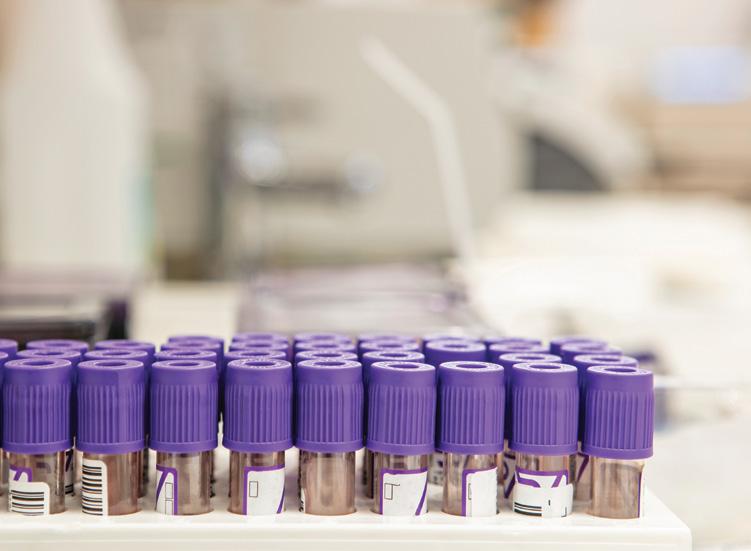
New blood testing method for disease detection
Researchers in ASU’s Biodesign Institute have developed a blood-sample screening method that can look at hundreds of disease markers and evaluate thousands of samples simultaneously, delivering most results in 24 hours. Joshua LaBaer, executive director of the institute, developed the Multiplexed In-Solution Protein Array, and published findings in Microbiology Spectrum.
“The depth of the profiling provides us with a detailed understanding of individual immune status for common pathogens of interest .”
— LUSHENG SONG, ASSISTANT RESEARCH PROFESSOR, BIODESIGN CENTER FOR PERSONALIZED DIAGNOSTICS
Diagnostic blood testing is a critical tool in medicine and public health. It allows doctors to evaluate an individual’s exposure history to pathogens, monitor autoimmune conditions and evaluate the body’s response to vaccines. Standard blood testing methods, before this scientific leap, are limited to assessing immune responses against one or a few antigens at a time.
Learn more at biodesign.asu.edu/researchareas/infectious-diseases .
Getting medical devices to market
ASU has established itself at the forefront of medical device manufacturing through research, startups and patents. Now the region will increase its prominence in the field thanks to a grant from the U.S. Department of Commerce Economic Development Administration to the Greater Phoenix Economic Council’s Medical Device Manufacturing Multiplier Strategy Development Consortium. Marco Santello, a professor in ASU’s School of Biological and Health Systems Engineering in the Ira A. Fulton Schools of Engineering, will serve in a leadership role in the consortium.
Learn more at corporate.asu.edu/ skysong
Creating an Indigenous-led health data repository
The National Institutes of Health awarded $9 million in funding for Native scientists to create the first Indigenous-led tribal data repository to improve health outcomes for tribal communities and Indigenous people. The RADx Tribal Data Repository initiative comprises collaborative research awards to ASU, the Native BioData Consortium and five partner universities.
ASU’s School of Life Sciences Assistant Professor Krystal Tsosie, a member of the Diné/Navajo Nation, co-founded the nonprofit Native BioData Consortium, the first U.S. Indigenous-led biobank.
Tsosie will use a $1.2 million sub-award of the project to design ethical approaches to data sharing, analysis and implementation.
Learn more at sols.asu.edu .

“We started NativeBio with a very simple premise: that research on Indigenous peoples’ samples should be led by Indigenous community members and Indigenous scientists.”
– KRYSTAL TSOSIE, ASSISTANT PROFESSOR IN ASU’S SCHOOL OF LIFE SCIENCES
MONICA GAYTAN INCHAURREGUI ASU THRIVE MAGAZINE 13


14 SPRING 2024
LOCAL ENTREPRENEUR
5 tips for taking a product to market
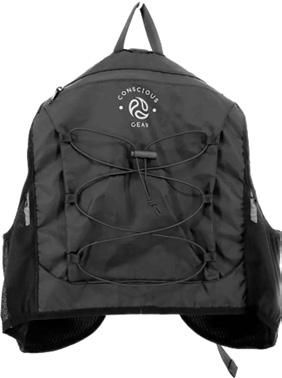
Charlotte Bowens, an ASU research administrator, created a hydration pack for bigger bodies. Three years after her first forays into making the product, the VestaPak came in seventh for the top 10 best gifts for outdoor enthusiasts on USA Today’s gift guide. Here are her tips for aspiring entrepreneurs.
1. Identify the need.
2. Make a prototype.
3. Put the idea to the test. After Bowens had a working model, she asked people in her running and hiking groups to try the vest.
4. Look for funding opportunities. In addition to education and funding through ASU’s J. Orin Edson Entrepreneurship + Innovation Institute, she was accepted into the Target Accelerator program. “Filling out applications for funding was my every Friday-night adventure,” she says.
5. Bring in experts. Bowens hired an industrial designer.
Go to entrepreneurship.asu.edu/ programs/venture-devils for resources. Read Bowens’ full story at news.asu.edu.
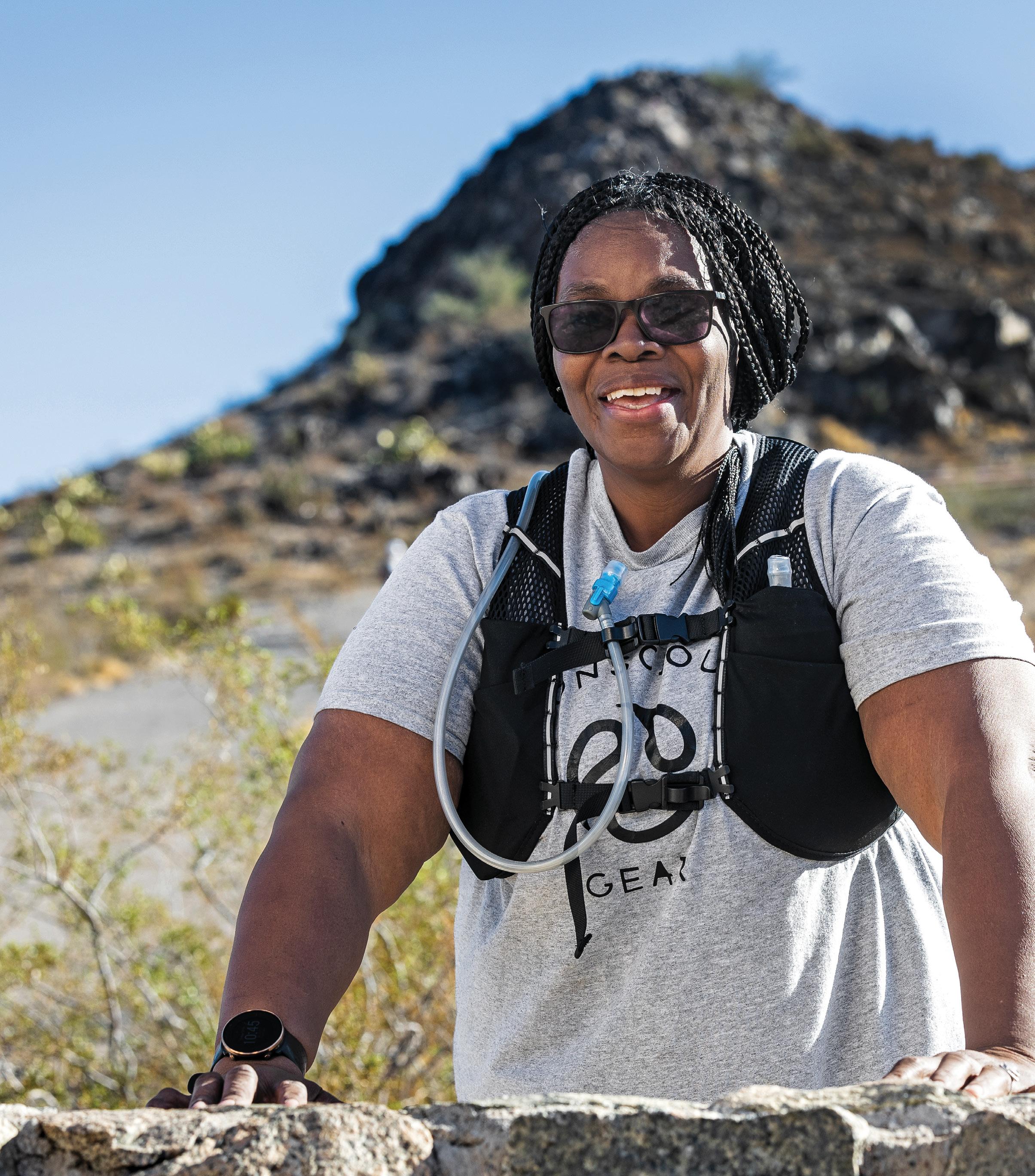
Charlotte Bowens, the research administrator for the Center for Bio-mediated and Bio-inspired Geotechnics at ASU, designed the VestaPak.
CHARLIE LEIGHT/ASU ASU THRIVE MAGAZINE 15
Skills new managers need to master Page 16 ASU in top 20 for Future Leaders list Page 19
Career
















May Busch is a former COO of Morgan Stanley Europe, who is now an executive coach, speaker, advisor, author and executivein-residence in ASU’s Office of the President. maybusch.com/ asuthrive





















Skills
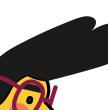




















new managers need to master
Are you stepping into a new leadership role this year?
Stepping up as a new manager can feel like starting back at square one, especially since you were likely the master of your previous role.
But the good news is, mastering key skills can help you adjust to your new position quickly. Here are the five most important skills new managers need to master.
16 SPRING 2024 CAREER












Check your ego
Make sure you bring your “big self” to work. This is the part of you that thinks about doing the right thing, from the standpoint of the team, the mission and the organization. And leave your “small self” to the side. That’s the part of us that feels compelled to convince everybody how smart, talented and deserving you are of your position.
Learn how to care for and feed your team
Everybody feels motivated by something different. So you’ve got to talk to each team member to find out what motivates them. For example, one person might need a lot of structure, while another team member thrives on a more hands-off approach. Treat people how they want to be treated, the way that will help them give it their best.
Let people know you are on their side
This is all about your tone and your mental stance. Instead of doing what I call, “Tell, sell and yell,” go for positivity and encouragement. Let your team know you support them and have their back.
For example, in my first leadership role, I sat down with each team member individually to
ask, “What does success mean for you?” I assured them, “I will do everything I can to help you.”
Focus
Choose three priorities and laser in on getting those done. This gives people something concrete to rally around, and you’ll feel much more in control if you’re not scattered.
The same goes for your guiding principles and rules. Don’t make too many. Decide on what really matters for you and your team and stay focused on those things.














Put it into action
Take a moment to consider your new role. Which of these skills do you think will most help you succeed in your new leadership role? Or, if you’re not in a new role, which of these strategies will help you excel in your current position?
Focusing on the people on your team, the mission of the organization you serve, and these tips will help make the challenges feel less daunting and help you succeed. ��






















Create a support network
When you’re a new leader, it can feel lonely. It helps to build an informal network of people in similar situations to yours, or people further along. Consider getting formal support too. For instance, you could hire a coach or set up times with a mentor to go through some of your questions and concerns.

















Build your skills






Improve your managerial skills with additional resources. Go to maybusch.com/teamleadership. Consider taking the Principles of Character-Driven Leadership course at careercatalyst.asu. edu/programs/characterdriven-leadership
ASU THRIVE MAGAZINE 17
Lifelong learning
Turn heads with your resume
Learn to create that stellar first impression by writing accomplishment statements. These high-impact statements communicate that you have achieved results and possess the skills and capabilities your future employer is seeking.
asuforyou.asu.edu
Free Networking
Job search Online
Training to help you earn promotions or shift your career
Become an AI expert
Dive into the cutting-edge world of AI with CareerCatalyst’s “AI Foundations: Prompt Engineering” course. Explore the art of crafting impactful prompts for ChatGPT and enhance your skills in prompt evaluation and design.
careercatalyst.asu.edu
Navigate your career with confidence
As an ASU alum, you have access to career fairs, webinars, networking and other career development events through Handshake (asu.joinhandshake.com).
Use the events tab to find opportunities to network with potential employers. The jobs board on Handshake offers more than 10,000 jobs at any given time.
alumni.asu.edu/ services
Boost your interview savvy
Big Interview offers up-to-date advice on interviews and other career-related topics for everyone, regardless of their industry or seniority level. Access career education modules along with award-winning AI-based interview practice sessions.
asu.biginterview.com
Free Networking Job search Online

Talk to an expert
Click
search Online
Online Self-paced

Step into the future of microelectronics
Your gateway to over 70 courses in the thriving semiconductor sector, ASU’s “Microelectronics Workforce Development Hub” is designed for everyone from high school students to professionals seeking a career change. As part of ASU’s commitment to national semiconductor manufacturing, the hub provides the tools and pathways for success in a rapidly expanding industry.
microelectronics.asu.edu
Online Self-paced
Log
Need personalized advice from an experienced career advisor, some help updating your resume or prepping for an interview?
on to Handshake to make an appointment today.
on “Schedule a New Appointment” and then “ASU-Alumni.” asu.joinhandshake.com Free Networking Job
Free Networking Job search Online
18 SPRING 2024
ASU named top 20 in the US in Time and Statista’s Best Colleges for Future Leaders list
Influential leaders’ success stories are often aided by great career opportunities, vast network connections and powerful learning tools — all of which can come from a transformative education experience.
ASU was recently recognized for its ability to provide this launchpad for success in Time and Statista’s inaugural Best Colleges for Future Leaders list. ASU was ranked ahead of University of Southern California, University of California, Los Angeles and Johns Hopkins University.
Time and Statista specifically recognized the Thunderbird School of Global Management as a “notable subsidiary” of ASU, regarded as a prominent school within the ranked institution for its top leadership and management education.
“America’s future success will rely on bold, innovative thinking across sectors, and that means we need leaders from all communities who are prepared for the opportunities and challenges facing our nation and planet,” says ASU President Michael M. Crow.
Learn more about Thunderbird at thunderbird .asu.edu .
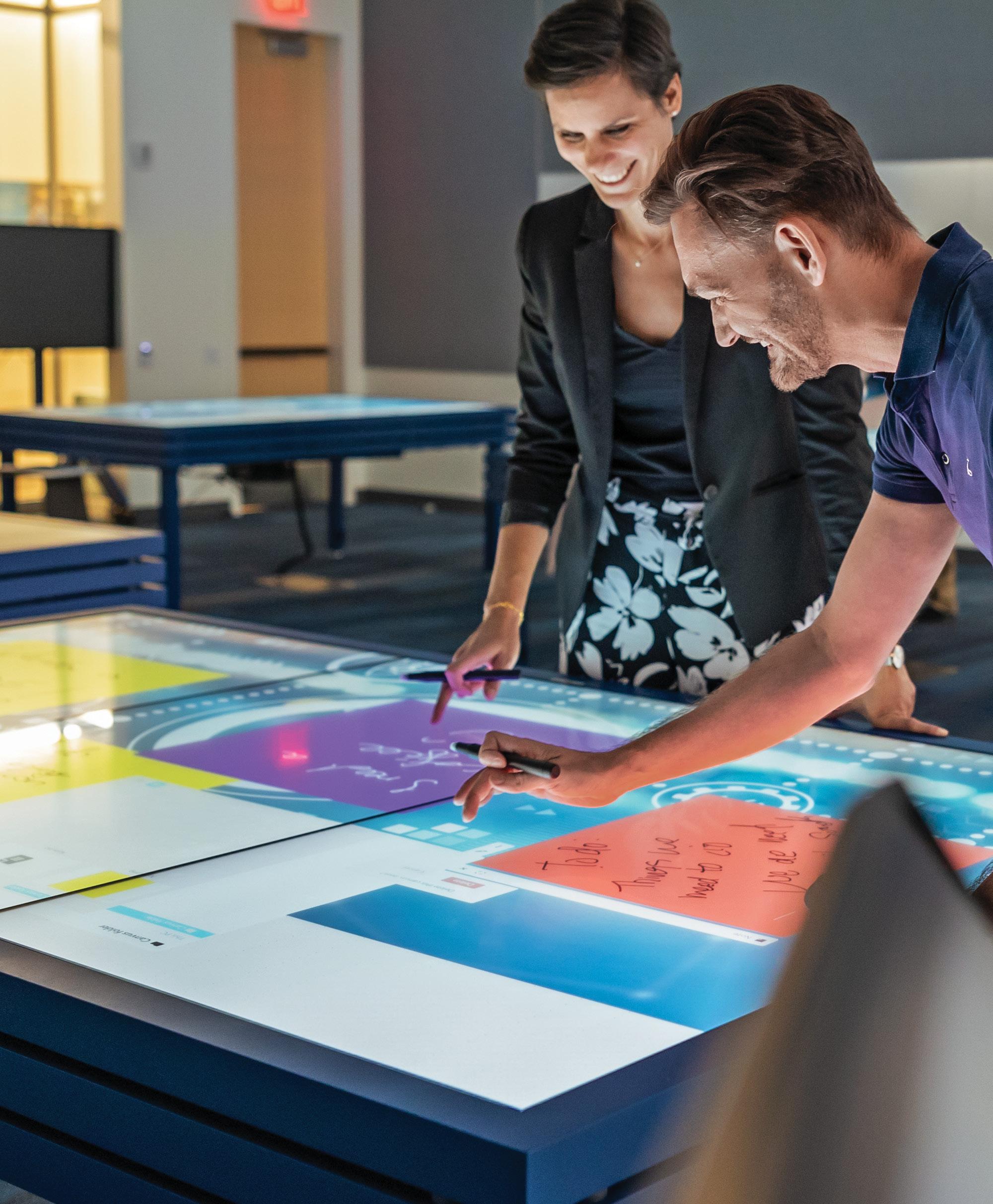
ASU’s Thunderbird School of Management innovation lab houses state-of-the-art tabletop interactive computers to facilitate collaborative work.
ASU THRIVE MAGAZINE 19 SABIRA MADADY/ASU
CAREER
AUDIO WAVES
Sound artists
Cambelle Gregory sees a Hollywood production studio sound booth in her future, so the third-year student is making her way toward that goal. As a student at the MIX Center, Gregory has been working with industry-standard audio consoles and software equipment, along with the guidance of awardwinning sonic artist and Assistant Professor Rodrigo Meirelles and an alumni network of Hollywood professionals.
Meirelles, Gregory and another member of Safe for Sound, a club for students interested in sound mixing for films and the music industry, attended the annual conference of the Audio Engineering Society in New York this past fall. There Gregory won the student competition — for the second consecutive year — with the reimagined sonic landscape she created for the animated short film, “Entropy” by Rhubarb Zoo.
Learn more at film.asu.edu .
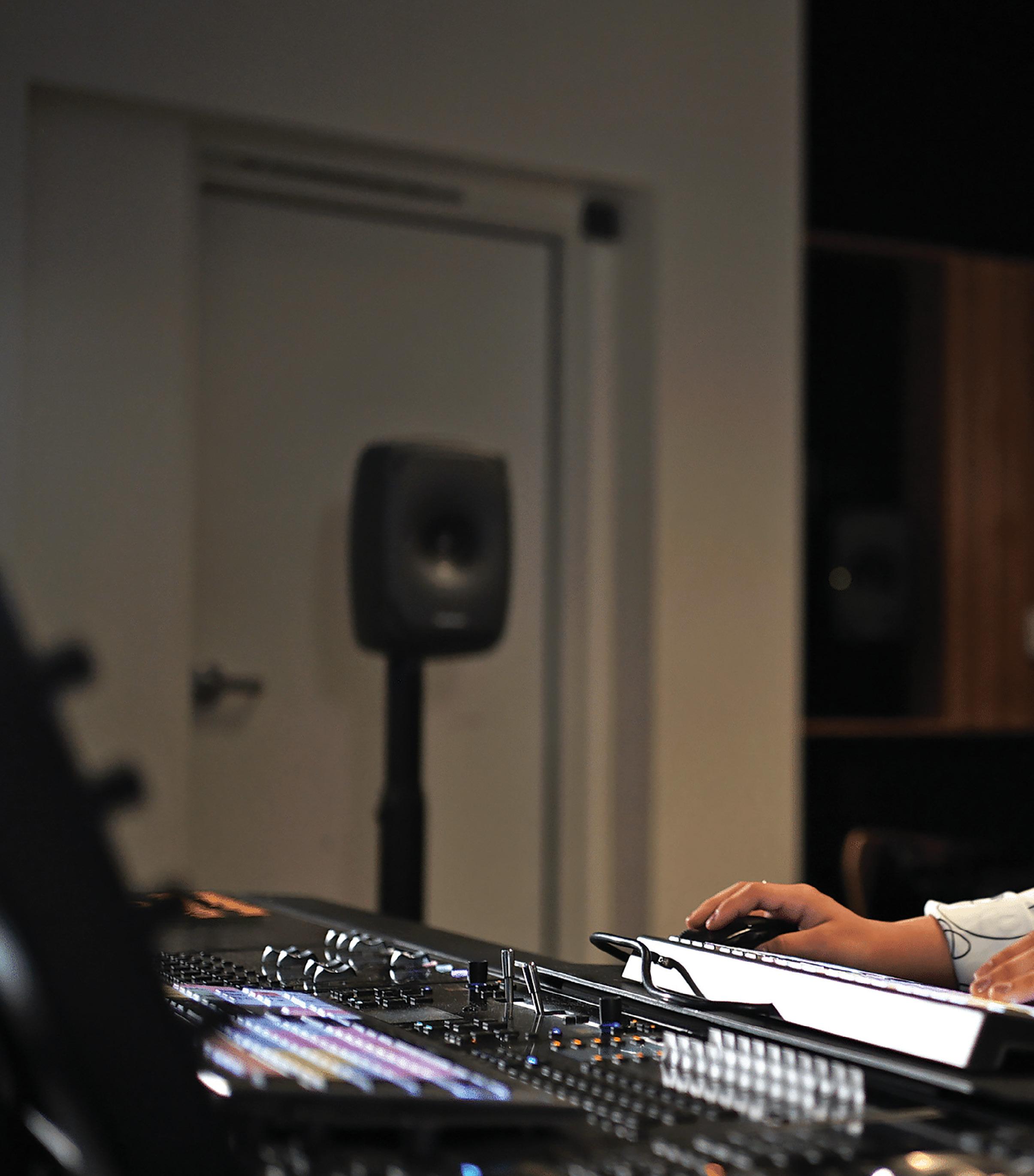
“Sound is much more than just what you hear. It is what you feel, how you connect to a film and what keeps you coming back for more.”
— CAMBELLE GREGORY
20 SPRING 2024
Arts and media
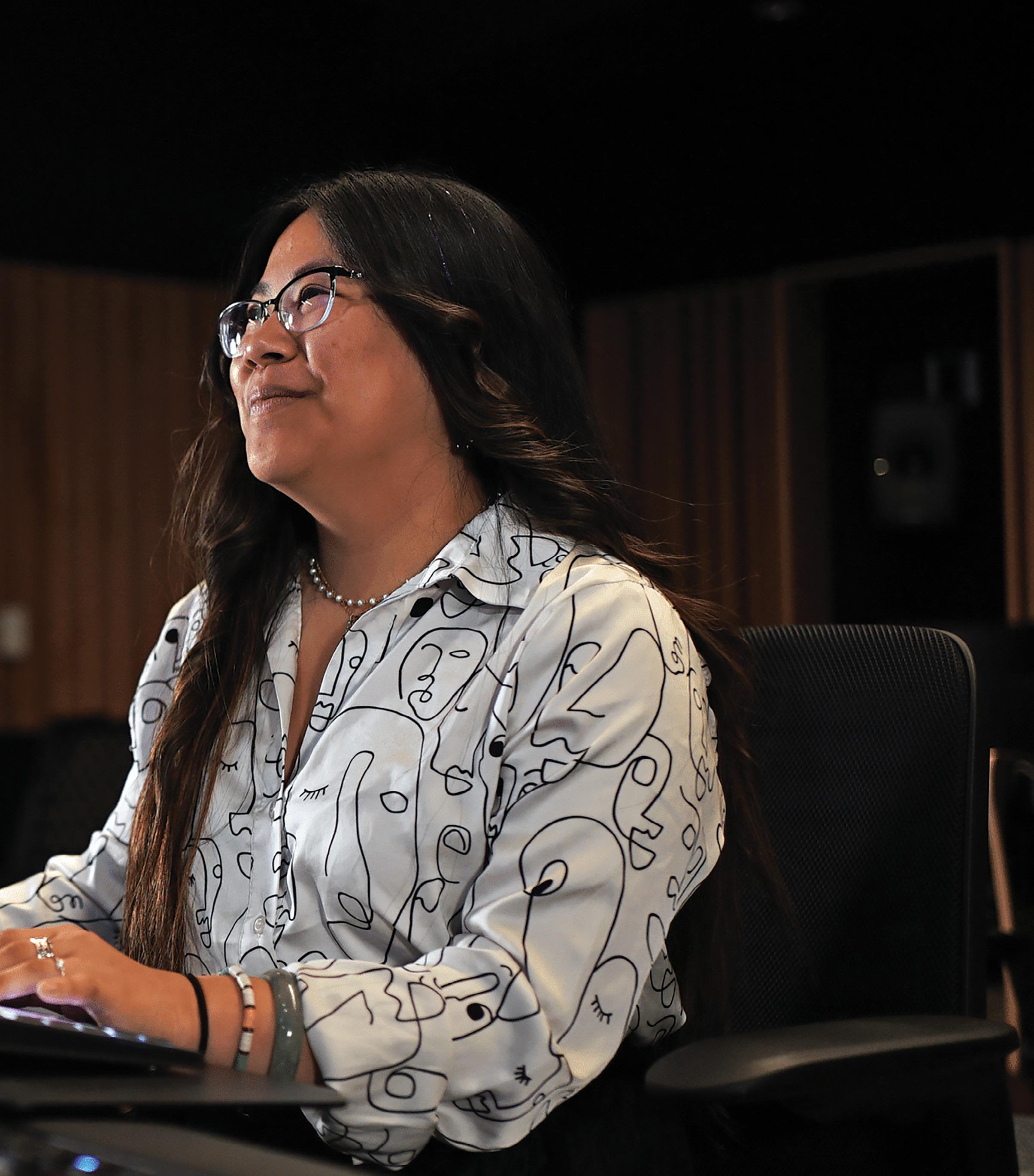
Cambelle Gregory won the student competition for the second consecutive year at the Audio Engineering Society in New York.
The future of fashion
Page 22
Professor designs Phoenix Suns’ jersey
Page 26
ASU THRIVE MAGAZINE 21
TAYLOR BLACKMORE/ASU
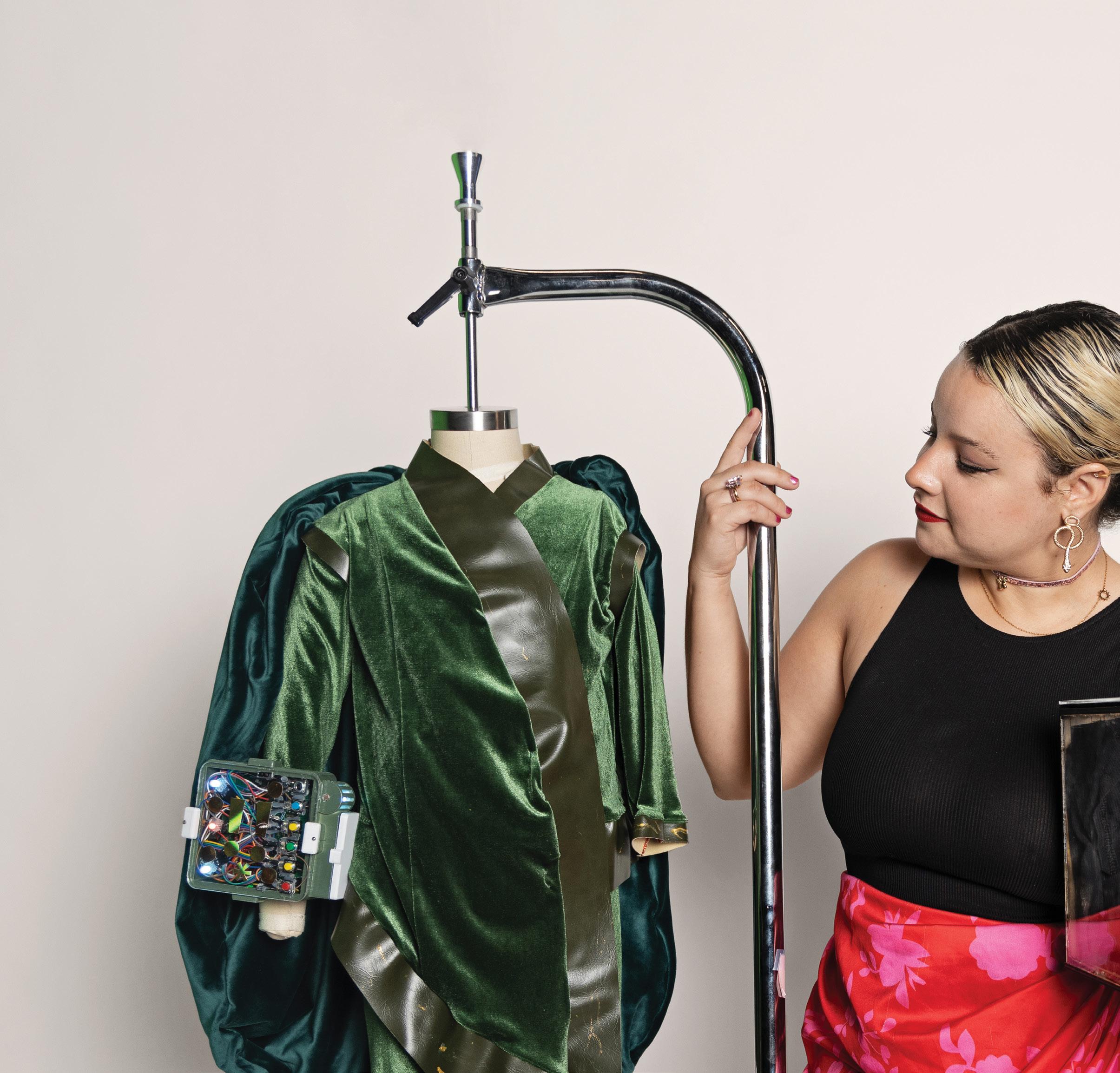
THE future
22 SPRING 2024 ARTS
Fashion-engineering collaboration creates wearable tech for kids undergoing chemotherapy
Story by MARY BETH FALLER, ’19 MEd Photos by CAMILLE MISTY
OF
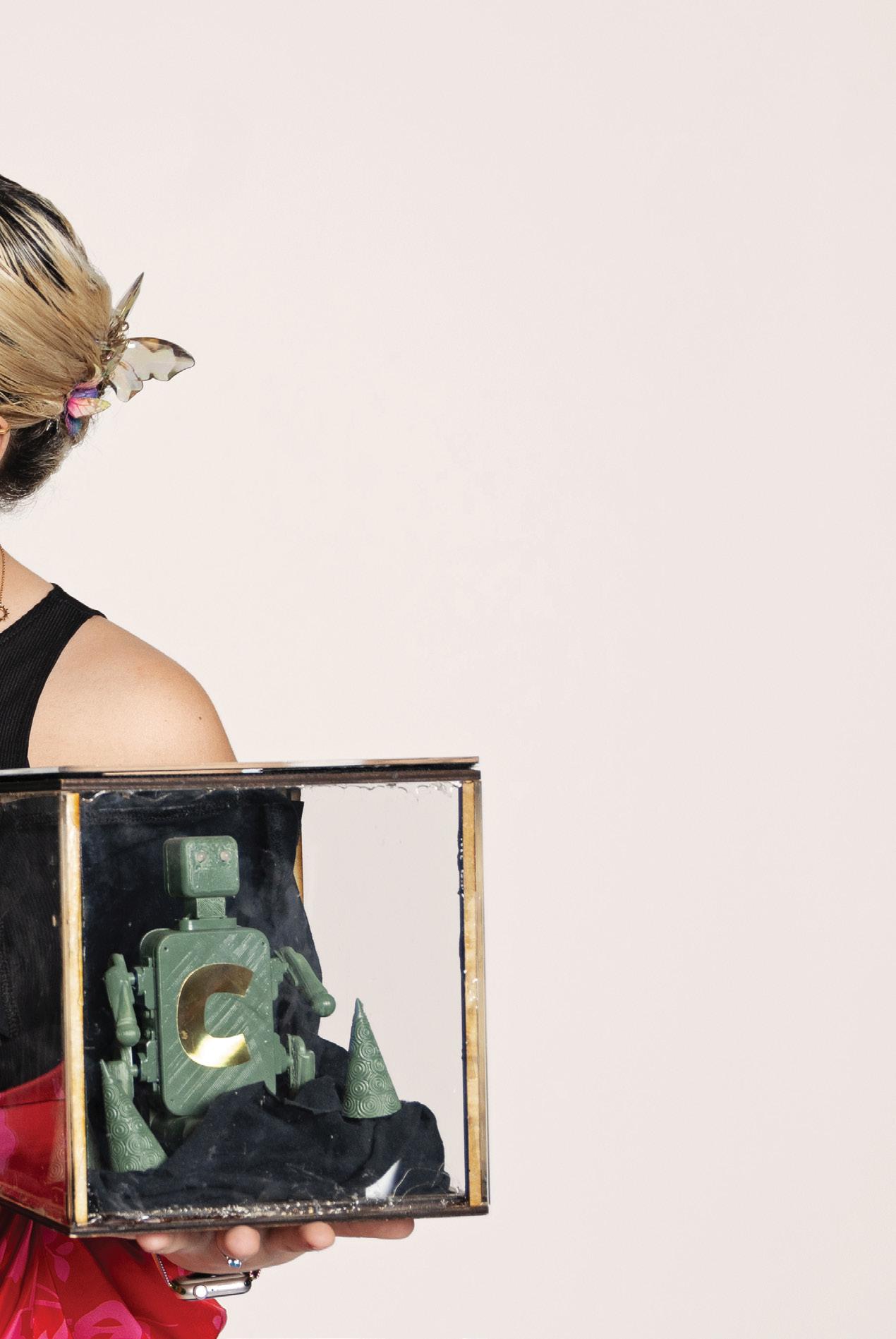
fashion
Vitoria Peixoto, a fashion student, shows off her clothing design that uses technology to comfort the wearer.
When kids get sick and are hospitalized, it can be scary and isolating.
The constant prodding is painful and intrusive. And often, the rooms are kept cold.
A group of ASU students collaborated across disciplines and campuses this year on ways to make those kids feel a little bit better.
Their final designs are soft, warm, beeping, musical, glittery, funny and bubbly.
Some of the students were in EGR 304, Embedded Systems Design, based at the Polytechnic campus, and the rest were in FSH 394, Fashion Design and Wearable Technology, based at the Downtown Phoenix campus.
The engineering students had to come up with technology to help the kids that could be integrated into garments, which were designed
ASU THRIVE MAGAZINE 23
by the fashion students with the purpose of accommodating the technology.
The engineers created devices to calm the kids, monitor their health signs, make them laugh and distract them.
Last year, Galina Mihaleva, an associate professor at ASU FIDM, the fashion school, co-taught the wearable technology fashion class with Shawn Jordan, an associate professor of engineering at The Polytechnic School. That experience led to the collaboration this year.
“For the engineers, fashion is packaging,” Jordan says. “And for the fashion students, the technology is a way of communicating the
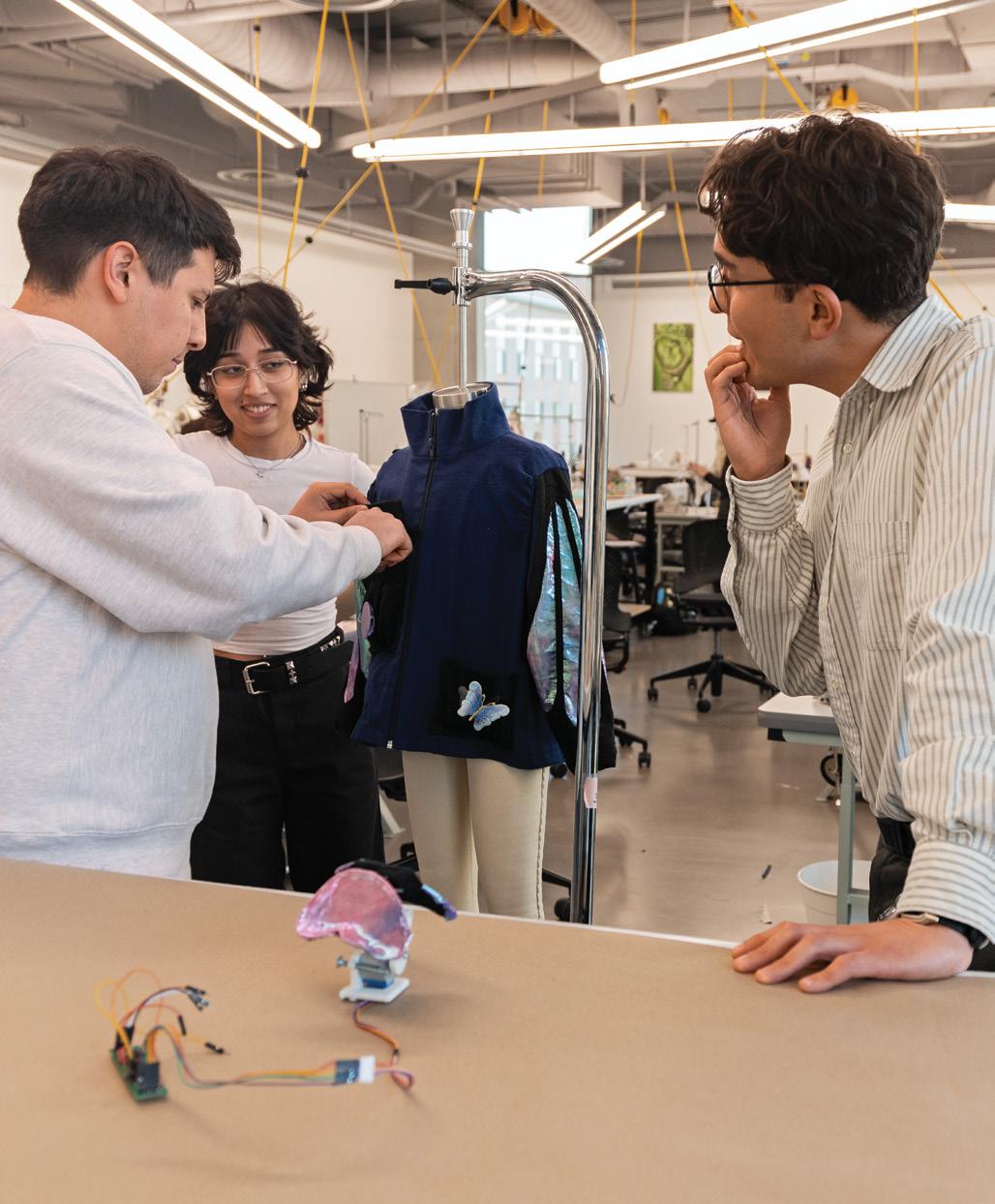
“For this class I wanted the students to use empathy. The feedback they got was wonderful.”
— GALINA MIHALEVA, AN ASSOCIATE PROFESSOR AT ASU FIDM, THE FASHION SCHOOL
overarching idea.
“Sometimes with the engineers, the easy place to go is, ‘Let me make a watch or a wristband.’ So a mentoring piece on my end has been, ‘OK, that’s not interesting from a fashion perspective.’
“They have to give the fashion students flexibility to take the tech they’re designing and expand it so it’s not just a wristband but integrated into a garment.”
Mihaleva previously worked on the Power Play project, led by faculty associate Melissa Montoya, in which fashion students designed superhero costumes for patients at Phoenix Children’s Hospital. But she was interested in having her students create wearable technology that provided more longterm benefits.
After searching for a partner, Mihaleva connected with Amanda Hope Rainbow Angels, a Phoenixbased nonprofit that supports children in treatment with adaptive garments, family support, events and financial aid. The organization supported the class project financially, and the Infineon Corp. donated technology kits.
Amanda Hope Rainbow Angels also arranged for the students to tour its downtown Phoenix facility and interview children who were undergoing treatment for cancer.
“We told the students that their clients are children and they need to design something that can comfort them during or after chemotherapy,” Mihaleva says. “For this class I wanted the students to use empathy. The feedback they got was wonderful.”
The 21 teams presented their projects twice at the end of the semester, once at the Downtown Phoenix campus and once at the Polytechnic campus.
One project was called the Bubble Blaster 6,000 and included a light blue jacket made of bubblytextured soft fabric and a device that blows bubbles, meant to distract a distressed child.
The jacket, created by thirdyear fashion major Casey Stewart, featured iridescent bubble decorations and was a wrap design to provide easy access to the chemotherapy port that is implanted in the chest of a child undergoing treatment.
“Our goal was to make something fun and comfy that can be used in a hospital, so we went with something everyone likes — bubbles,” says Princess Colon, a robotics major, as she presented her group’s project.
Another team designed a little bomber jacket that plays music from a device controlled by a phone app. Media, art and science student Jianbang Xu made the garment of dark blue fleece embedded with sparkles.
24 SPRING 2024
Engineering major Manuel Garcia and Anthony Alvarado, and fashion major Lizbeth Vigueria-Ramirez.
Sewa Eagle Hawk helped create the Last Airbender jacket with patches representing the four elements. It has a device to activate the four elements’ light and sounds.
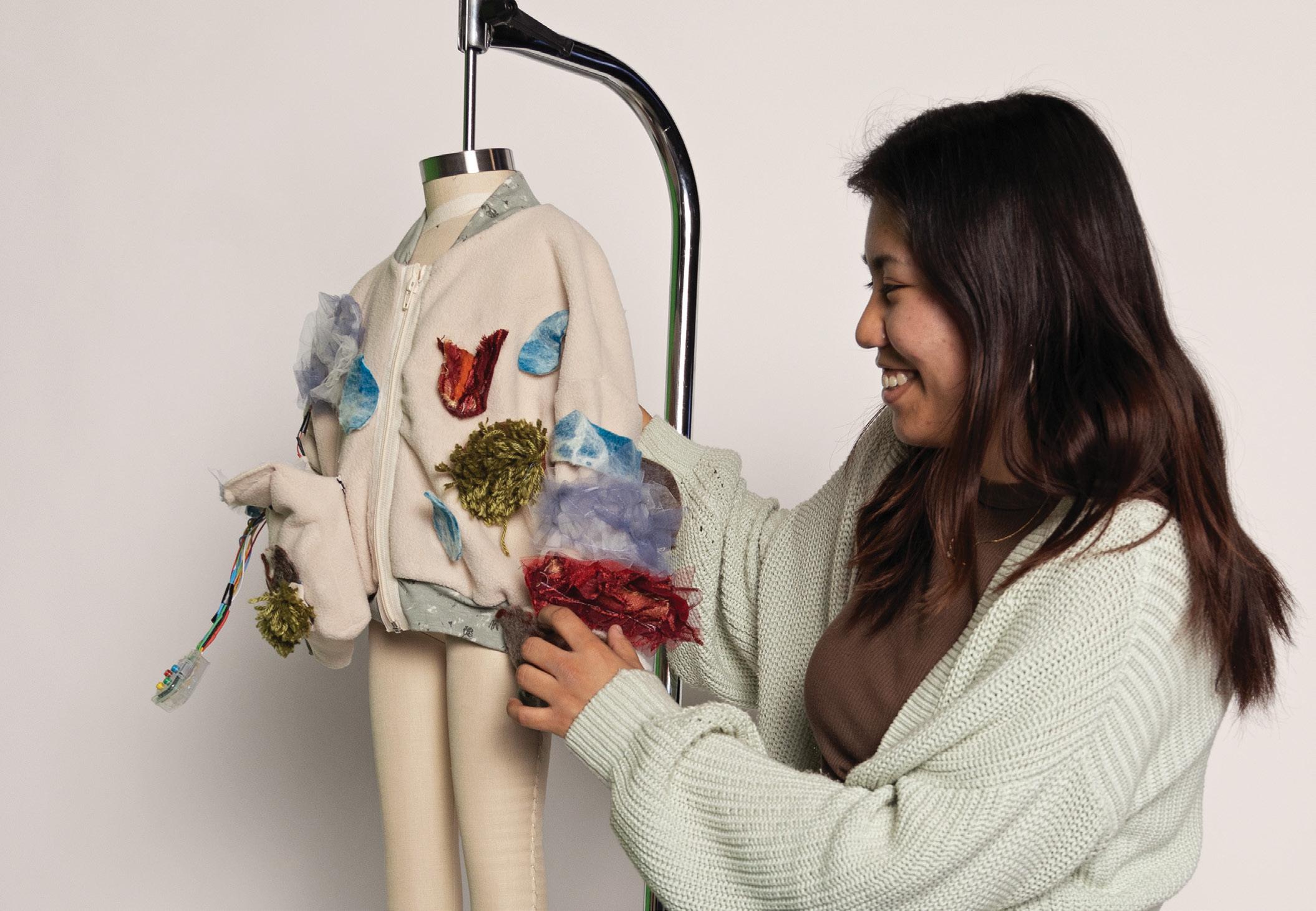
“We wanted something that is very special, so we went with a space aesthetic,” says Sean Vellequette, a robotics major.
“One of the things we noticed when we toured Amanda Hope is that there are a lot of arts and crafts but nothing that satisfies a music requirement, and we thought that was an untapped medium.”
“Because the treatment can take hours and they have to sit still, this gives them another stimulus other than drawing,” says Ethan Conner, also a robotics major.
The students learned that kids in treatment often feel out of control as doctors and nurses continuously prod them. So one team developed a little robot avatar that the child can move. The robot controller was integrated into a green velvet robe that gives “Baby Yoda” vibes.
The technology was a challenge, according to Raj Kodithyala, a robotics major.
“We had guidance controlling a device with our phones, but this project entailed communicating two of these micro Bluetooth chips, and that was new territory for us and we needed supplemental material and a lot of reading,” he says. “We went above and beyond.”
The Mindful Butterfly was a colorful jacket with butterfly wings that measures the child’s heart rate. If the heart rate is too high, it activates a little butterfly on the child’s wrist and the child can breathe along with the flapping wings to slow their breath rate and calm themselves. A speaker system plays calming music, and LED lights in the sleeve light up red if the heart rate is too high.
Land your fashionrelated dream job
A future in fashion starts at ASU FIDM, where students learn on the same equipment professionals use in cuttingedge facilities alongside worldrenowned faculty and industry insiders. ASU FIDM is available both in downtown Phoenix and in downtown Los Angeles near the Fashion District.
Find out more at asufidm.asu.edu .
Lorraine Tallman, founder of Amanda Hope Rainbow Angels, says the project makes a big difference.
“Hospitalized children can feel isolated,” she says. “So when anything comes to them in the bed where they are, they remember that people are thinking of them, and it’s so powerful.” ��
ASU THRIVE MAGAZINE 25



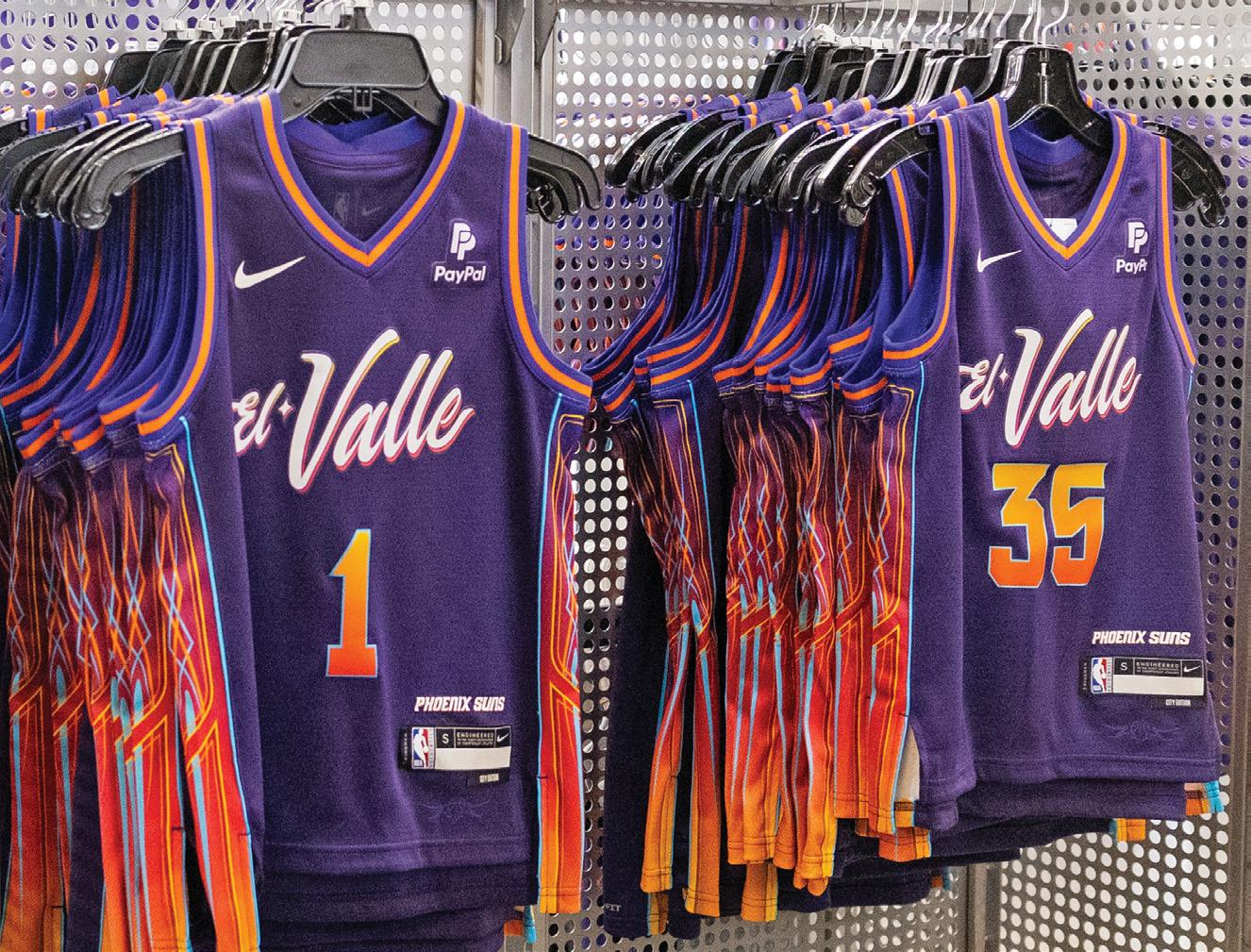
26 SPRING 2024 ARTS

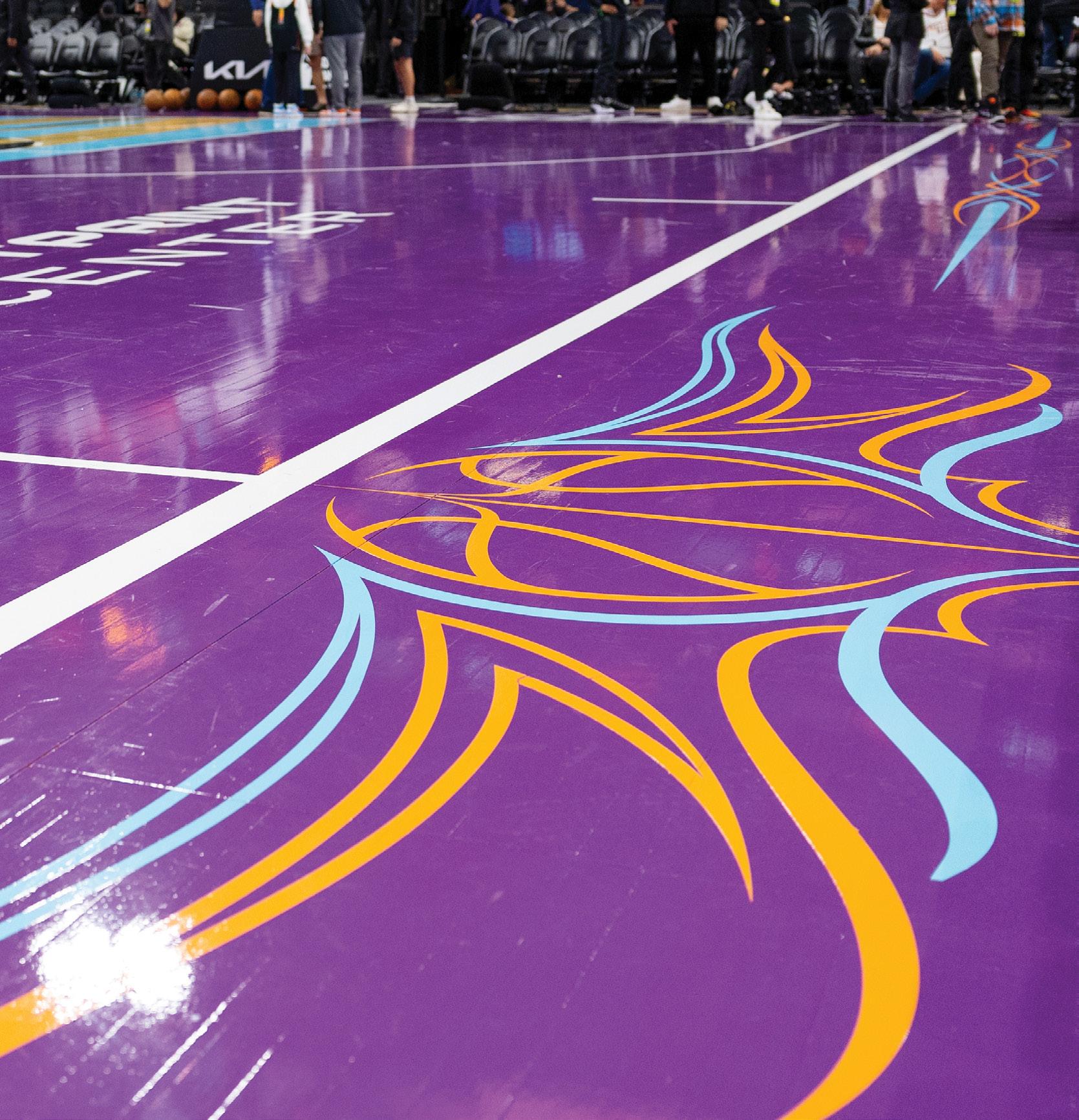

heritage Honoring
Story by SCOTT BORDOW, ’98 BA
Photos by SAMANTHA CHOW, ’22 BA, ’23 MMC; AND CHARLIE LEIGHT
For 13 games this 2023–24 season, the Phoenix Suns are pounding down the court wearing jerseys emblazoned with “El Valle.” The uniforms feature pinstriping that emulates the hand-painted art on a lowrider designed by Miguel Angel Godoy, an ASU School of Art instructor. Godoy’s family has ties in Southern California and in Phoenix.
ASU THRIVE MAGAZINE 27
For Godoy, a muralist whose works have been exhibited around the Valley, the opportunity to design the El Valle uniforms wasn’t just a unique business prospect, but a chance to showcase his Chicano heritage and the lessons his grandfather taught him.
“When I thought about our art and what aesthetic we’ve created on our own, I really started to lean on my history and my background,” Godoy says. “And with that came the idea of the lowrider culture. That was the seed.”
His father, Ramon, who served in the Army, shared stories with his son about the lowriders he and his brothers would get painted at a local auto store. Godoy and his older brother, Jesus Rodriguez, would eventually start building lowrider bikes and even had a lowrider bike club called “Drastic Measures Bike Club.”
His inspiration for the uniforms settled, Godoy started going to car shows around the Valley to get ideas on how the lowrider culture could be implemented into an NBA uniform. What stood out to him immediately was the pinstriping and colorful paint jobs on the cars.
He took the uniform schematic provided to him by Nike, flipped it sideways and almost immediately envisioned the lowrider pinstriping on the side of the jersey and shorts. ��
See his work at instagram.com/miguel_ angel_godoy.
Advice for fashion students
• “Know your vendors,” says ASU School of Art instructor Miguel Angel Godoy.
• “Understand how your colors are going to print,” Godoy says.
• “Shadow someone, an expert in what you’re trying to do in fashion,” Godoy says. “Follow them and then ask questions.”

Godoy, who was inspired by his father’s art practice when he was growing up, pursued creative practice through a BFA and master’s degree in art. He is now an instructor teaching drawing and painting in the School of Art.
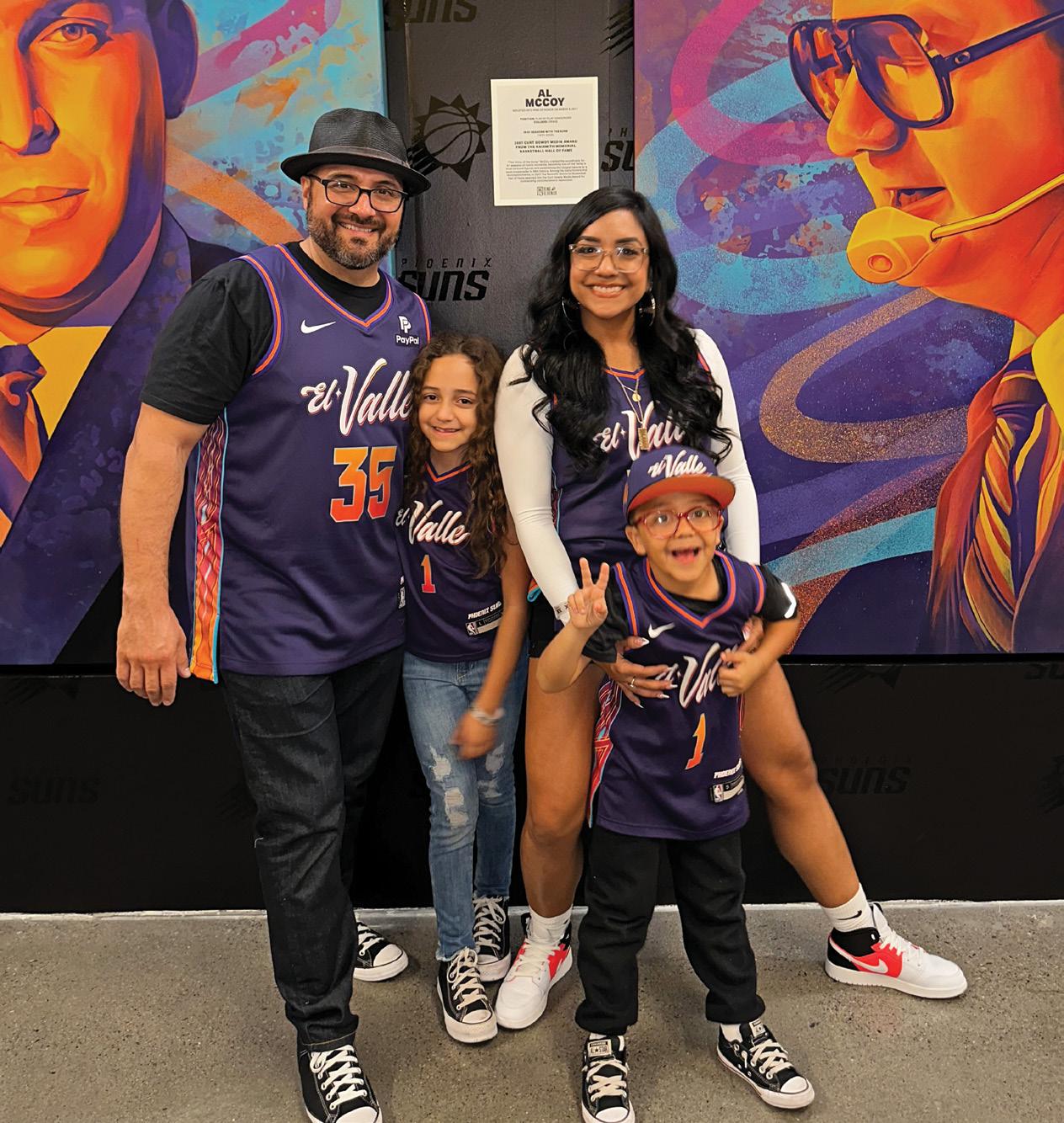
28 SPRING 2024
Godoy, seen here with his wife, Mara Nohemí López, ’21 in EdD in leadership and innovation, and children, was selected for the project after the Suns saw the murals he had done as a local artist throughout Phoenix.
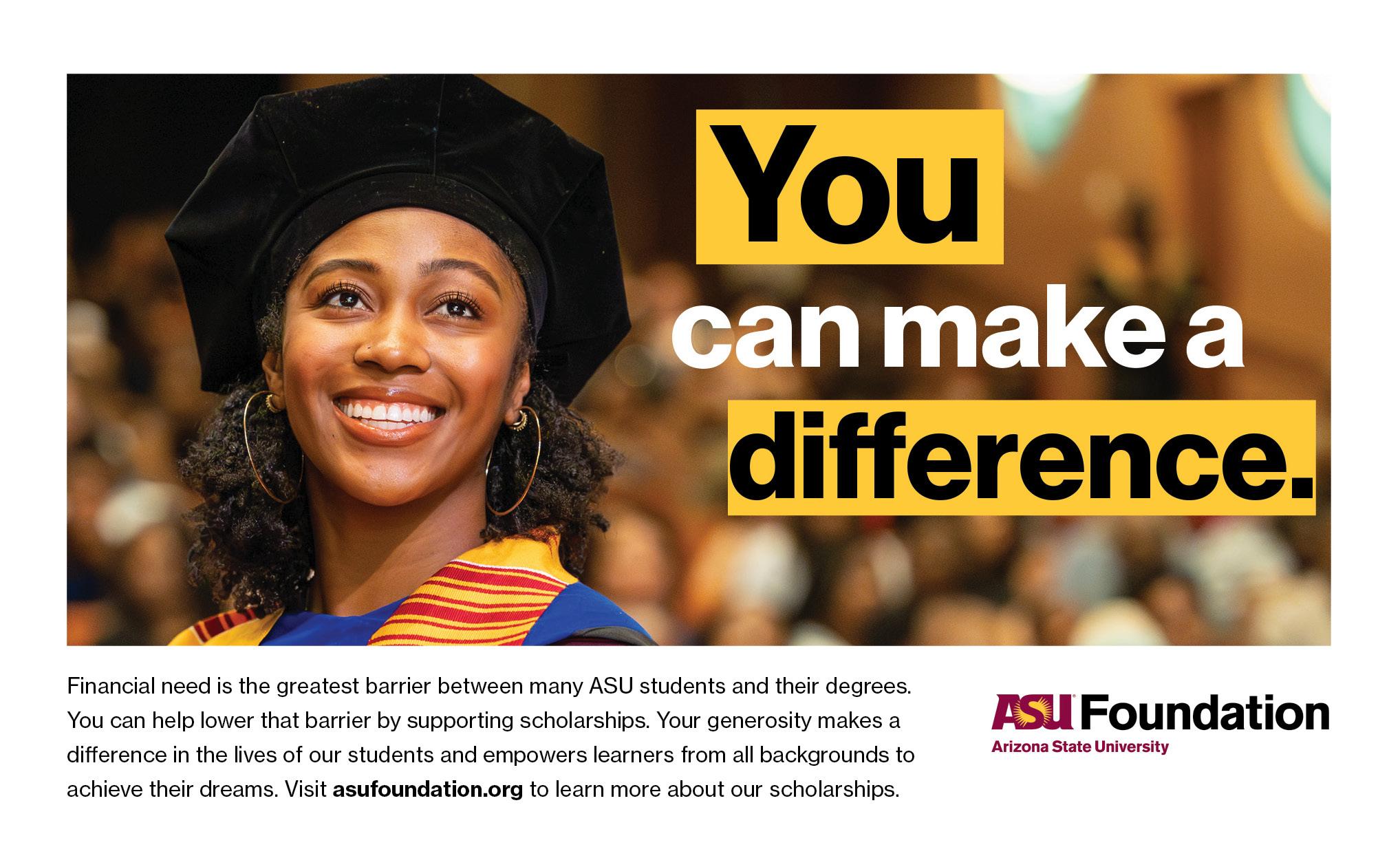
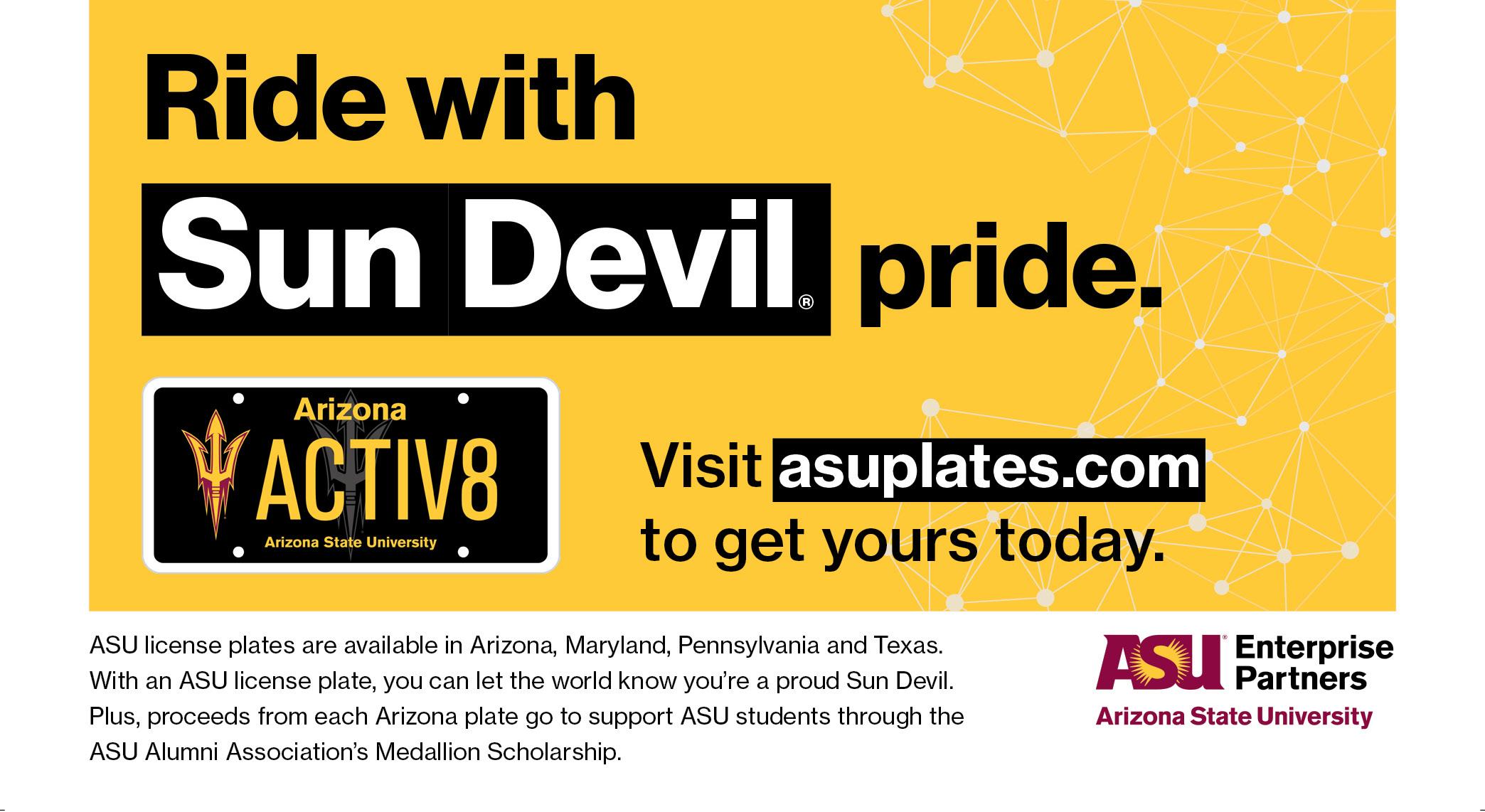
ASU THRIVE MAGAZINE 29
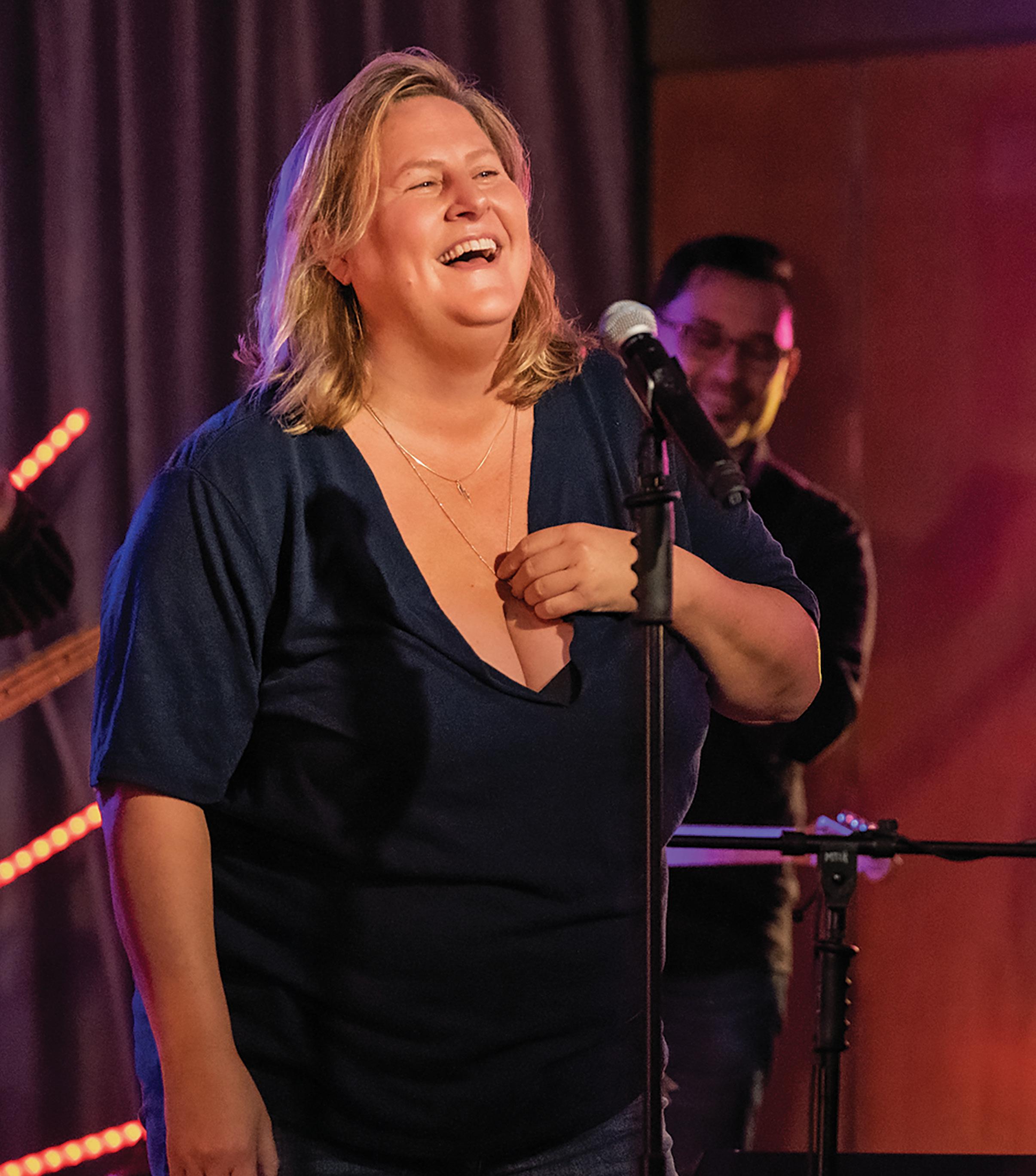
Singing it out
‘Somebody, Somewhere’ star honed musical talent at ASU
ARTS
30 SPRING 2024
In the first season of the quirky HBO Max small-town comedy drama “Somebody, Somewhere,” the main character, Sam, belts out a transcendent version of “Piece of My Heart” in a cathartic moment where she feels the power of her voice.
Bridget Everett, ’95 BA in vocal performance, the star and executive producer, created the comedy. The show released its second season last spring and is in season 3 production.
The hit show comes years into Everett’s career as a successful cabaret singer, stand-up comedian and actress in New York, starring in episodes of “Inside Amy Schumer” and “Girls” and the movie “Trainwreck.”
In season 2, Everett includes a subtle nod to ASU; the voice teacher in the show is named after Everett’s high school voice teacher and ASU voice teacher Darleen Kliewer-Britton.
Everett’s advice to music majors on finding a role in a show that features music?
“If your goal is opera or music theater, that’s great,” she says. “Study hard, learn your languages, know your lines, show up prepared. But if you want to try something else or something different, the important thing is to recognize what makes you different and what makes you unique and really foster that and really lean into that.” ��
Learn more at musicdancetheatre.asu.edu
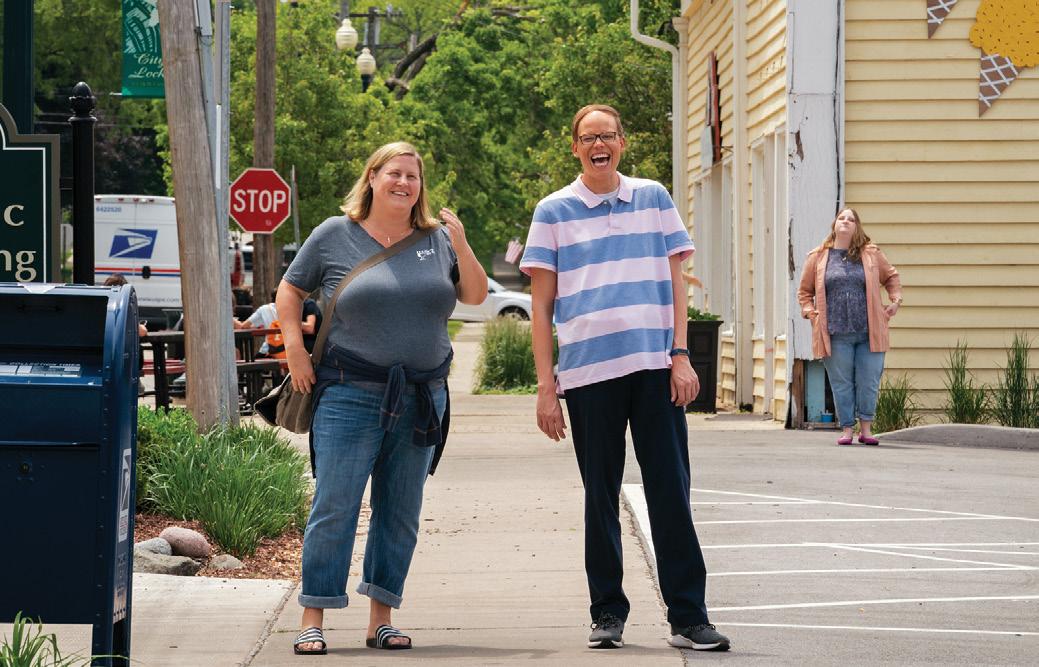
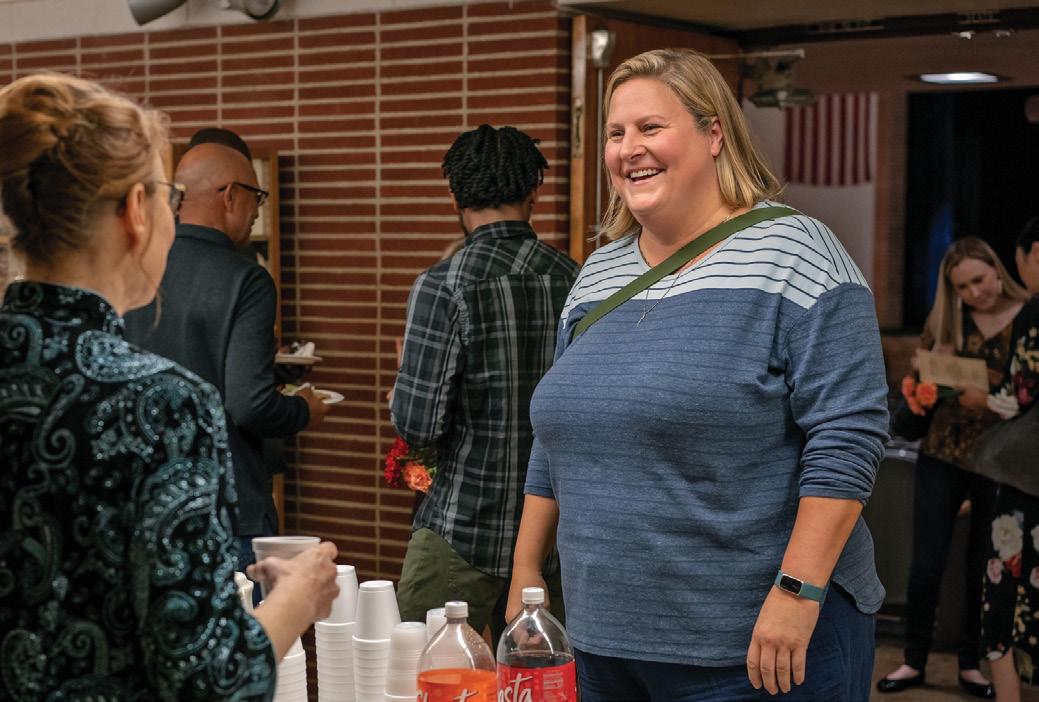
Some notable Hollywood alumni
Dustin Lee
Abraham , ’94 BA in communication studies, screenwriter and producer for “CSI: Crime Scene Investigation”
Amanda Brown , ’93 BA in political science, author of “Legally Blonde”
Leigh Brecheen , ’78 JD, advisor and attorney for John Oliver, Rob Delaney, Iliza Shlesinger, Sharon Stone
Michael R. Burns, ’80 BS in political science, vice chairman of Lionsgate Entertainment Corp.
Dan Deublein , ’95 BA in fine arts (theater), actor from “Beverly Hills, 90210”
Michael Helfant, ’78 BS in political science, former Marvel Studios president and COO
Michelle Randolph , ’23 BA in film studies, star in “1923” series as Elizabeth Strafford
ASU THRIVE MAGAZINE 31 COURTESY OF WARNER BROS. STUDIO
From top: One of the show’s themes is Sam’s growing friendship with Joel, played by Jeff Hiller. The show is set in Manhattan, Kansas, where Everett grew up.

NEW ECONOMY
1 of 4 Google fellows in privacy and security
Kyle Zeng, a PhD student in the School of Computing and Augmented Intelligence, won the elite 2023 Google PhD Fellowship and is one of only four of the 2023 Google fellows worldwide in privacy and security. The fellowship provides funding for education and research and a mentor at Google.
A standout in his area of cybersecurity, previously Zeng interned at UC Santa Barbara, and has won several hackathon competitions for finding solutions for undiscovered system vulnerabilities.
“With this type of vulnerability, attackers can compromise a victim’s system without them doing anything — not even clicking a link. It allows attackers to steal critical information, (like) bank accounts, from a victim, track their locations, record their conversations and more,” he says.
Cybersecurity is one of the new economy’s drivers of high-tech jobs, along with AI, semiconductors and others.
Learn more at scai.engineering.asu.edu .
32 SPRING 2024
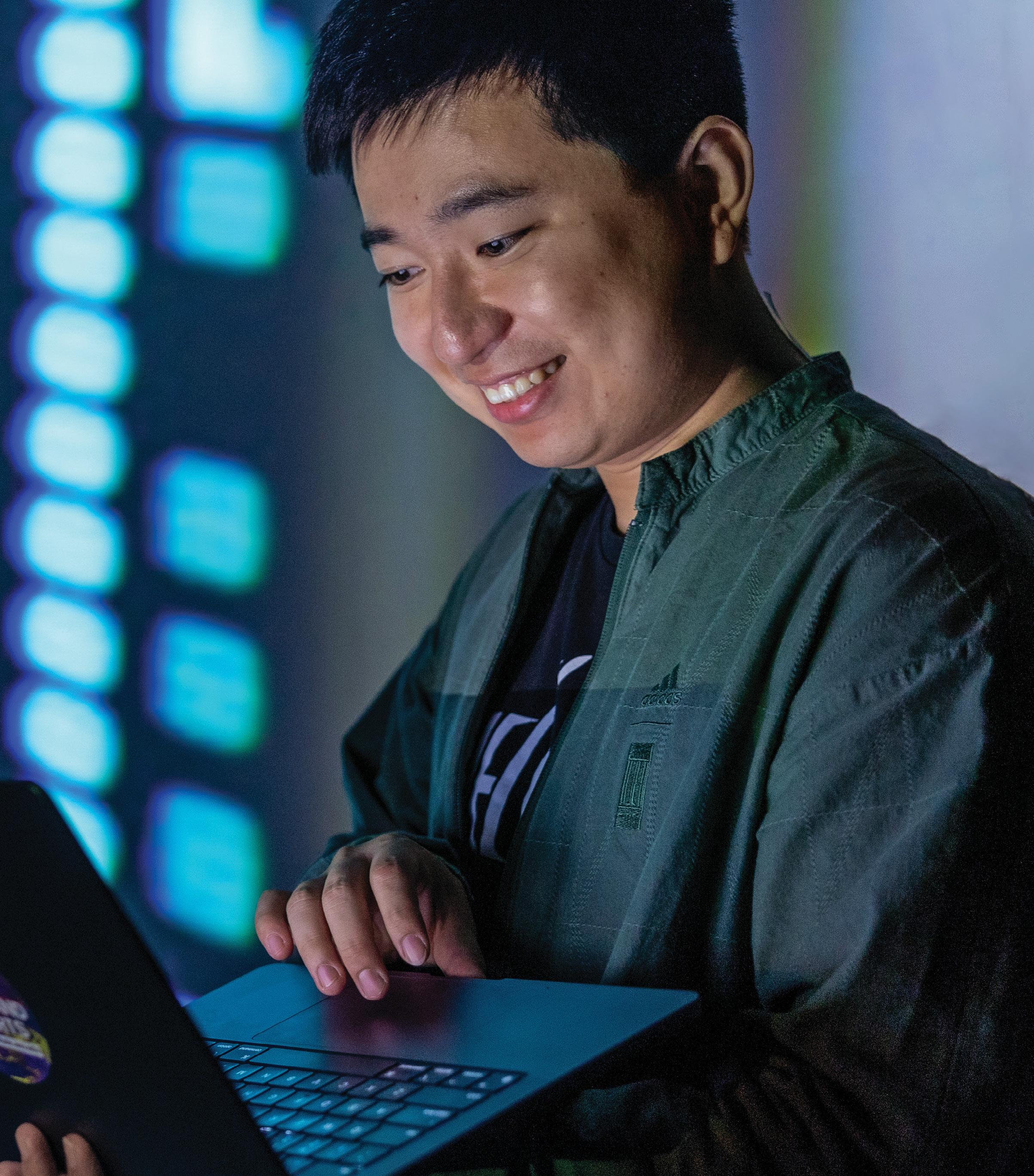
20 years of California innovation
Page 34
Economic forecast for 2024
Page 39
ASU THRIVE MAGAZINE 33 SABIRA MADADY/ASU
Graduate student Kyle Zeng specializes in protecting networks from getting hacked by criminals.
Economy
Golden State Innovation in the
Our inclusive mission to help people succeed knows no state boundaries
Our locations in California have continually welcomed thousands of students from across California, the nation and the world to study film, fashion, journalism, business and hundreds of other disciplines. In California, ASU offers the power of a public, internationally recognized research institution and the unique ability to develop a workforce of highly skilled master learners and innovative leaders ready to tackle any challenge.
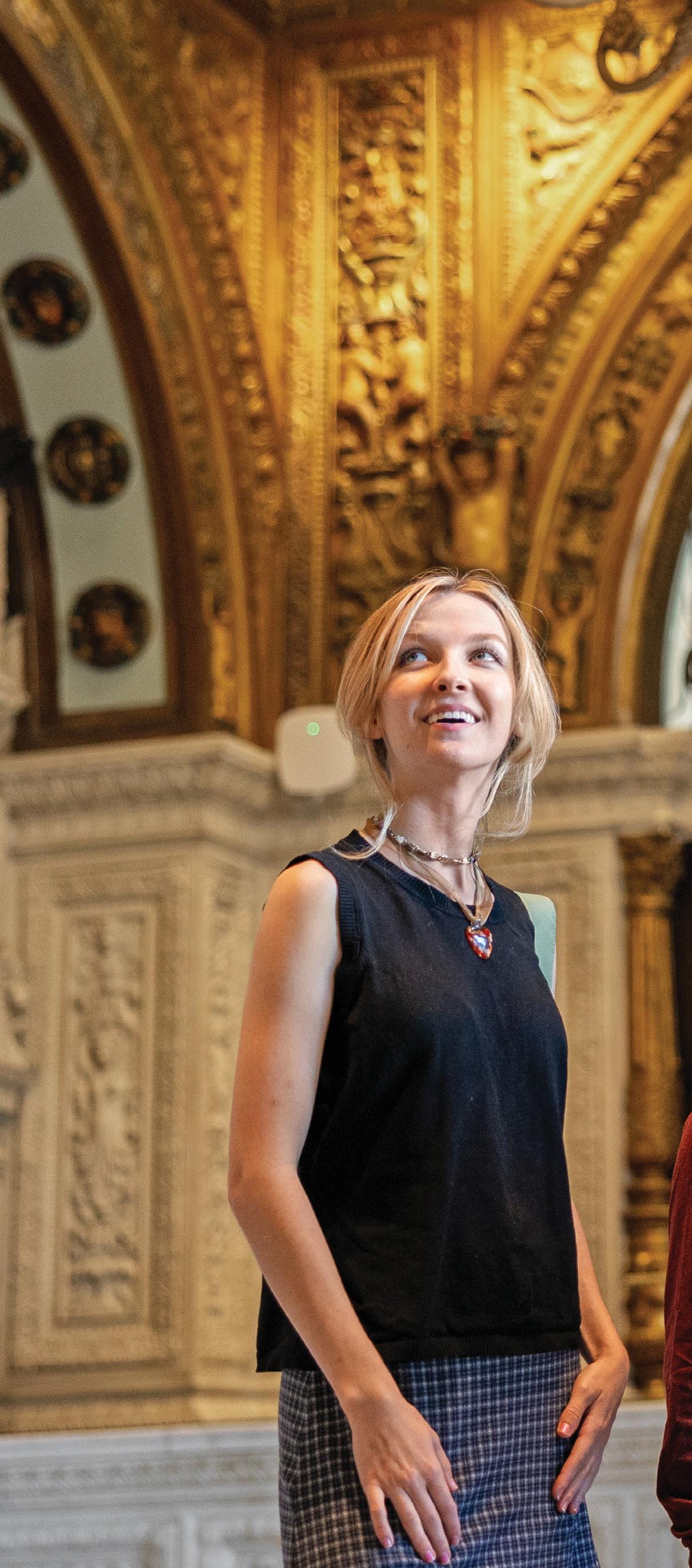
SHillSt W14thSt WallSt SOliveSt SHillStW12thSt W14thPl SanteeSt HopeStSPembroke LnCameronLn CatesbyLn MargoSt HopeSt MidwayPl SSpringSt WerdinPl MidwayPl E11thSt E11thSt SBroadway SBroadway WPicoBlvd WPicoBlvd FlowerSt VeniceBlvd WOlympicBlvd WOlympicBlvd FlowerSt W8thSt W8thSt SLosAngelesSt W9thSt JamesM.WoodBlvd ChickHearnCt SGrandAve SGrandAve SOliveSt SHillSt SMainSt SMainSt ASU California Center Fashion District ASU California Center Broadway Event Center Planar LCD Studio LA Convention Center ASU California Center Grand Grand Hope Park ASU FIDM Library and Museum Sun Devil Campus Store Broadway Palace Student Housing Fitness center Study library
The ASU California Center in downtown Los Angeles is nestled in the center of the fashion, entertainment, jewelry and financial districts. 34 SPRING 2024 ECONOMY
ASU Local students visit the historic lobby of the ASU California Center Broadway. In 2021, ASU completed an award-winning preservation and restoration project on the building, designed by renowned architect Julia Morgan in 1913.
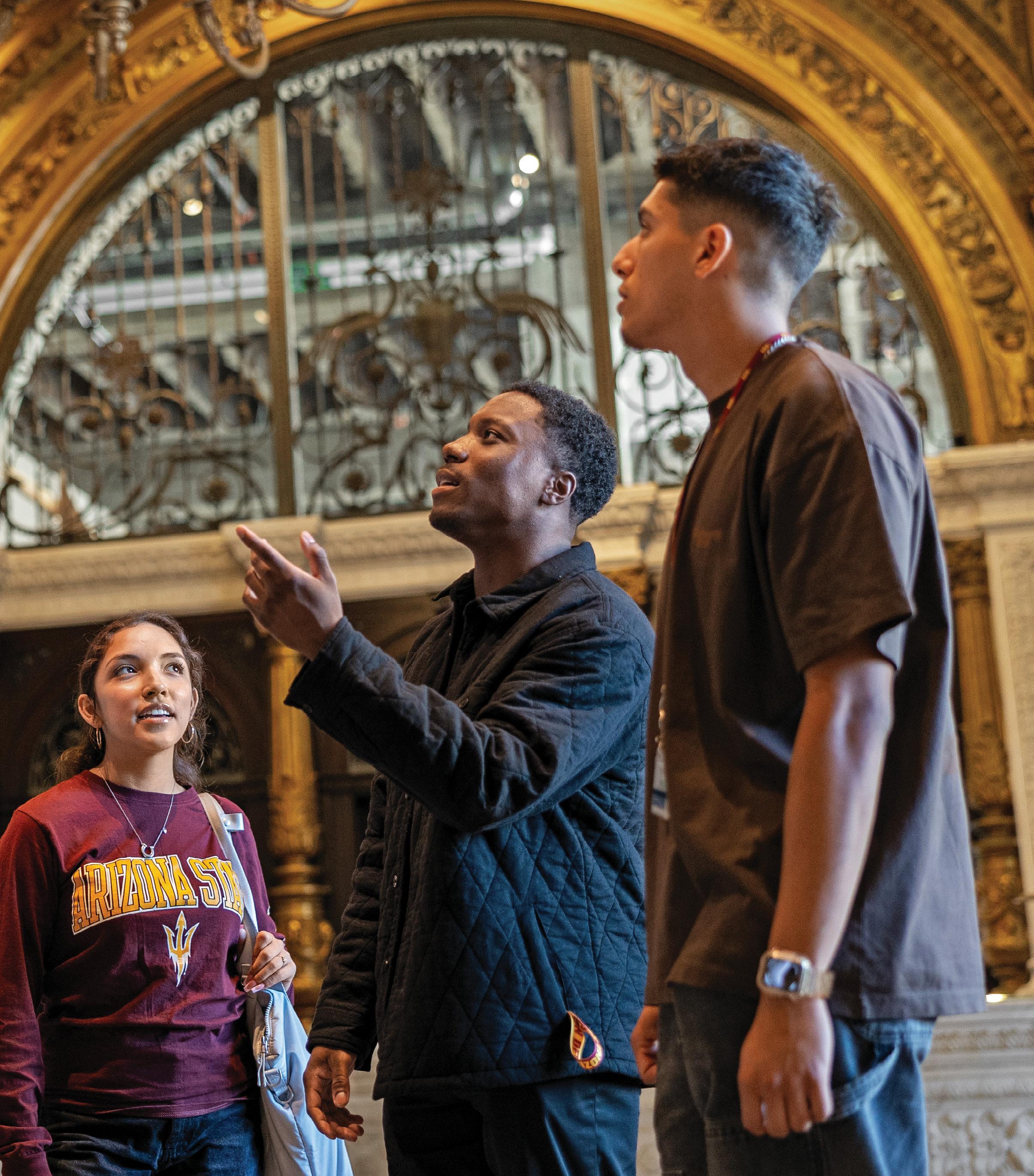
ASU THRIVE MAGAZINE 35 SABIRA MADADY/ASU
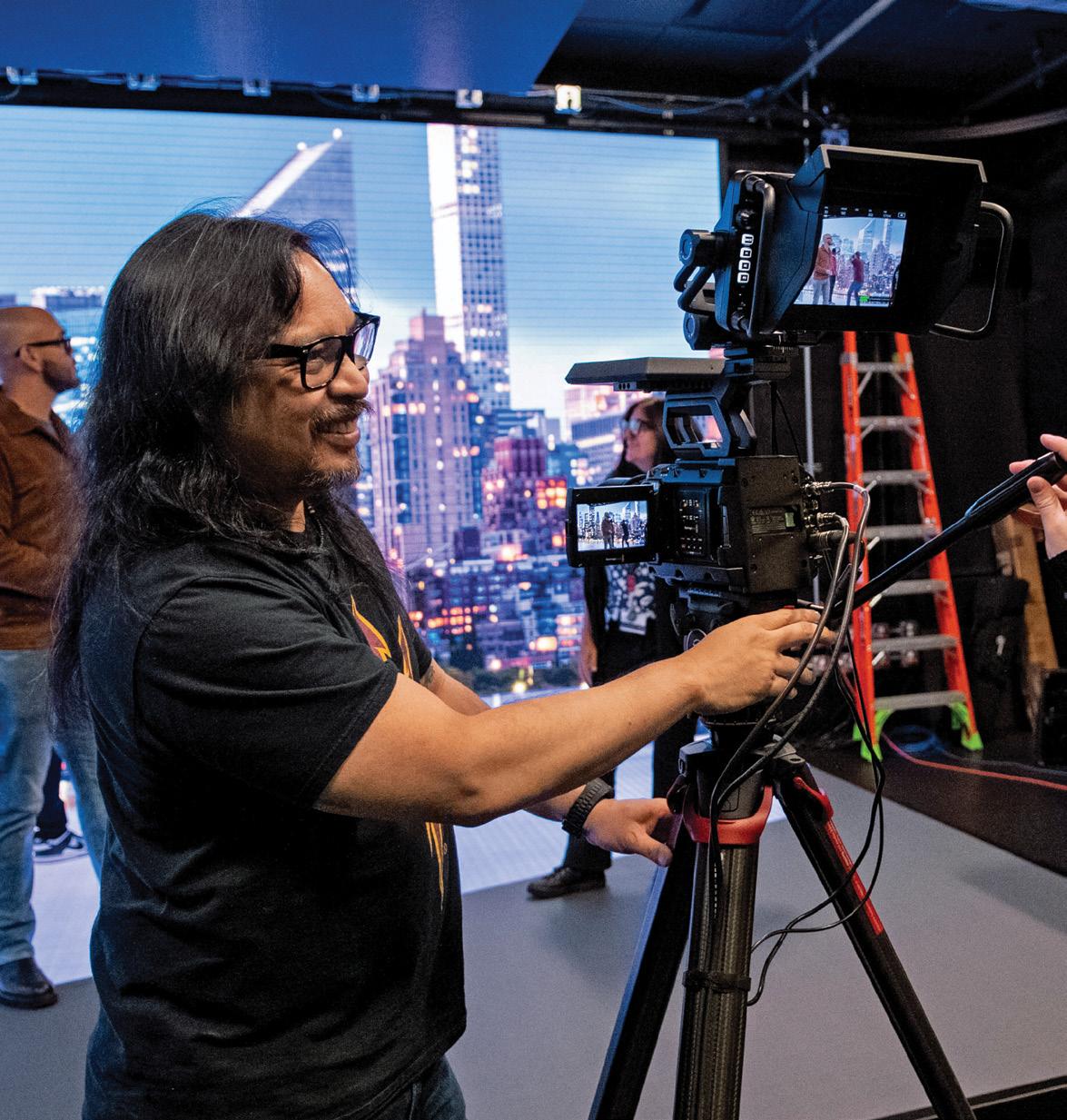
The narrative and emerging media program immerses students in the development of content in augmented, virtual and extended reality in LA.

“This new form of storytelling can offer a visceral and positive impact on our perception of the world,” says program director Nonny de la Peña.
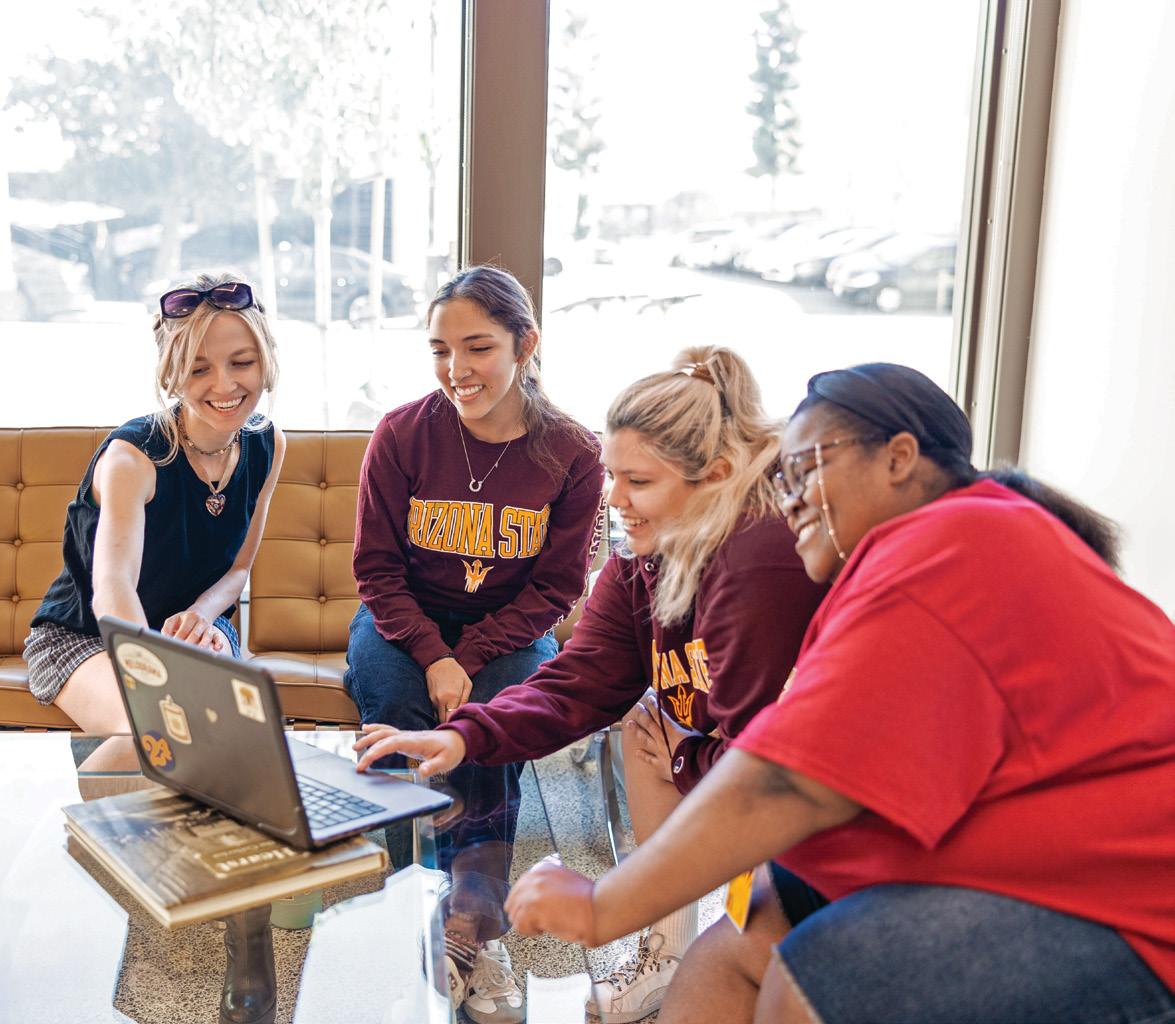

Fashion students in ASU FIDM learn in stateof-the-industry classrooms on professional equipment and have coursework embedded with industry partners across LA.
ASU Local students can choose from 160 high-quality bachelor’s degree options in a highly supportive environment in LA.
36 SPRING 2024 CAMILLE MISTY/ASU
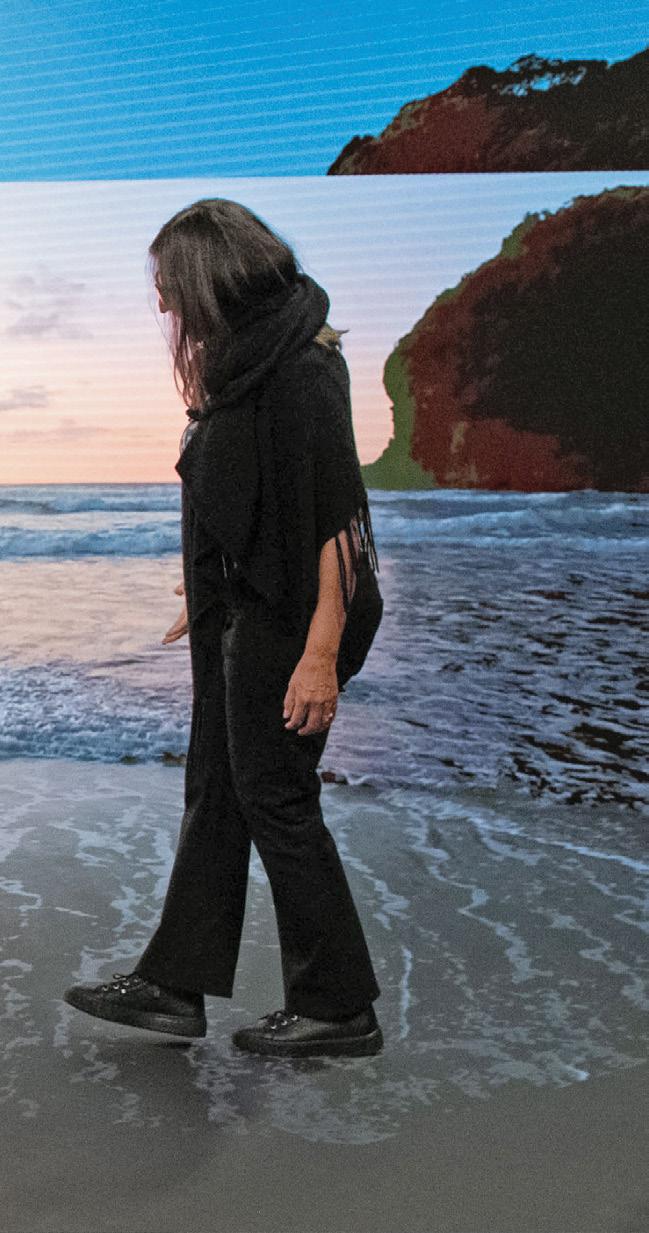
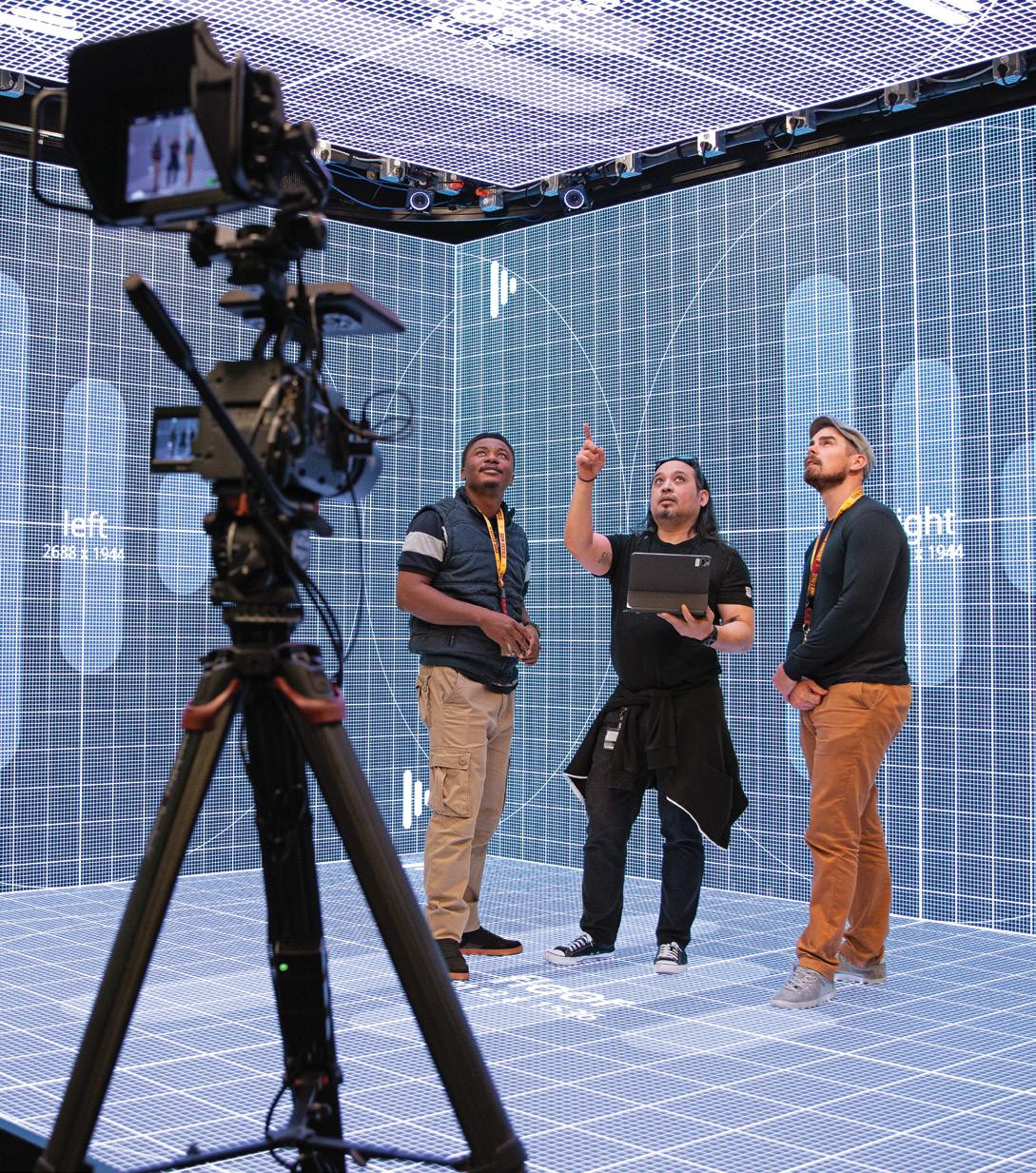

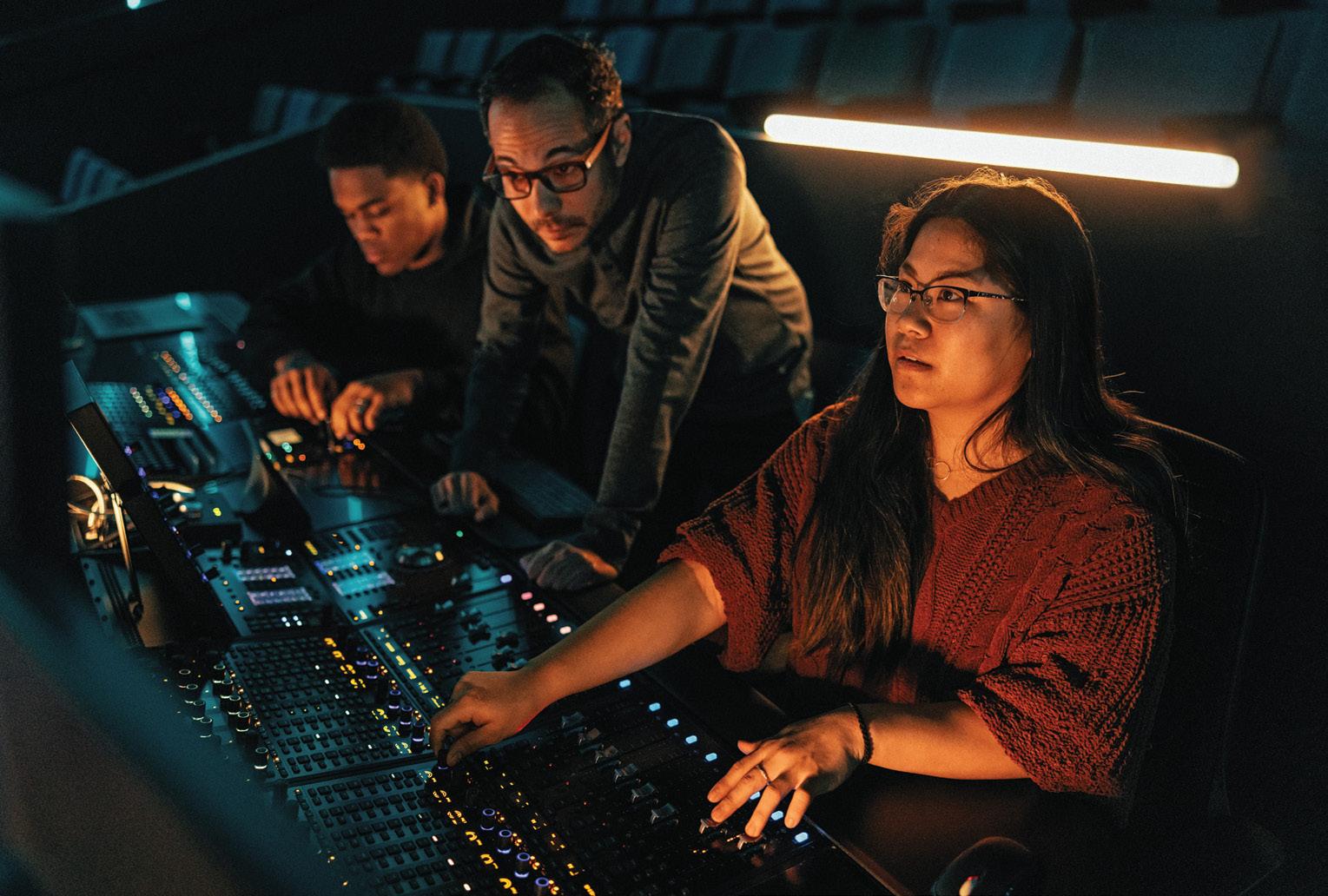
ASU has enrolled
105,000 students from California in the last 23 years
23,000
In 2024, over 23,000 students from California across all locations and online are enrolled at ASU
65,000
ASU alumni live in California
ASU has partnered with all 116 California community colleges to deliver over 400 pathways for students to easily transfer into ASU
ASU has been on the ground in California for 20+ years
LA students in The Sidney Poitier New American Film School access Hollywood technology through partnerships with the John Hughes Institute and Dreamscape Immersive –the world’s leading virtual reality company.
ASU THRIVE MAGAZINE 37 ARMAND SAAVEDRA/ASU
ASU journalism students in the Cronkite News LA Bureau learn on the equipment and also create award-winning news and sports content.
CALIFORNIA
Grad launches legal career in LA
The practice of law and the practice of theater have one major thing in common: performance.
That’s according to Zach Rufa, ’23 JD. Before attending ASU’s Sandra Day O’Connor College of Law, Rufa was a playwright and artist living and working in New York.
While at ASU Law, he thrived. He pursued two certificates alongside his JD: one in trial advocacy and one in law, science and technology with an emphasis in intellectual property. Additionally, Rufa took advantage of ASU’s Los Angeles externship program and plans to stay in California. After taking the bar exam, he will join Knobbe Martens, a preeminent IP law firm, as an associate.
Learn more about top-ranked programs at law.asu.edu .
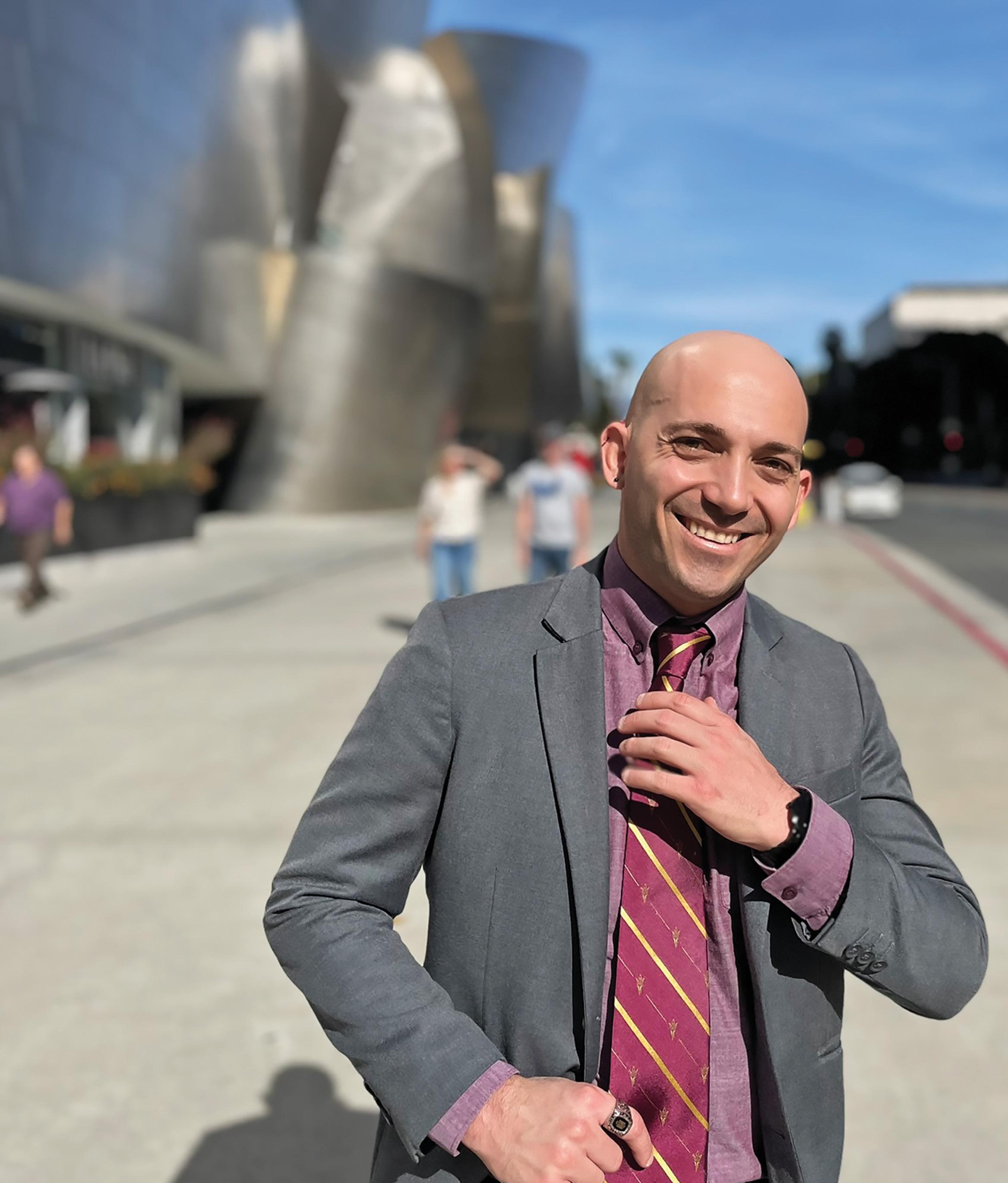
“Law had been a great passion of mine from a young age .”
— ZACH RUFA, ’23 JD, NOW LIVING IN LA AND EXCITED TO BEGIN HIS LEGAL CAREER IN CALIFORNIA
ECONOMY 38 SPRING 2024 COURTESY OF ZACH RUFA
economic outlook for 2024 Arizona
What you need to know
Arizona magnetism
“Productive workers and businesses want to come and stay in Arizona,” says Dennis L. Hoffman, director of ASU’s Office of the University Economist and the L. William Seidman Research Institute at ASU’s W. P. Carey School of Business.
5 key industries
Health care, leisure and hospitality, wholesale trade, professional/tech and construction are responsible for 75% of the 66,500 private Arizona jobs added in Q3 2023.
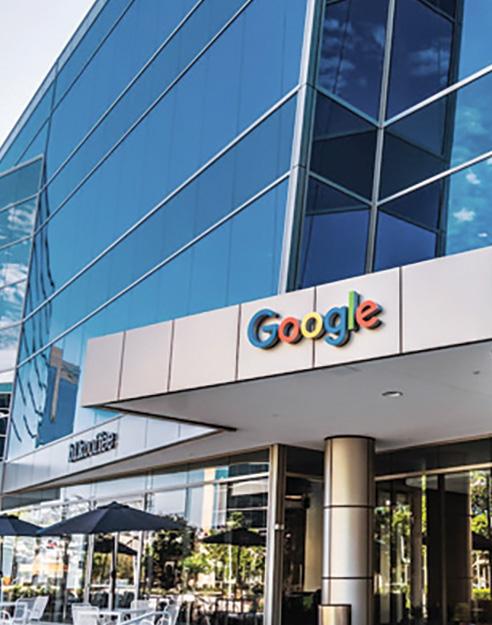

ASU is part of a network of organizations working to build the future of Arizona. By connecting with local governments, community leaders and private industry, together we drive regional economic development that promotes human well-being. In this forecast, ASU experts and partners share their outlook for the year ahead.
The Arizona economy looks strong, outperforming the national economy, according to economists who met in December at the longest-running, most trusted economic forecasting event in the Valley, the 60th annual ASU/PNC Bank Economic Forecast Luncheon
“Greater Phoenix has become a top global destination for the semiconductor industry and innovative companies among advanced manufacturing, bioscience and software technology,” says Chris Camacho, president and CEO of Greater Phoenix Economic Council.
“Where we are today is the result of decades of intentional planning between local municipalities and partners across the region including ASU,” he says.
“Greater Phoenix is now entering the next economic frontier where we intend to become home to the next wave of game-changing companies, creating quality jobs and driving the region’s relentlessly innovative spirit.”
ASU THRIVE MAGAZINE 39 COURTESY OF AZ BIG MEDIA
Companies coming to the Valley Google, Meta, DoorDash, Mechanical Keyboards, Align Technology, according to the Arizona Commerce Authority.

Semiconductor investment
Arizona leads the nation with $40B coming in since 2021
Health care Startups
“Arizona offers businesses friendly tax and regulatory practices that will draw new commerce and help sustain the state’s economy,” Hoffman says.
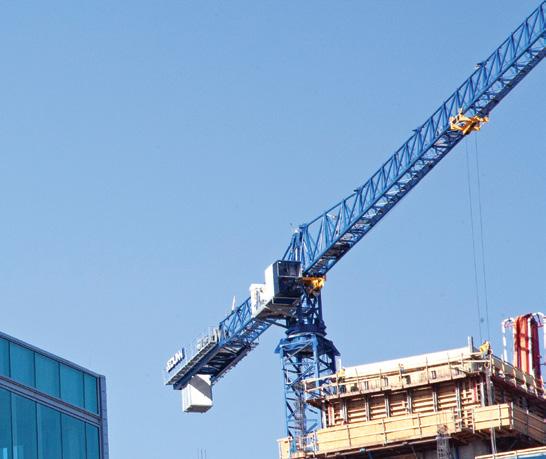
National outlook
When the Fed first increased rates in March of 2022, most analysts expected the economy would spiral into recession from a tighter monetary policy. Dire warnings of spiking unemployment and a sharp drop-off in consumer spending became commonplace. But even as the benchmark interest rate was raised 11 times, unemployment actually fell and job creation surged. Wage growth at year-end 2023 (3.8%) outpaced inflation rates (3.3%), according to the U. S. Bureau of Labor Statistics.
Consumer spending has been particularly important in keeping the economy vibrant, and the most

Twice as many new jobs as a decade ago. “Health care appears to be where the action is,” Hoffman says. “It’s very, very strong.”
Construction Wholesale trade
Added around 4,800 jobs in 2023, up 2.5% to almost 200,000 construction workers, the most in 15 years
recent surveys show consumer confidence on the rise. But some polls reveal Americans feel frustrated by aspects of the current economy. Although inflation has been reduced, prices for staples such as groceries remain some 15% higher than two years ago, according to the BLS.
“Based on the trajectory of indicators we see now, an economic soft landing seems more and more likely,” says Lee McPheters, editor of the Western Blue Chip Economic Forecast and director of ASU’s Economic Outlook Center in the W. P. Carey School of Business.
7,300 new jobs in 2023, second in the country
Unemployment to 3.7%

Wages rising
Read the Western Blue Chip forecast from ASU’s Seidman Institute at seidmaninstitute.com/western-blue-chip.
40 SPRING 2024
“This has been a scientific leap. Combining data collected in different ways is very challenging.”
— MARY DONOVAN, AN ASSISTANT PROFESSOR IN THE CENTER FOR GLOBAL DISCOVERY AND CONSERVATION SCIENCE

SEA STUDIES
First-of-its-kind study shows how herbivore fish are crucial for Hawaii’s coral reefs
When the state of Hawaii set new rules regulating fishing along its coasts, ASU’s Mary Donovan’s research informed the decision. Donovan published the results of 10 years of research that show that a key to preserving the reefs are the herbivorous fish that control the growth of algae in corals. Her research was made possible in part by the Hawaii Monitoring and Reporting Collaborative, which drew on more than 20,000 surveys from 130,000 sites around Hawaii.
Her study is the first of its kind for the aggregation and data analysis of numerous surveys and sites and required collaboration from the multiple agencies and institutions that monitor Hawaii’s reefs. Learn more at globalfutures.asu.edu/ gdcs/our-impact/programs .
Ecosystem
Don’t flee the Southwest just yet Page 42
Soil’s secret web of life Page 48
ASU THRIVE MAGAZINE 41
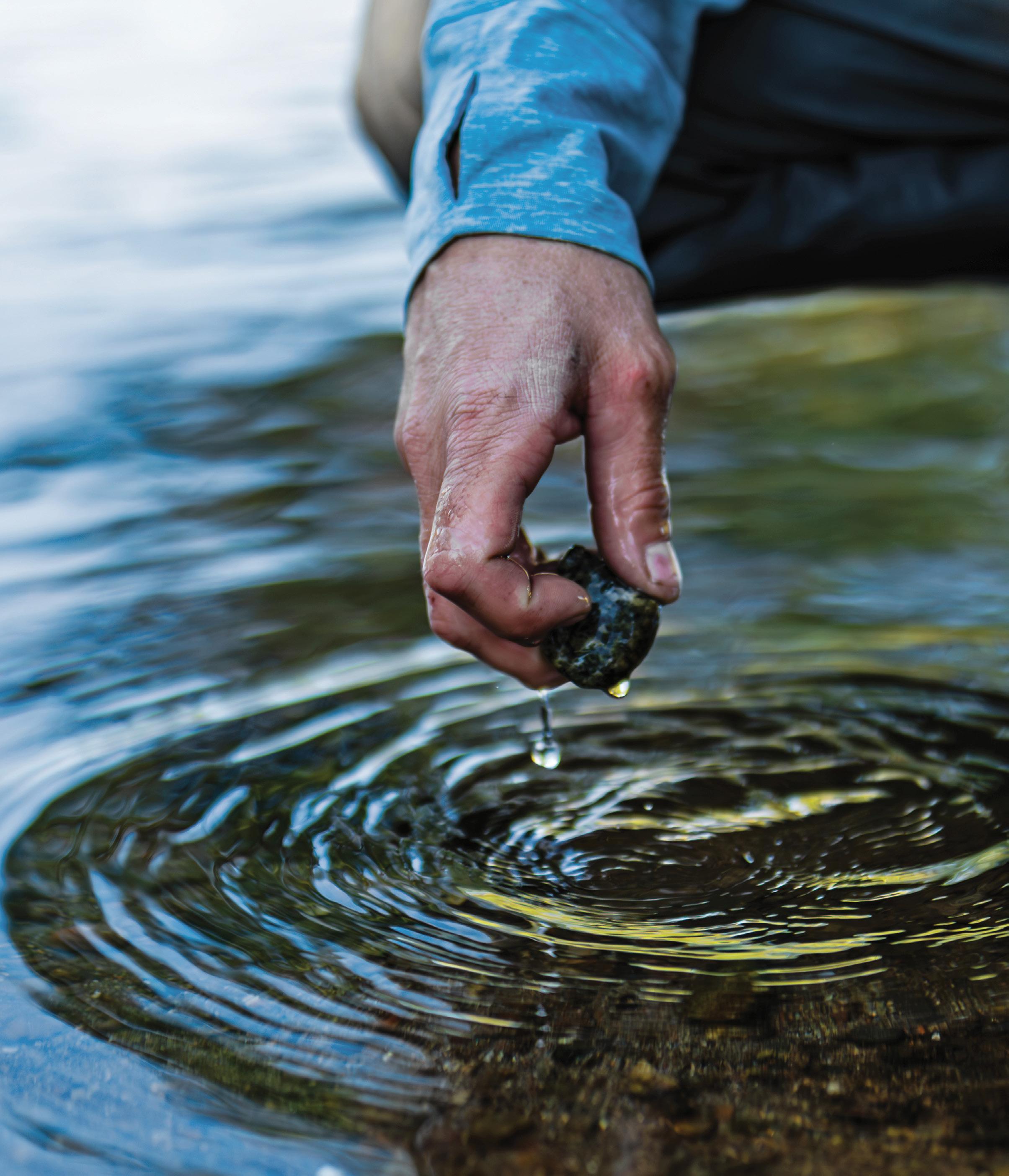
Don’t flee the
Southwest
42 SPRING 2024
ECOSYSTEM
Story by TOM ZOELLNER
Photos by CHRIS GOULET AND SABIRA MADADY
This summer, when the temperature hit 110 degrees Fahrenheit or above in Phoenix for 31 straight days, many were fretting about the Southwest’s prospects in the age of climate change. A writer for The Atlantic asked, “When Will the Southwest Become Unlivable?” Bloomberg wondered, “How
Long Can We Keep Living in Hotboxes Like Phoenix?”
The foregone conclusion seemed to be that the region was heading for a crash — destined to become an overpopulated, unlivable dead zone, plagued by ranch foreclosures, unemployment, water wars and heat deaths.
As a writer who has studied the Southwest’s history and spoken to some of its top environmental experts this year, I see its future differently — not as a hellscape but as an opportunity for centuries of climate ingenuity and adaptation to be put to good use. For generations, the people who were determined to come here have found ways to cope and even thrive.
The Hohokam people dug extensive networks of canals along the Salt River, while the scienceminded Hopi up north grew corn in the arid lowlands. A later generation of Americans built a chain of megadams on the Colorado and other rivers to create a dependable supply of water for households and crops. My great-great-grandmother used to dip bedsheets into a canal and hang them on the sides of the porch of her Phoenix boardinghouse to create a primitive cooling system for sleeping outside in the hottest months.
While our era of shrinking water resources and rising temperatures will undoubtedly test Southwestern
just yet
Tom Zoellner is a journalist, the author of “Rim to River: Looking Into the Heart of Arizona” and a fifthgeneration Arizonan.
Reprinted from The New York Times.
First appeared Dec. 31, 2023. From The New York Times. ® 2023
The New York Times Company. All rights reserved. Used under license.
ASU THRIVE MAGAZINE 43
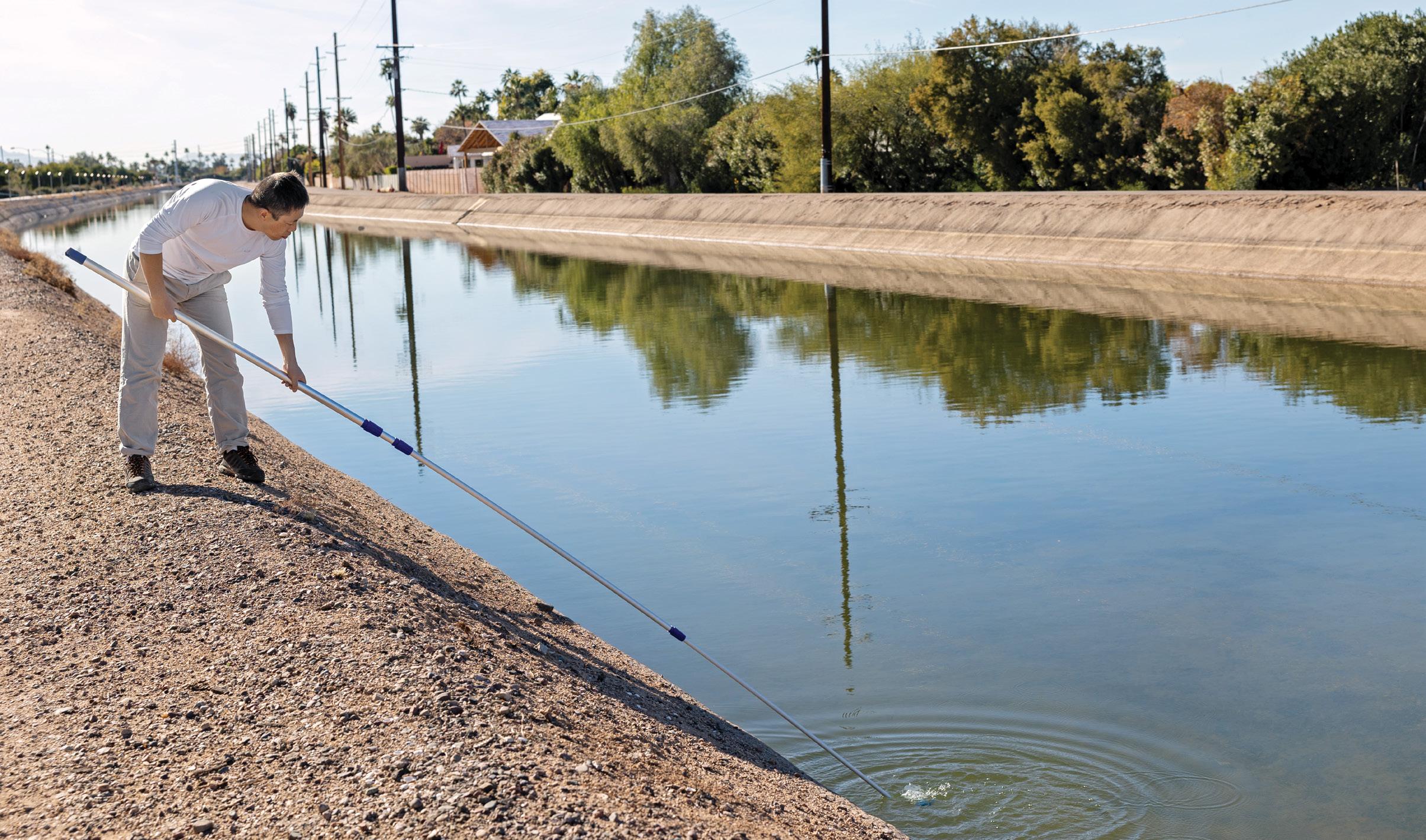
states, the question is not when will this region become unlivable. It is: Are we willing to make certain adjustments to live on a new hotter and drier frontier?
The biggest vulnerability may lie in what has traditionally been the biggest strength for the Southwest, at least in economic terms. The low-service and low-tax philosophy of state and local governments, combined with an abundance of former cowboy ranges, made places like Arizona and Nevada a haven for those who couldn’t afford homes in California and Hawaii. Fortune 500 homebuilders stamped out tens of thousands of identical houses with tile roofs faster than Liberty ships in wartime, and the booming exurbs with loose zoning gave the Phoenix metro area a geographical footprint more than twice the size of Kuwait.

But even before July’s heat dome settled over Phoenix, Arizona was being forced to reconsider its pedalto-metal economic model that has kept the state growing for the past seven decades, after state officials said they would limit building permits for new housing in some areas because of groundwater shortages.
It’s not just groundwater that’s stressed: Consistent lack of snowpack in the Rocky Mountains has thinned out the Colorado River’s flow, upon which 40 million people in seven states depend. After calling on states to make major cuts in their water use, the Interior Department recently agreed to pay jurisdictions in Nevada, California and Arizona a total of $1.2 billion to use less river water in the next three years. A majority of the reduction will come from farmers raising cattle food like alfalfa and hay, the biggest water
gobblers of the Southwest.
And as the water crisis grows more dire, the federal and state governments are likely to have to pay off more farmers to have enough water left over to sustain the Southwest’s cities. “There’s no way you can have 400 farmers in the Imperial Valley taking all the water away from Phoenix and the L.A. basin,” according to Brad Udall, a climate research scientist at Colorado State University. As water resource managers like to say, the Southwest’s cities could disappear tomorrow and there would still be a water shortage, thanks to the thirsty farms and hungry cows. One way or another, desert agriculture must shrink and adapt to what remains. But there’s reason for hope.
Take Arizona, a state that’s often seen as the epicenter of the crisis because of its steep population
44 SPRING 2024
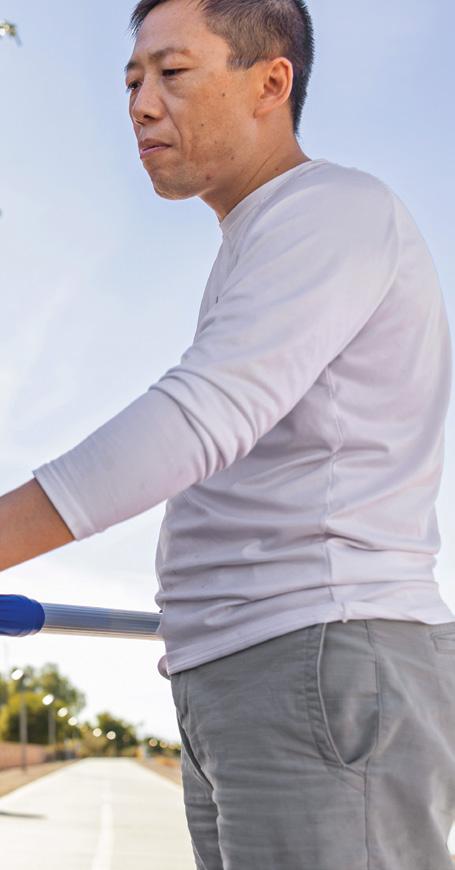


“Arizona now uses 3% less water than it did in 1957, despite having a population that’s mushroomed more than 555% since then .”
Mary Ferguson, graduate research assistant, and Xiangmin Sun, postdoctoral research scholar, both part of the Hydrosystems Engineering Program, collect water samples for analysis to estimate water loss due to evaporation along the Arizona Canal in Phoenix.
growth and the fact that many of the same Arizona counties attracting new residents at a record pace are also the most water starved, experiencing severe droughts far out of proportion to the rest of the country. In spite of this, many environmental experts in Arizona are relatively sanguine about its future because of all the progress the state has made over the last 50 years to conserve its water supply.
Because of a reduction in farmland acreage and better household conservation, Arizona now uses 3 percent less water than it did in 1957, despite having a population that’s mushroomed more than 555 percent since then. Paradoxically enough, the
steady march of master-planned communities to the horizon — an Arizona cliché — provides big hydrological savings because of the conversion of water-guzzling farmland into more parsimonious suburban uses, Sarah Porter, the director of the Kyl Center for Water Policy at Arizona State University, told me.
We now use treated wastewater on golf courses and parks. Phoenix is already building a facility to turn wastewater into high-quality drinking water by 2030. And Southwestern cities have an exceptionally simple solution for curbing residential water use: Charge more for it in the summers. After Phoenix started using this powerful incentive, the
number of homes with front or back lawns went down from nearly 80 percent in the 1970s to about 10 percent today, according to Kathryn Sorensen, a former Water Services director for the city. “That’s a wholesale cultural change,” she said.
In some crucial ways, Arizona will actually be better able to adapt to climate change than many coastal areas of the country. For instance, the cost of building sea walls for U.S. coastal regions will be at least $400 billion, according to the Center for Climate Integrity, while squeezing water out of a desert landscape is relatively cheap in comparison. The only necessary ingredient is political willpower. Public agencies will capture and bank more stormwater in the ground for aquifer recharge, for example, and they can require residents to cover their backyard swimming pools to cut down on evaporation.
ASU THRIVE MAGAZINE 45
Hydrologist Ruby Yaritza Hurtado, graduate research assistant in the Center for Hydrologic Innovations, and Jason Jedinak, laboratory manager for the Arizona Water Innovation Initiative, testing the results of water conservation measures.
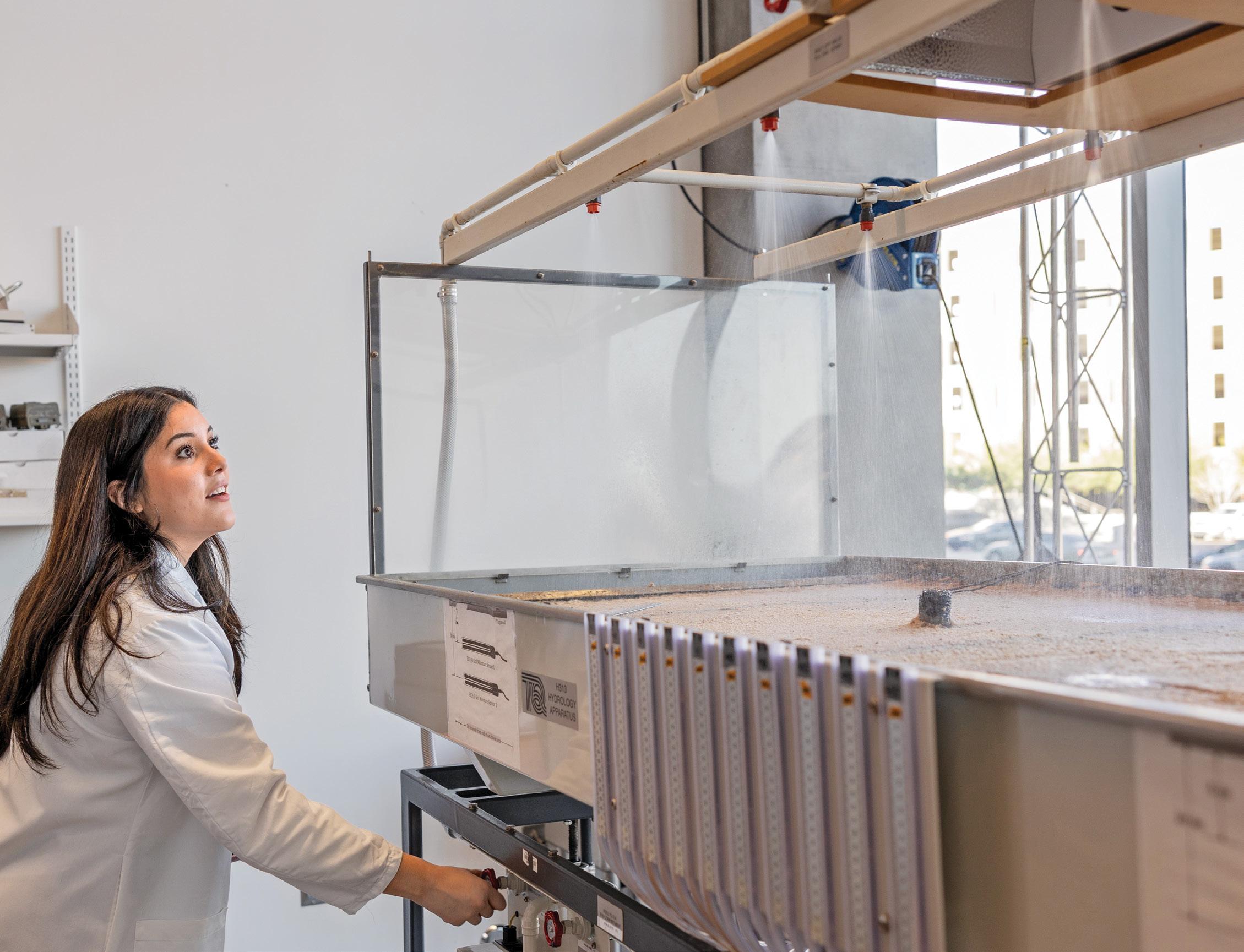
The historic adaptability of the Southwest can be applied in multiple other ways. Cities can reduce the heat-island effect by planting more street trees and even small forests that capture carbon. They can mandate reflective coatings on roofs and asphalt, encourage low-flow showers and toilets and discourage residential lawns, as Las Vegas has done. Tougher zoning codes on the county level can stem the runaway growth of what firefighters call suicide subdivisions built on the edge of drying forests vulnerable to wildfire.
States and cities must also invest in more emergency cooling shelters to protect the homeless and the residents of mobile home parks on the worst days. “There’s many ways we can adjust to a changing climate,” Peter Schlosser, the director of the Julie Ann Wrigley Global Futures Laboratory at Arizona State University, told me. “It doesn’t mean we have to leave the area.”
I think the Southwest will retain its essential characteristic as a tough frontier. Those who want to enjoy it will adapt accordingly, just as they did in previous centuries. ��
Read the original story in The New York Times at nytimes.com.

“In some crucial ways, Arizona will actually be better able to adapt to climate change than many coastal areas of the country.”
46 SPRING 2024

What is biocrust?
It is a mesh of bacteria that, like plants, get their energy from sunlight. Postdoctoral Research Scholar Brian Scott, Assistant Professor Emmanuel Salifu and graduate student Thuong Cao belong to an interdiscipinary team working on ways to help biocrust re-form on top of the desert soil so that loose dirt cannot be blown away in dust storms.
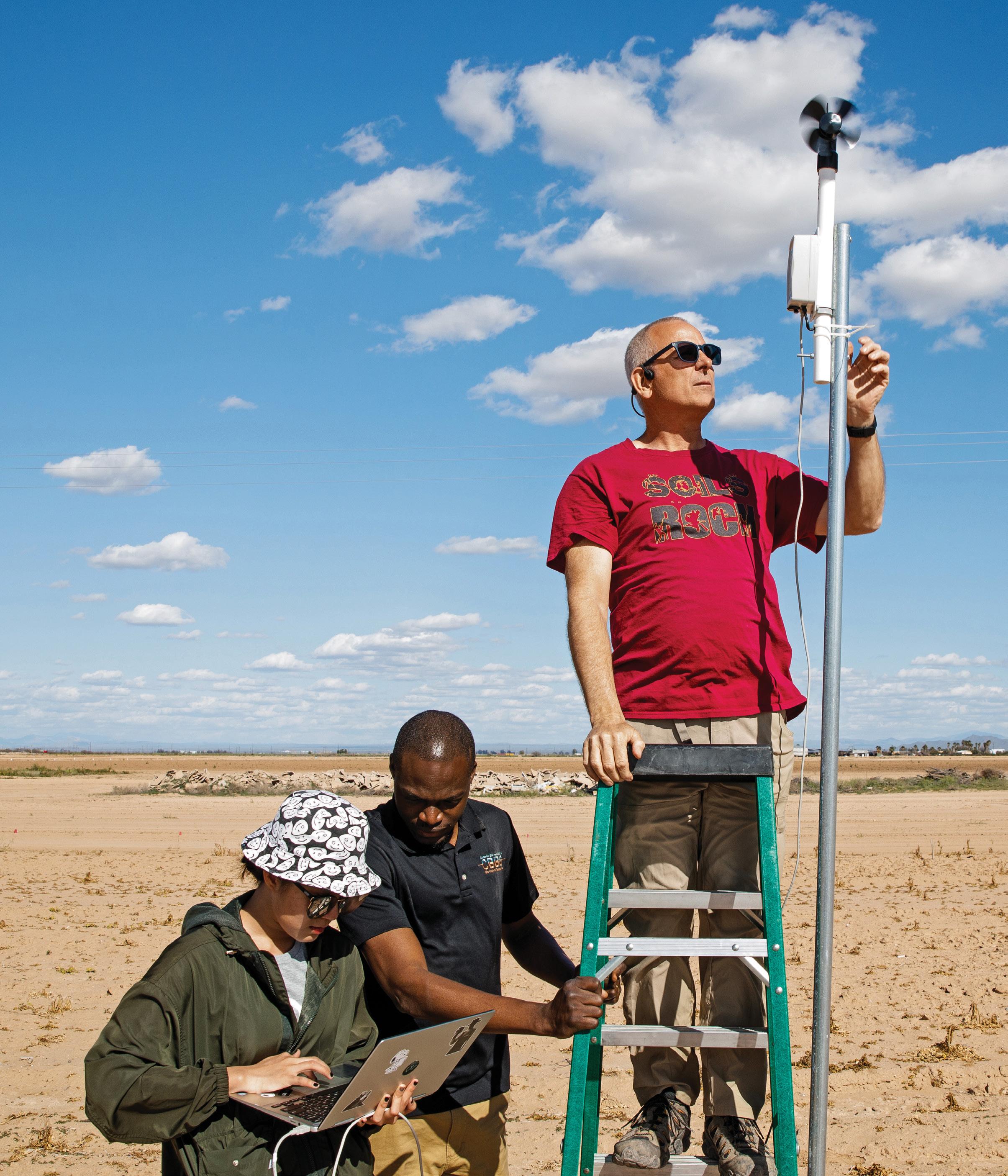
48 SPRING 2024 ECOSYSTEM

Soil’s secret web of life
Biocrust could be key to reducing the Southwest’s dust
Story by MI KALA KASS Photos by AND Y DELISLE
Many people, when they first visit Arizona, expect to find sand on the ground of the famous Sonoran Desert. What they find instead is dust. It’s also a feature of many California landscapes.
Fine as flour, this dust sits atop hardened soil. In strong winds, it can be blown into dust storms, and the results can be severe: irritated lungs and blinded drivers.
A secret web of life resides in that compacted earth. Nurturing this life could be the key to reducing the Southwest’s airborne dust, says Brian Scott, a postdoctoral researcher at the Biodesign Center for Fundamental and Applied Microbiomics.
It can take decades for biocrust to grow back on its own. But the ASU team, part of an interdisciplinary effort directed by Regents Professor Ferran Garcia-Pichel in the Biodesign Center for Fundamental and Applied Microbiomics, is working to reduce that regrowth process to just a year or two. The team is finding ways to cultivate biocrust in the lab that can flourish when replanted in the wild and help restore depleted soil.
Figuring out how to plant biocrust is a long-term solution, but farmers also need a short-term fix for fields they leave fallow. Other members of the team, led by Regents Professor Edward Kavazanjian in the Ira A. Fulton School of Sustainable Engineering and the Built Environment, are working on creating a chemical treatment that hardens the topsoil for a season.
In collaboration with Pinal County farmers, both teams are able to test their solutions in the field.
ASU THRIVE MAGAZINE 49
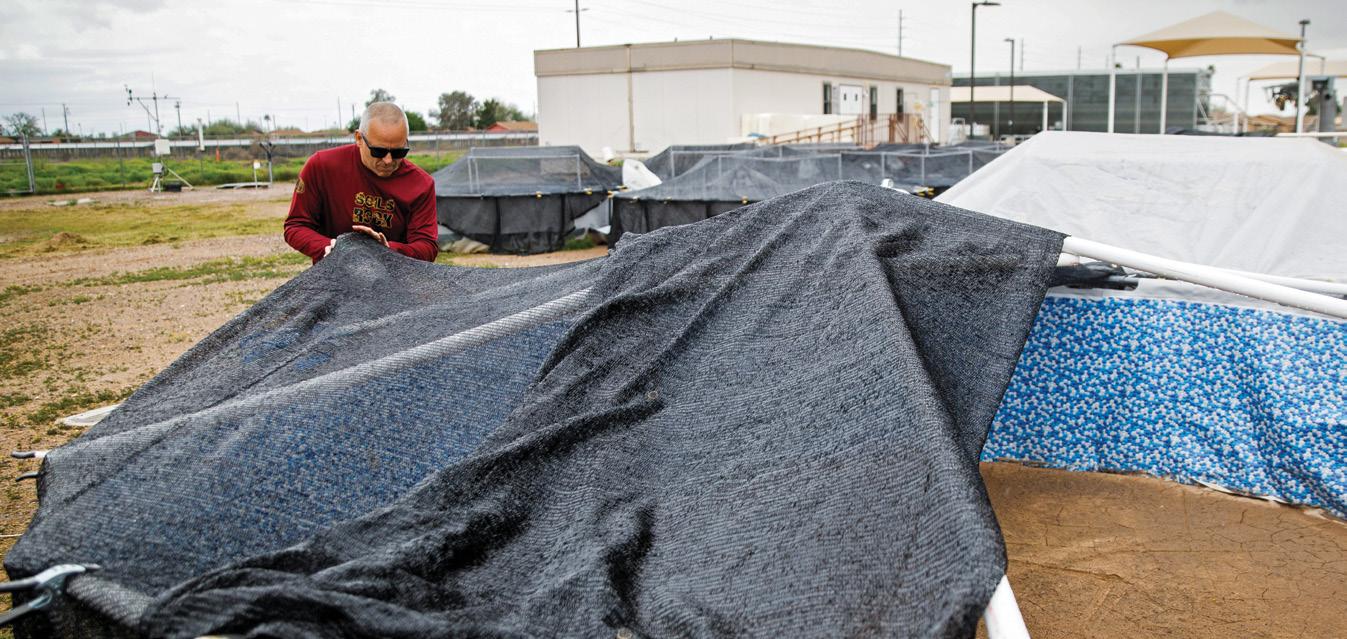

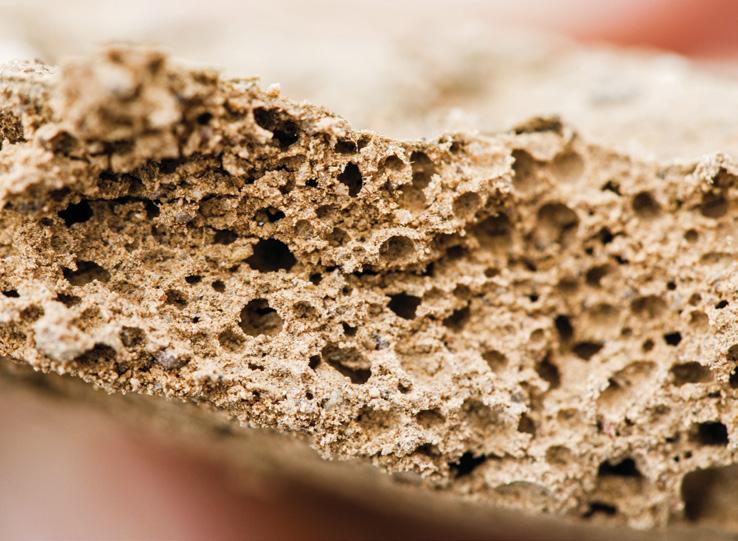
How biocrust forms Biocrust can be found in nearly any place in the world that has a dry climate and little vegetation. In the Southwest’s deserts, biocrust holds down dust like a sticky net.
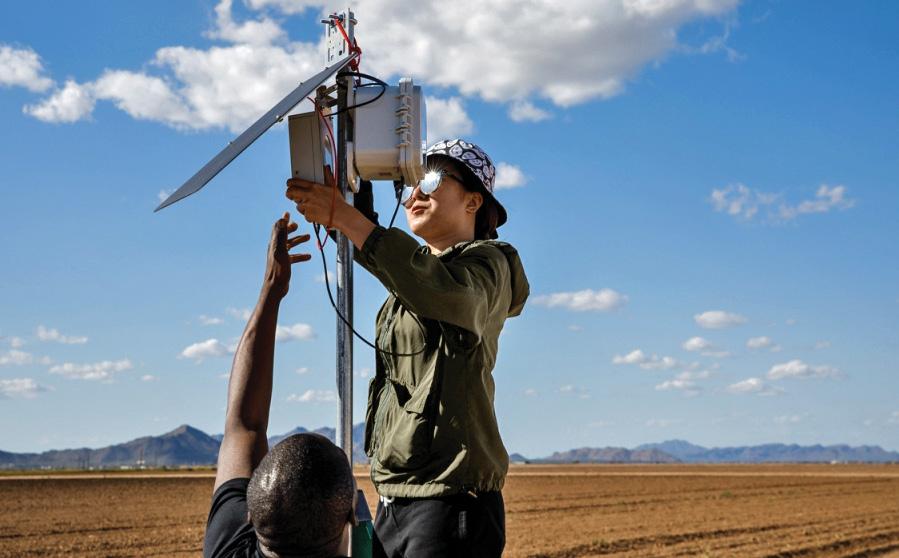
Growing more resilient biocrust
Scott examines one of the biocrust test beds at the Polytechnic campus. He says biocrust grows readily enough in the lab’s controlled settings, but currently, when it’s moved to the wild, it does not do so well, and the team is testing how biocrust growth responds to factors like soil type and bacterial composition in order to grow heartier biocrust that can thrive in harsh desert conditions.

Out in the field
Salifu and Cao install a dust monitor on farmland. Here, they are working on the land of Casa Grande farmer Patrick Dugan, owner of Du-Brook Dairy Inc., to test their solutions.

Watch a video about reducing Arizona dust-storm intensity at youtube.com/ @ASUBiodesign .
50 SPRING 2024

A colony of microorganisms
To make sure all the right bacteria are present in the right amounts, the researchers sequence the DNA of the biocrusts they cultivate.
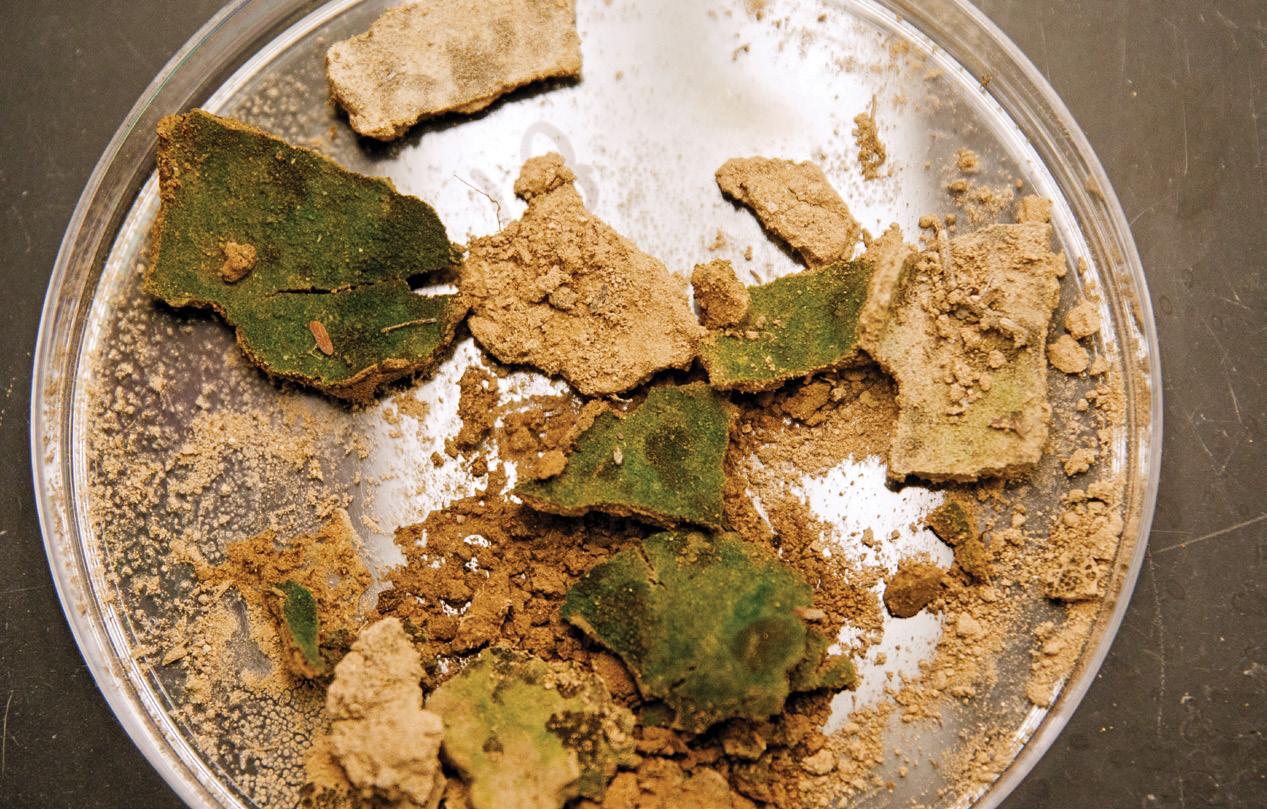
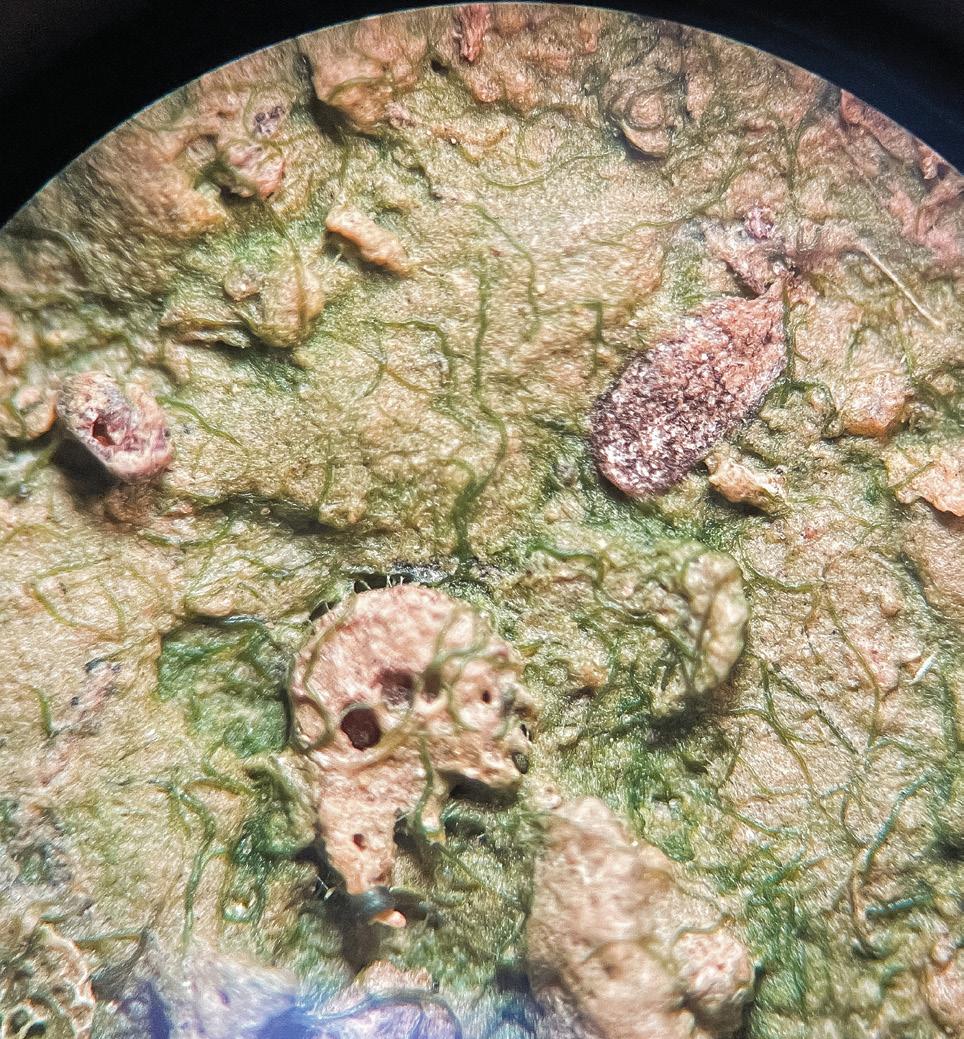
Back in the lab Scott works in Garcia-Pichel’s lab in an attempt to hone biocrust regrowth down to a year or two and to help develop more resilient biocrust that will withstand replanting.
ASU THRIVE MAGAZINE 51

WELCOME
A campus open to the community
Over the years, the university has grown from the small four-room school building it was in the 1890s to a booming institution with campuses in more than six cities. These photos of Old Main demonstrate both growth and how ASU has removed barriers for learners of all kinds, by physically taking down gates and expanding spaces, as well as through innovative programming.
52 SPRING 2024 ASU LIBRARY
circa 1940
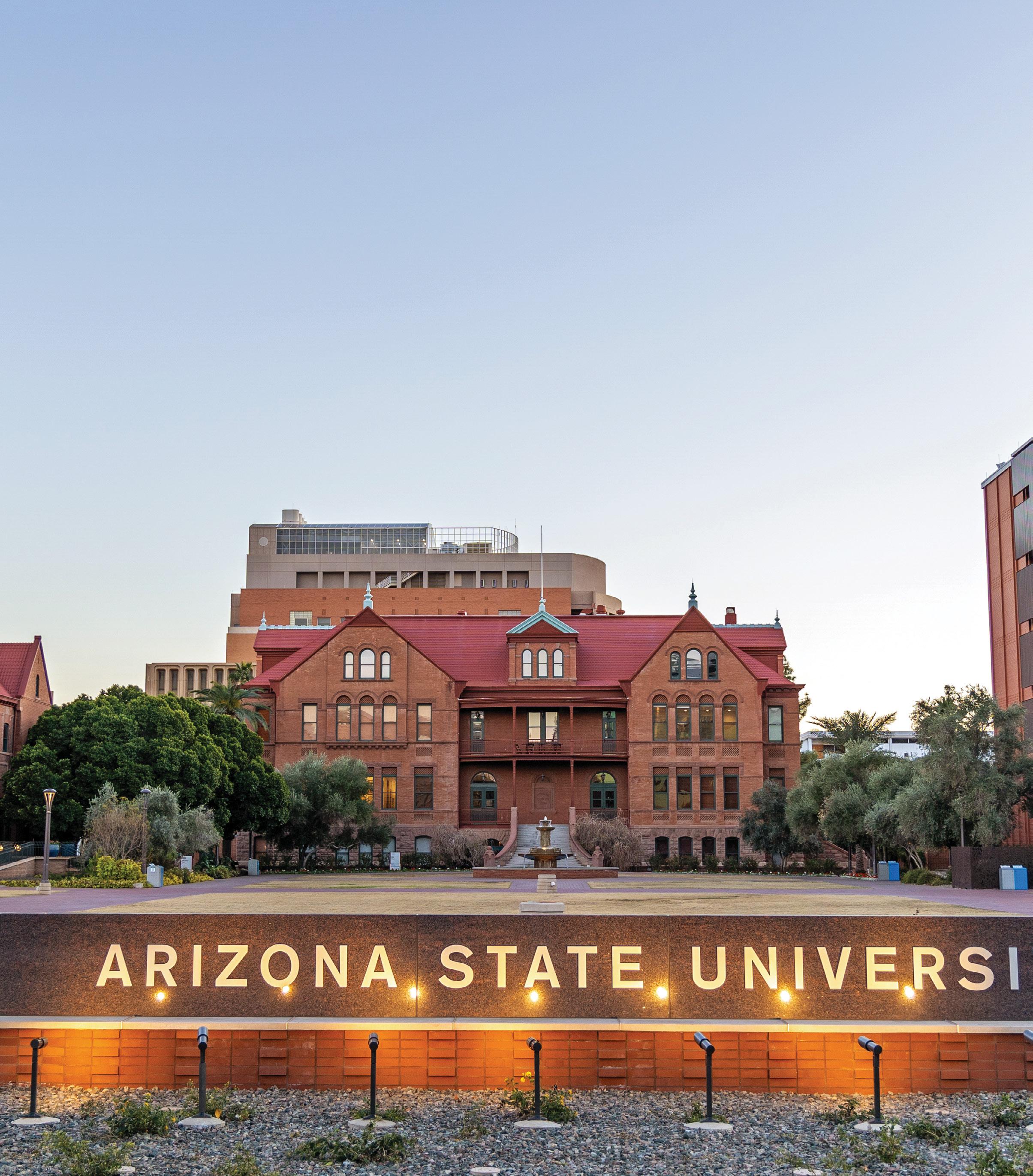
The student body that could Page 54
ASU THRIVE MAGAZINE 53 SABIRA MADADY/ASU History
2024 Life Sciences Center C-wing University Club Life Sciences Tower E-wing
Hall
Sciences Building
Durham
Social
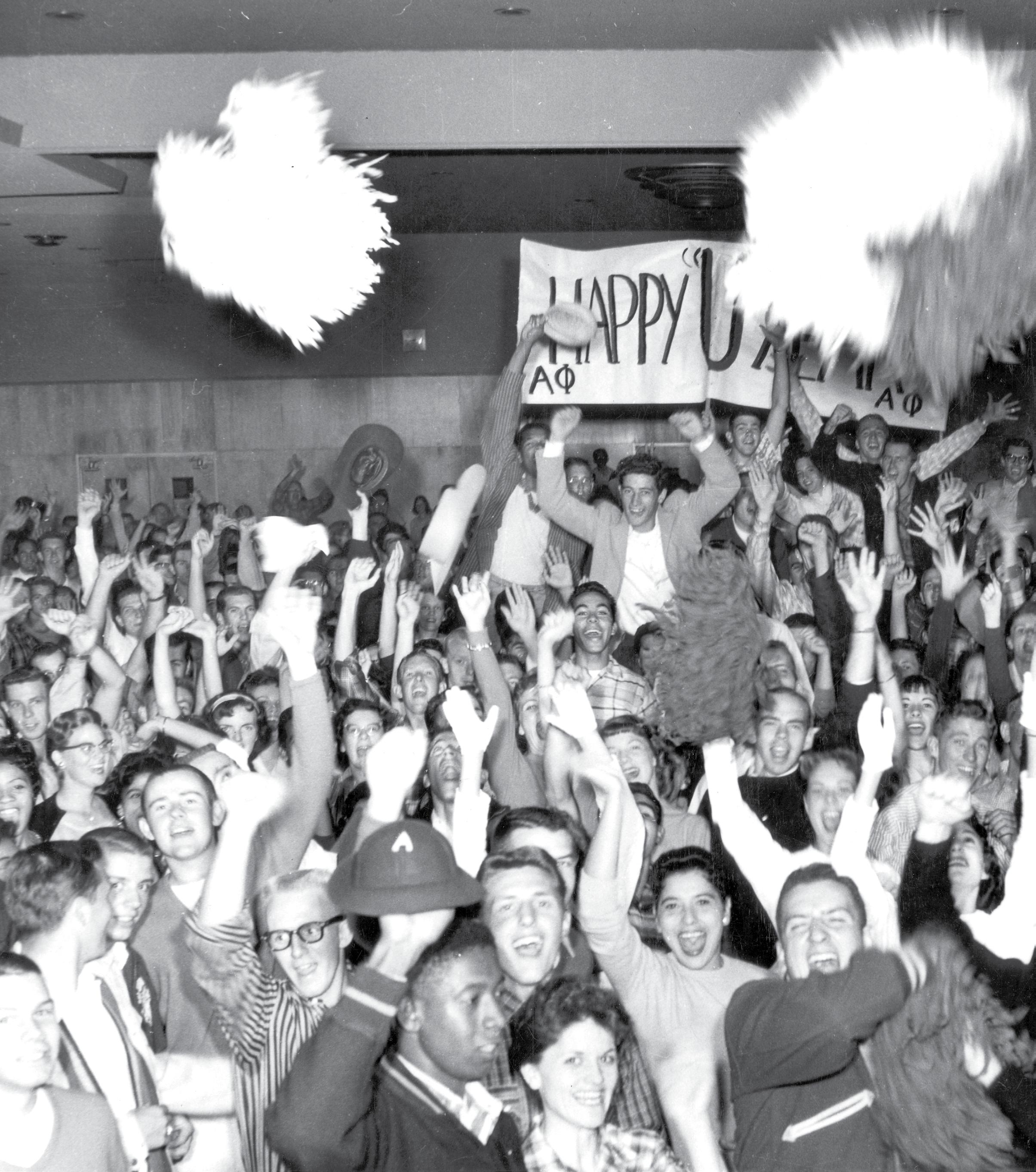
Students celebrate the victory they helped make possible: Arizona College becoming a university.
54 SPRING 2024 HISTORY

student body The could that


To become a university, ASU students had to first win the hearts and minds of an entire state
Story by AMANDA LOUDIN
Back in July 3, 1958, if you were on campus, you would get a sense that something serious was underway, and indeed it was.
Army ROTC students stood in uniform, flanking a set of officiallooking boxes. Inside those boxes resided pages of signatures gathered by ASU students, soon headed to the state building. Once counted, those signatures would pave the way for Arizona State College to become Arizona State University.
Back then, ASU was still Arizona State College, having grown from a small, four-room teaching college into a school that offered multiple degrees by 1945. As the Phoenix area’s population exploded, so too did the college’s enrollment. Arizona was on the radar for

ASU THRIVE MAGAZINE 55 COURTESY OF ASU LIBRARY
many Americans looking for a drier, warmer climate, and of the 50,000 annual transplants in 1951, the majority put down roots in Maricopa County.
As a result, the college saw enrollment grow to over 4,000 by 1954 and nearly 10,000 students by 1958 — a more than doubling in student body size in just four years.
Then, some people, including then school president Grady Gammage, saw the need to transition from a college to a university and began leading the charge for a name change that many others opposed, wanting to keep ASU a college, leaving a single university in Arizona.
Before long, students and local residents took up the call. In 1955, a movement was born.
The push for change
While changing from a college to a university doesn’t seem like a radical idea now, many state leaders at that time opposed it. The University of Arizona was the state’s land grant university, and many influential people believed it should remain its only university.
While one brave regent proposed a name change to the board, the other regents, along with most legislators, many of whom were UArizona alumni, pushed back, and the motion dropped.
This spurred students and Gammage to push for university status.
“This was something of a national trend at the time,” says ASU’s university archivist Shannon Walker, with a few other state colleges taking steps to do the

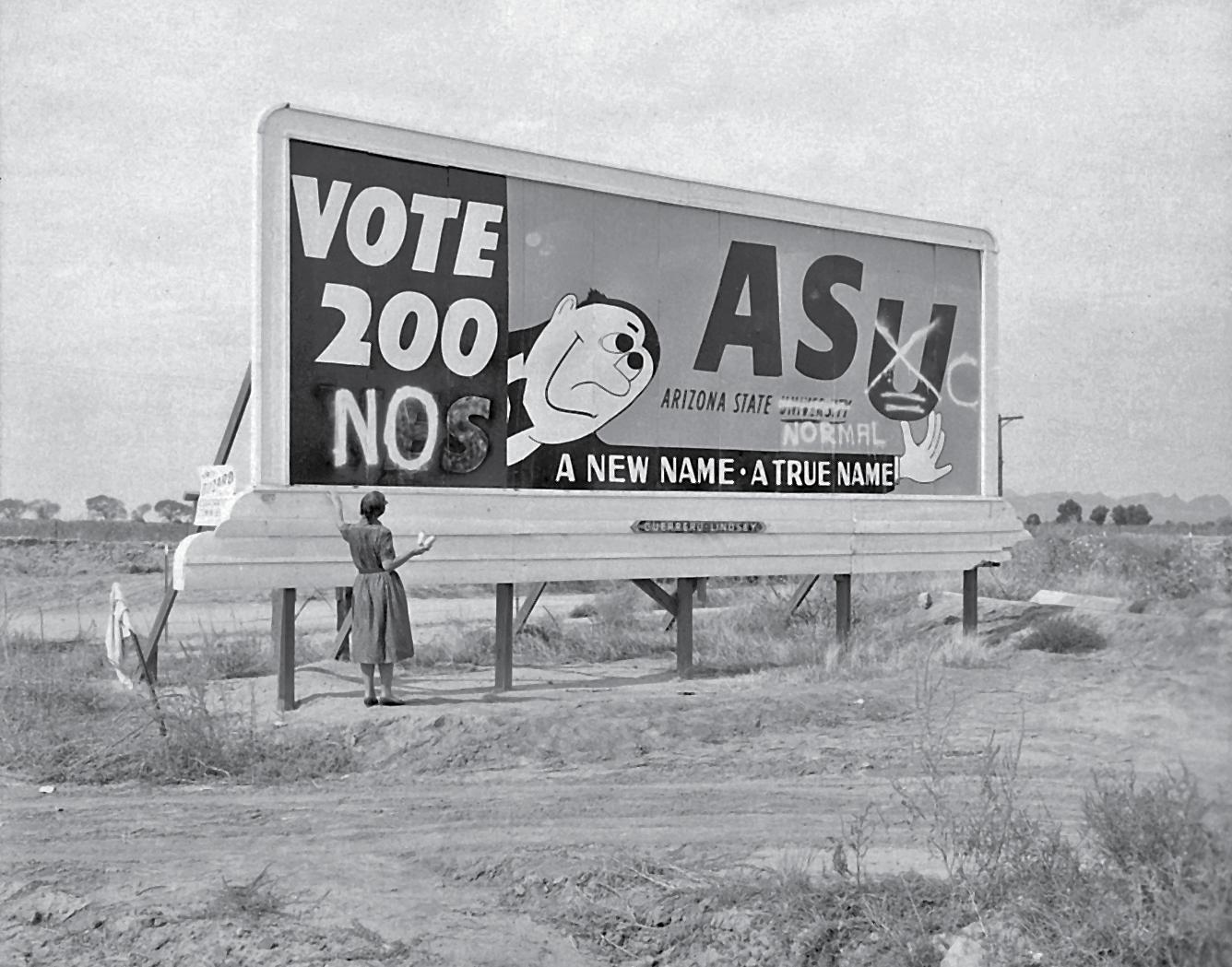

 A vandalized billboard in support of Prop 200 to rename the college to ASU.
Fraternity members protesting outside the Arizona State Capitol.
A vandalized billboard in support of Prop 200 to rename the college to ASU.
Fraternity members protesting outside the Arizona State Capitol.
56 SPRING 2024
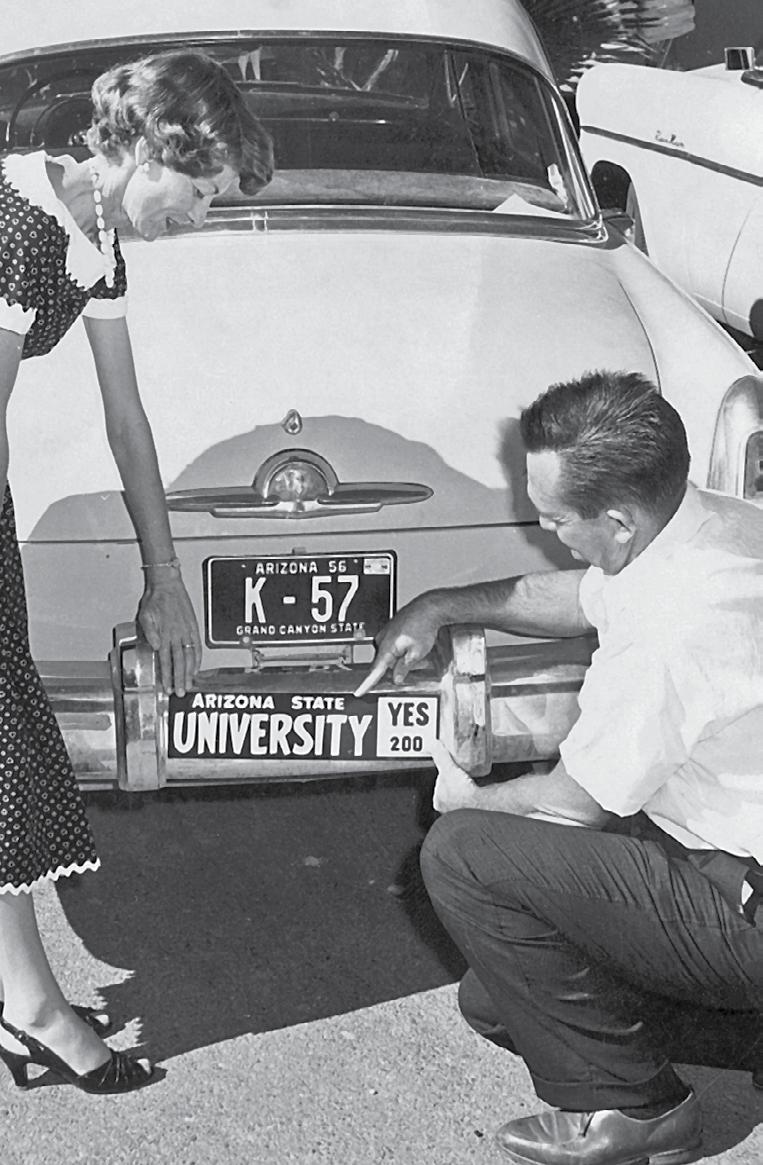

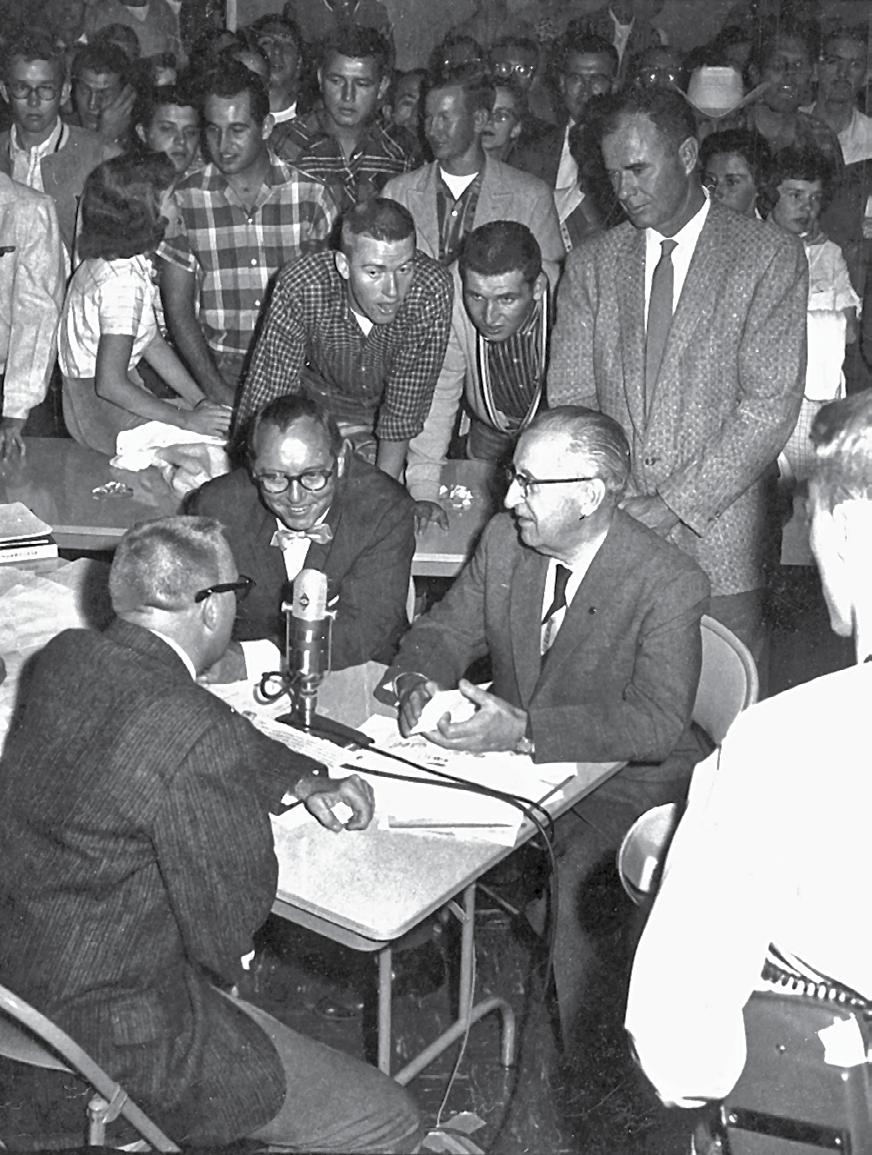

same. Kansas State, for instance, was moving from college to university around the same time.
“The advocates for university status had to figure out if it required approval from the Arizona Board of Regents, the state legislature,” Walker says, “or if there was some other way to approach it.”
A student-led movement
Originally, it was the students’ paper, The State Press, that got the overall student body behind the push for a name change and the push to legitimize ASU. Becoming a university would allow ASU to provide more research opportunities and more undergraduate degree programs, as well as graduate degrees.
“It began with pockets of students in certain programs and grew from there,” says Walker. “I think the opposition coming from UArizona students fed the fire, and ultimately the rivalry, too.
“They felt passionately about this,” Walker says.
Gammage and the students had a report on higher education in their corner too, commissioned by the board of regents. Written by Ernest Hollis, federal director of college and university administration at the time, the report concluded that “the state college at Tempe is rapidly becoming a university. This fact might as well be calmly recognized.”
It also concluded that the college’s nearly 10,000 students “is all the evidence that anyone would want to convince himself that today you are a university.”
The students organized a rally of more than 2,000 students in 1955,
Collecting signatures for the ASU name change.
Four men, including Arizona State President Grady Gammage, speaking into a microphone.
ASU THRIVE MAGAZINE 57
back when they still believed the state legislature would come to see their viewpoint.
Based on intel from legislature members, Gammage felt optimistic a confirming vote wasn’t far off. He encouraged the students to hold tight and wait for a vote in the legislature.
When the vote instead turned into the compromise idea of “Tempe University,” the students took matters largely into their own hands.
“ The rigor is high here, and the type of students going to ASU has changed its reputation. In leading the effort for change, Grady Gammage was a man of vision, well ahead of his time.”
— SHANNON WALKER, ASU UNIVERSITY ARCHIVIST
Part 1: Getting signatures
The students chose to get the question onto a ballot initiative, which became Proposition 200, an official measure to change the school name.
To get the measure onto the ballot, students, alumni and the local Jaycees went door to door collecting signatures. Far outpacing the necessary 29,000 signatures, the joint efforts led to nearly 64,000 residents inking their names in just a few short months with signatures collected by July.
The question of Arizona State College becoming Arizona State
University was going to a statewide vote on Nov. 4, 1958.
Now the students and supporters of the name change had to win over voters across the entire state of Arizona.
Part 2: Campaigning for the “yes” vote
Grady Gammage Jr., only 7 years old in 1958, remembers driving around the state with his mother, Kathryn, to help rally support for the upgrade from a college to a university.
“She was much freer than my father to support the initiative, and it had to be a statewide campaign if it was going to succeed,” he explains. “She was a good speaker and quite charming.”
President Gammage had less room to maneuver and had to walk the fine line of an employee whose bosses — the board of regents and the state legislature — disliked the university idea. But Gammage was skillful at managing that delicate balance, regardless.
“My sense is that my father might have been reluctant to support the initiative at first because he was going against his employers’ directives,” says Gammage Jr. “But he was a good lobbyist and could influence others.”
The battle to win the hearts and minds of voters caught the attention of the entire state of Arizona. Between gathering the needed signatures in July and the November election, debates, both on campuses and off, permeated the landscape.
Meanwhile, down in Tucson, UArizona students mobilized against the pro-university movement.


 President Grady Gammage on the Starlight balcony of the Memorial Union at night as he greets a crowd of students with the election results.
Arizona State students gathered in front of Memorial Union on election night.
President Grady Gammage on the Starlight balcony of the Memorial Union at night as he greets a crowd of students with the election results.
Arizona State students gathered in front of Memorial Union on election night.
58 SPRING 2024



The next chapter of the New American University
Today, ASU’s annual enrollment is over 170,000 students. ASU is widely known as the nation’s “most innovative university,” based on the ranking from U.S. News & World Report nine years running. With a globally recognized honors college and the largest engineering school in the nation, ASU has placed above some of the most esteemed universities in the world in rankings related to global impact, sustainability, innovation and more.
This is all part of the New American University, ASU’s prototype for the American public research university. It’s rooted in the original social contract that a university would provide open access and opportunities to the many gifted students who do not conform to an elite university’s academic profile, as well as to qualified students who lack the financial resources for college.
“Public higher education in the United States during the 20th century produced a level of educational achievement unmatched anywhere in the world,” says ASU President Michael M. Crow.
“Today, the broad accessibility to quality higher education that could once be taken for granted is no longer available to the majority of academically qualified learners. This exclusion frequently deprives individuals from achieving their potential and impoverishes our society,” Crow says. “The shortfall
Vandalism was in play, too, when someone burned some of the grass in Arizona State College’s newly constructed football field.
“The rivalry was strong and surprising,” says Walker. “Why couldn’t the state have two strong universities?”
When election day finally arrived, Gammage and the student body had an hour of panic. At first it looked like Proposition 200 had failed.
Instead, Prop 200 passed overwhelmingly, 101,881 in favor and 51,471 against with a high voter turnout of 72%, according to Barrett, The Honors College faculty
of a highly educated citizenry threatens our national security and prosperity.”
Higher education must not be limited to merely producing more college graduates, he adds.
“College-educated individuals with advanced skills equal to the demands of the knowledge economy are vital to solving the complex challenges we as a society face and to our national economic competitiveness.”
— MICHAEL M. CROW, ASU PRESIDENT
ASU has changed education in Arizona, across the nation and around the world, creating a replicable and scalable model for other public research universities. In fact, it has created the University Design Institute, which has worked with 77 institutions across 20 countries to support their transformation too. Helping to ensure that the state, the country and the world attain a thriving future is the ultimate goal of the New American University, and one ASU is committed to with all of its resources.
Learn more at newamericanuniversity.asu.edu .
member Stephanie R. deLusé and Denise Bates, co-authors of “The Campus History Series: Arizona State University.”
It was the first time in national history that a university had been named under such circumstances, according to the book.
“It happened because of a whole new level of student engagement, still inspiring in so many ways,” Walker says.
Today, in a world where unity sometimes feels elusive, a look back at that special moment in time demonstrates that pulling together offers a path to greatness. ��
Make a change in the world Learn more at changemaker. asu.edu
ASU THRIVE MAGAZINE 59

Tennis’ Cassone helps Team USA win championship
Dominant singles play by junior Murphy Cassone helped cinch Team USA’s victory in the 2023 Master’U BNP Paribas Championship in France. “The World Event of University Tennis” pitted national teams in a whirlwind, three-round tournament. Team USA and the International Tennis Association chose Cassone because of his outstanding 2022 year of Sun Devil tennis when he went undefeated in the Pac-12 and earned ITA Rookie of the Year.
Follow tennis at thesundevils.com .
NO. 1
60 SPRING 2024
Sports
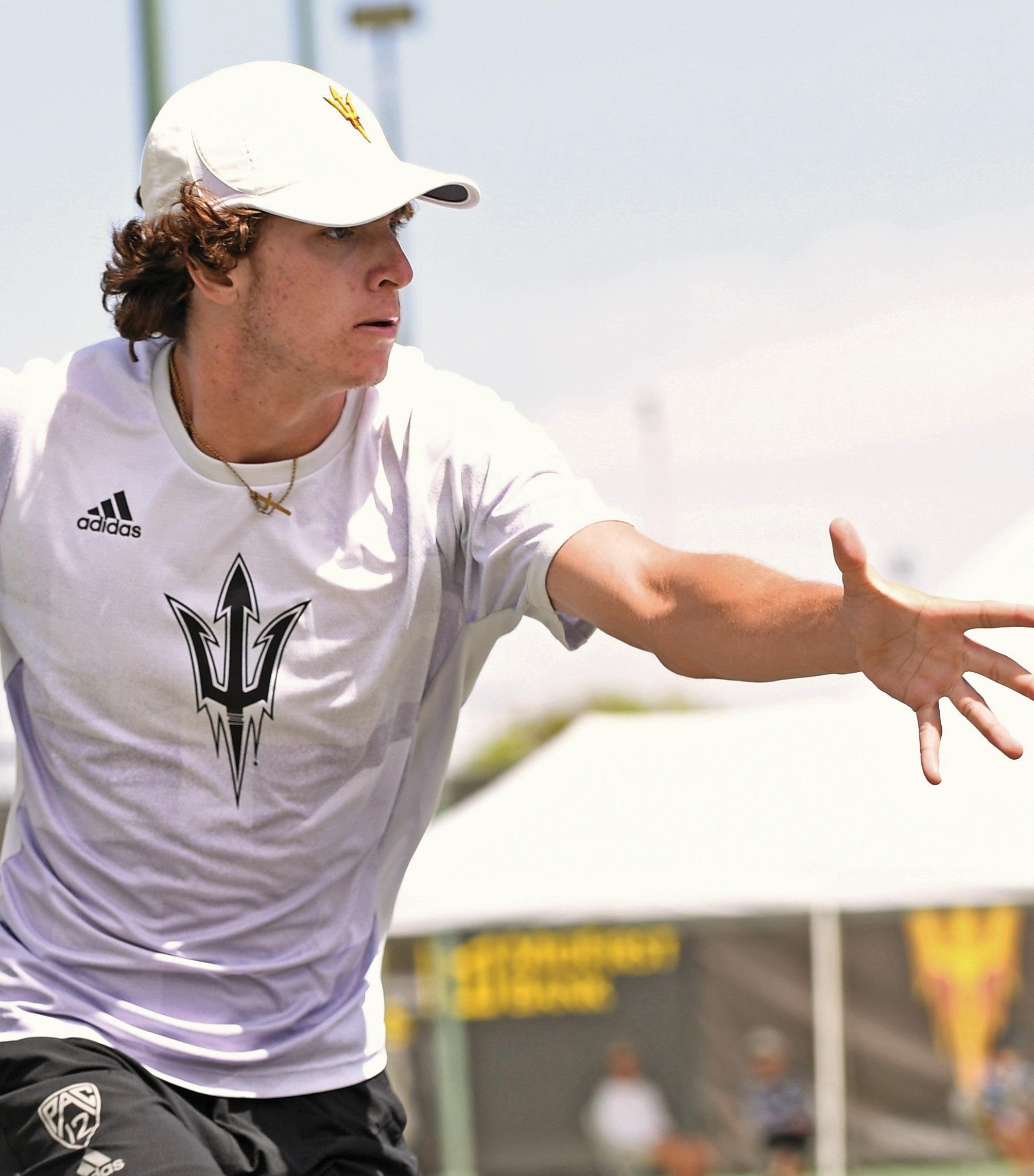
Page 62
Studentathletes’ academic success stats
Page 63
MIA JONES/ASU ASU THRIVE MAGAZINE 61
Sun Devil qualifies for LPGA tour
Football player graduates 37 years after first starting
In fall of 1986, Ted Friedli, ’23 BS in sociology, started classes at ASU while playing football. Three years in as a Sun Devil student-athlete, injuries and academic challenges sidelined his college plans. But in 2019, he learned about Sun Devils for Life, which gives former student-athletes a second chance at college.
“Because there is a 30-year gap between my last semester as a student in 1990, and returning to school in 2020, the main thing I have learned as a student is to trust myself and to be OK with how I learn,” he says. “I learn differently than most people and now I embrace that difference.”
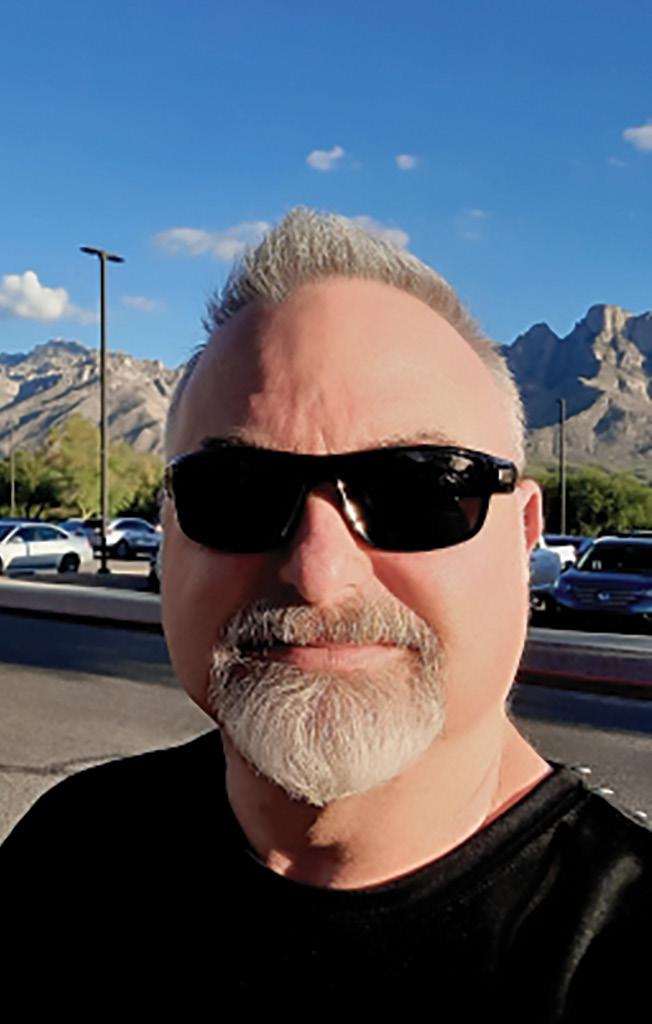

Sun Devil qualifies for LPGA tour
Sun Devil Women’s Golf alumna Alexandra Forsterling, ’22 BA in interdisciplinary studies, qualified for the LPGA and Ladies European Tours. She earned the opportunity to compete at the highest level of women’s professional golf thanks to her top-45 finish in the “Q-School,” the LPGA’s competitive process to determine the next group of LPGA members.
“We are all so proud of Lexi and her phenomenal year,” says ASU Women’s Golf Head Coach Missy Farr-Kaye. “She is an amazing young woman, and we are thrilled to watch her dreams come true through her hard work and determination. Next year, it will be great to follow her on both professional tours!”
Other ASU alumni in the LPGA include Anna Nordqvist; Carlota Ciganda; Linn Grant; Azahara Muñoz, ’09 BA psychology; Linnea Strom; Roberta Liti, ’18 BA business; and Giulia Molinaro, ’12 BS tourism development and management.
Learn more at thesundevils.com/sports/womens-golf.
CONNOR SMITH 62 SPRING 2024 SPORTS
Former football player Ted Friedli finished his degree after 30 years.
D-Back named National League Rookie of the Year
Arizona Diamondbacks outfielder and ASU Online student Corbin Carroll was named National League Rookie of the Year for 2023 by the Baseball Writers’ Association of America.
BBWAA’s selection of Carroll was unanimous, bolstered by the strength of a season that included his selection as an All-Star and made him the first player in MLB history with at least 25 homers, 10 triples, 30 doubles and 50 stolen bases in the same season.
Carroll enrolled as an ASU Online student during MLB’s 2020 cancellation season and expects to graduate in May with a BS degree in finance.

Wrestling’s Kaleb Larkin qualifies for ’24 Olympic trials
Kaleb Larkin was the youngest wrestler to win his bracket at the 2023 Bill Farrell Memorial International in New York in November. Larkin, a computer science major, defeated Matthew Kolodzik, the four-time All-American wrestler from Princeton in the finals match.
At 20 years old, the Sun Devil first-year student captured his first senior-level international event and punched his ticket to the ’24 U.S. Olympic Trials. The trials will be hosted by Pennsylvania State University on April 19–20.
Follow along at thesundevils.com/ sports/wrestling .
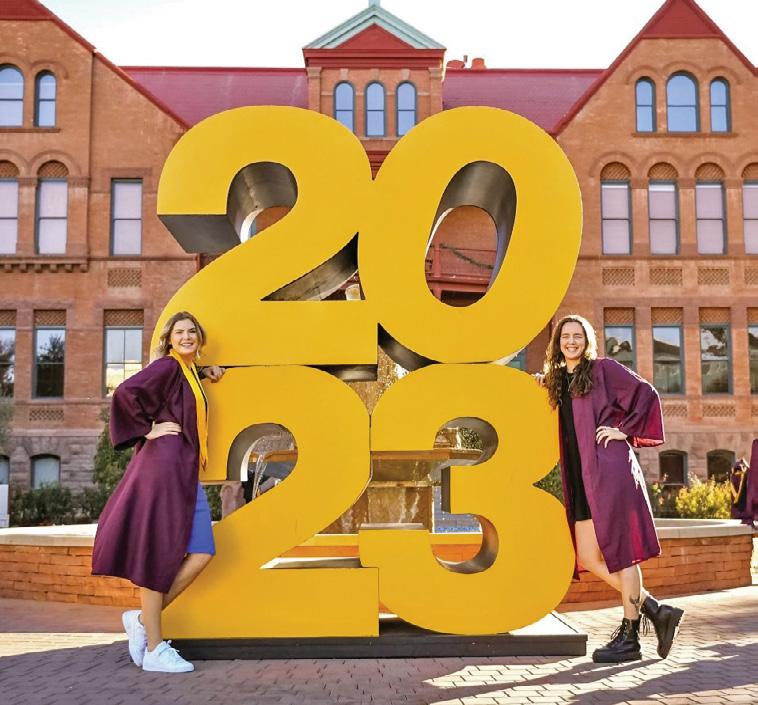
Student-athletes’ fall 2023 academic success
At the end of the fall 2023 semester, 28 student-athletes graduated. Of these, 13 graduated with honors, including six summa cum laude (3.80–4.00 GPA), three magna cum laude (3.60–3.79), and four cum laude (3.40–3.59). Three of the student-athletes graduated from Barrett, The Honors College.
Additionally, last year, Sun Devil Athletics earned a new all-time high of 93% Graduation Success Rate for its student-athletes. Sun Devil Athletics has either maintained or surpassed its all-time best GSR every year since 2008 and is third in the Pac-12 Conference. Thirteen teams posted GSR scores at 100%: men’s and women’s basketball, beach volleyball, men’s and women’s golf, gymnastics, lacrosse, soccer, women’s swimming and diving, men’s and women’s tennis, water polo and wrestling.
GSR is the NCAA’s primary tool for measuring academic success in Division I athletics. It’s designed to show the proportion of student-athletes on any team who earn a college degree.
ASU ATHLETICS ASU THRIVE MAGAZINE 63
ASU Online student Corbin Carroll, who plays outfield for the Diamondbacks and will graduate in May with a finance degree.
INNOVATION
Training students for in-demand careers
Forty years ago, construction at ASU’s campus between north Phoenix and Glendale broke ground. Today, ASU West Valley offers over 125 degree programs and is home to three new ASU schools: the School of Technology, Innovation and Entrepreneurship; the School of Interdisciplinary Forensics; and the School of Integrated Engineering. The expansion is critical to the region, where much of the Valley’s biggest new investments and growth are happening.
The new School of Integrated Engineering in the Ira A. Fulton Schools of Engineering offers a Bachelor of Science in engineering science. In this flexible degree program, students get a foundation in math, science and engineering that they can pair with a specialization in their chosen concentration. This program is the first of its kind; it’s offered by the largest engineering school in the U.S. and available only at the West Valley campus.
Learn more at asu.edu/west-valley.

“The idea is that it would offer different flavors of engineering science that will give students specialized advanced skills that high-tech industries are seeking.”
— JEREMY HELM, THE FULTON SCHOOLS SENIOR DIRECTOR OF ACADEMIC AND STUDENT AFFAIRS
ASU West Valley today.
64 SPRING 2024 SAMANTHA CHOW/ASU VIEW


Arizona State University, ASU Thrive Magazine PO Box 875011, Tempe, AZ 85287-5011























































































































































 A vandalized billboard in support of Prop 200 to rename the college to ASU.
Fraternity members protesting outside the Arizona State Capitol.
A vandalized billboard in support of Prop 200 to rename the college to ASU.
Fraternity members protesting outside the Arizona State Capitol.






 President Grady Gammage on the Starlight balcony of the Memorial Union at night as he greets a crowd of students with the election results.
Arizona State students gathered in front of Memorial Union on election night.
President Grady Gammage on the Starlight balcony of the Memorial Union at night as he greets a crowd of students with the election results.
Arizona State students gathered in front of Memorial Union on election night.











